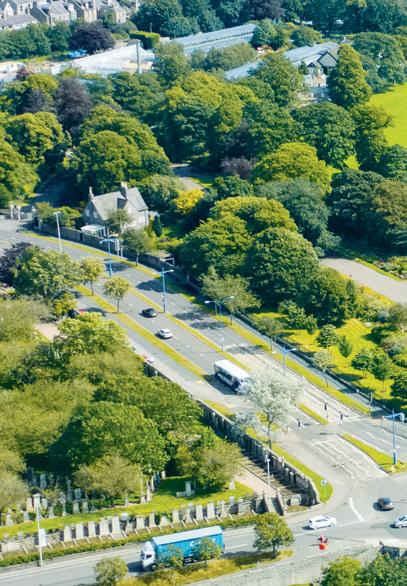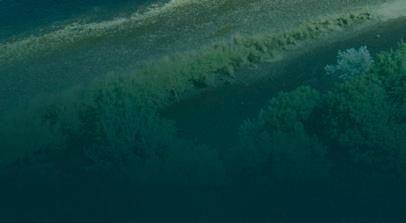VOLUME 43 I ISSUE 11 I NOVEMBER 2025

SPECIAL TOPIC

VOLUME 43 I ISSUE 11 I NOVEMBER 2025

SPECIAL TOPIC
EAGE NEWS NSG 2025 breaks records
CROSSTALK Palestine’s energy dream
TECHNICAL ARTICLE Tilt and orientation values for OBNs















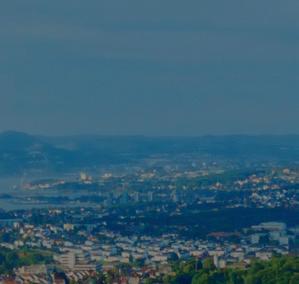










































LUKAS MOSSER










“Has there ever been a more exciting time to engage with digital technology in the geosciences? Artificial intelligence is delivering real-world impact, transforming not only our industries but also reshaping the landscape of digital technology itself. Today’s innovations in data management, computational techniques, and collaborative partnerships are fundamentally changing the ways we work and drive progress. As the Technical Committee Chair, I invite you to seize this unique opportunity and submit your presentations to the Technical Program at the EAGE Digital 2026 in Stavanger, Norway.”
Aker BP ASA Chair, EAGE DIGITAL 2026 Technical Committee










FIRST BREAK ®
An EAGE Publication www.firstbreak.org
ISSN 0263-5046 (print) / ISSN 1365-2397 (online)
CHAIR EDITORIAL BOARD
Clément Kostov (cvkostov@icloud.com)
EDITOR Damian Arnold (arnolddamian@googlemail.com)
MEMBERS, EDITORIAL BOARD
• Philippe Caprioli, SLB (caprioli0@slb.com) Satinder Chopra, SamiGeo (satinder.chopra@samigeo.com) Anthony Day, NORSAR (anthony.day@norsar.no)
• Peter Dromgoole, Retired Geophysicist (peterdromgoole@gmail.com)
• Kara English, University College Dublin (kara.english@ucd.ie)
• Hamidreza Hamdi, University of Calgary (hhamdi@ucalgary.ca)
• Fabio Marco Miotti, Baker Hughes (fabiomarco.miotti@bakerhughes.com)
• Roderick Perez Altamar, OMV (roderick.perezaltamar@omv.com)
• Susanne Rentsch-Smith, Shearwater (srentsch@shearwatergeo.com)
Martin Riviere, Retired Geophysicist (martinriviere@btinternet.com)
• Angelika-Maria Wulff, Consultant (gp.awulff@gmail.com)
EAGE EDITOR EMERITUS
Andrew McBarnet (andrew@andrewmcbarnet.com)
PUBLICATIONS MANAGER
Hang Pham (publications@eage.org)
MEDIA PRODUCTION
Saskia Nota (firstbreakproduction@eage.org) Ivana Geurts (firstbreakproduction@eage.org)
ADVERTISING INQUIRIES corporaterelations@eage.org
EAGE EUROPE OFFICE
Kosterijland 48
3981 AJ Bunnik
The Netherlands
• +31 88 995 5055 eage@eage.org
• www.eage.org
EAGE MIDDLE EAST OFFICE
EAGE Middle East FZ-LLC Dubai Knowledge Village PO Box 501711
Dubai, United Arab Emirates
• +971 4 369 3897
• middle_east@eage.org
• www.eage.org
EAGE ASIA PACIFIC OFFICE
EAGE Asia Pacific Sdn. Bhd.
UOA Centre Office Suite 19-15-3A No. 19, Jalan Pinang 50450 Kuala Lumpur
Malaysia
• +60 3 272 201 40
• asiapacific@eage.org www.eage.org
EAGE LATIN AMERICA OFFICE
EAGE Americas SAS Av Cra 19 #114-65 - Office 205 Bogotá, Colombia
• +57 310 8610709 americas@eage.org
• www.eage.org
EAGE MEMBERS’ CHANGE OF ADDRESS
Update via your MyEAGE account, or contact the EAGE Membership Dept at membership@eage.org
COPYRIGHT & PHOTOCOPYING © 2025 EAGE
All rights reserved. First Break or any part thereof may not be reproduced, stored in a retrieval system, or transcribed in any form or by any means, electronically or mechanically, including photocopying and recording, without the prior written permission of the publisher.
PAPER
The publisher’s policy is to use acid-free permanent paper (TCF), to the draft standard ISO/DIS/9706, made from sustainable forests using chlorine-free pulp (Nordic-Swan standard).

Energy firms accelerate E&P with unified approaches to seismic data
25 Estimating tilt and orientation values for ocean bottom nodes with Differential Evolution stochastic search algorithm
Shashi Kumar
35 Shear-wave velocity model building and PS-wave imaging: case study in Santos Basin, Brazil
Marcella Rapini Braga, Gilberto Rodrigues de Lima, Bruno Chaves Moreira Gomes, Moacyr de Souza Bezerra, Danilo Santos Cruz and Andrea Carvalho Damasceno
43 Overcoming accessibility and logistics challenges: Integrating MBES and SSS with UAVs
Alexey Dobrovolskiy
49 Deep Upper Jurassic play evaluation in the Southern Viking Graben using cost-effective multi-azimuth streamer technology
Eric Mueller, Martin Widmaier and Julien Oukili
55 From highlands to hydrocarbons: Tracing reservoir quality in Uruguay and southern Brazil’s offshore frontier basins
Josefina Marmisolle, Bruno Conti, Pablo Rodriguez, Karyna Rodriguez and Neil Hodgson
63 Energy firms accelerate E&P with unified approaches to seismic data
Ian Setterfield
69 Triple-source seismic acquisition operations with a Tuned Pulse Source (TPS)
Julien Large, Shuki Ronen, Paul Wentzler, Maxime Benaniba and Jeremy Aznar
75 Modern case study demonstrations of the industry value of PS-wave data
Ali Tura, Roman Yermakov, Ole Edvard Aaker, Ørjan Pedersen, Andrea Damasceno, Marcella Rapini Braga, Sarah Lim Suet Hoey, Lokesh Ambati, Nurul Nadzirah A Rahman, Sandeep Kumar Chandola, Ahmad Riza Ghazali, M Firdaus A Halim and Bjorn Olofsson
86 Calendar
cover: Sercel’s Tuned Pulse Source (TPS) – a broadband source that enhances lowfrequency content, supports eco-conscious exploration and improves operational safety (image courtesy of Sercel).



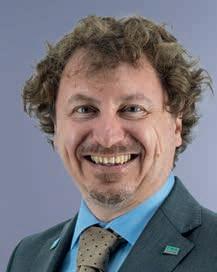






Environment, Minerals & Infrastructure Circle
Andreas Aspmo Pfaffhuber Chair
Florina Tuluca Vice-Chair
Esther Bloem Immediate Past Chair
Micki Allen Liaison EEGS
Martin Brook Liaison Asia Pacific
Ruth Chigbo Liaison Young Professionals Community
Deyan Draganov Technical Programme Representative
Madeline Lee Liaison Women in Geoscience and Engineering Community
Gaud Pouliquen Liaison Industry and Critical Minerals Community
Eduardo Rodrigues Liaison First Break
Mark Vardy Editor-in-Chief Near Surface Geophysics
Oil & Gas Geoscience Circle
Johannes Wendebourg Chair
Timothy Tylor-Jones Vice-Chair
Yohaney Gomez Galarza Immediate Past Chair
Alireza Malehmir Editor-in-Chief Geophysical Prospecting
Adeline Parent Member
Jonathan Redfern Editor-in-Chief Petroleum Geoscience
Robert Tugume Member
Anke Wendt Member
Martin Widmaier Technical Programme Officer
Sustainable Energy Circle
Giovanni Sosio Chair
Benjamin Bellwald Vice-Chair
Carla Martín-Clavé Immediate Past Chair
Emer Caslin Liaison Technical Communities
Sebastian Geiger Editor-in-Chief Geoenergy
Maximilian Haas Publications Assistant
Dan Hemingway Technical Programme Representative
Carrie Holloway Liaison Young Professionals Community
Adeline Parent Liaison Education Committee
Longying Xiao Liaison Women in Geoscience and Engineering Community
Martin Widmaier Technical Programme Officer
SUBSCRIPTIONS
First Break is published monthly. It is free to EAGE members. The membership fee of EAGE is € 85.00 a year including First Break, EarthDoc (EAGE’s geoscience database), Learning Geoscience (EAGE’s Education website) and online access to a scientific journal.
Companies can subscribe to First Break via an institutional subscription. Every subscription includes a monthly hard copy and online access to the full First Break archive for the requested number of online users.
Orders for current subscriptions and back issues should be sent to First Break B.V., Journal Subscriptions, Kosterijland 48, 3981 AJ Bunnik, The Netherlands. Tel: +31 (0)88 9955055, E-mail: subscriptions@eage.org, www.firstbreak.org.
First Break is published by First Break B.V., The Netherlands. However, responsibility for the opinions given and the statements made rests with the authors.

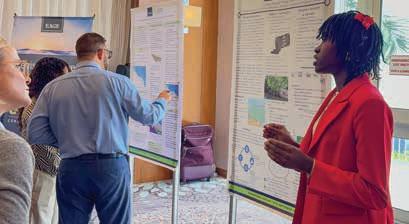

The EAGE Annual 2026 is already shaping up to be a rich programme, with a diverse set of workshops proposed to tackle today’s pressing geoscience and energy challenges. While still in the proposal stage, the topics give a strong sense of the themes and conversations that will energise next year’s event.
One highlight is the Core Workshop – An overview of the most important North Sea reservoirs . The North Sea’s geology is famously complex, and this workshop promises an overview of the region’s most important cores, showcasing both classic and more niche reservoirs. For anyone working in or studying this prolific basin, it’s a chance to see and discuss the real rocks that underpin the region’s energy story.
Another highlight is the OBS acquisition productivity and efficiency workshop, exploring how next-generation OBS systems, robotics and AI are improving offshore seismic operations. Exploring the limits of gas saturation measurement examines how seismic techniques can better distinguish residual from commercial gas accumulations. Wavefield complexity: use or lose investigates why imaging algorithms struggle to use the full wavefield and how data and modelling can close the gap. Improving subsurface decision quality introduces methods to reduce
bias and strengthen forecasting. The AI agents workshop looks at how agentic systems are reshaping workflows and automation. Sampling at the philosophical crossroads weighs dense acquisition against smarter reconstruction methods, while the VSP & wireline technology session showcases new CCUS and oil and gas tools with a live demo at SLB’s Kirkhill base.
Several workshops will address the latest frontiers in seismic imaging and inversion, from leveraging OBN acquisitions for PP-PS imaging and inversion, to reflectivity and its role in inversion workflows, and advances in passive seismic interferometry. Land FWI also takes the spotlight in When will land FWI catch up? , a timely discussion given the recent breakthroughs in onshore applications.
On the CCS side, proposals include a workshop on CCS monitoring strategies, which will cover technologies, challenges and lessons learned from pilot projects and operational sites around the world. Another, Maximising subsurface recovery , looks more broadly at how integrated subsurface characterisation and engineering can improve performance in hydrocarbons, geothermal and energy storage.
Beyond the technical, a Seismic and site investigation safety forum will
provide space to share experiences and lessons to improve safety performance across the industry.
From deep technical dives to big-picture perspectives, the proposed workshops illustrate the breadth and relevance of the discussions ahead. They promise to connect disciplines, regions and industries as the energy sector continues to navigate change.
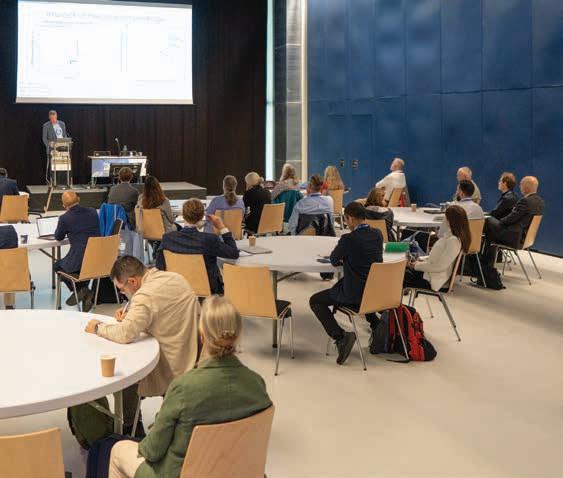
Whether your focus is subsurface imaging, CCS, digitalisation or exploring the future of energy systems, there will be a session to spark new ideas and strengthen your expertise.
Mark your calendars now and keep an eye on www.eageannual.org for the confirmed programme and updates.
Report on 32nd International Meeting on Organic Geochemistry (IMOG 2025) which took place in Porto, Portugal, from 7–11 September, hosted by the European Association of Organic Geochemistry with support from EAGE.



The conference drew around 500 delegates, featuring more than 80 oral presentations and 300 posters across themes spanning the full breadth of organic geochemistry and its applications. Topics discussed included understanding paleoclimate, methane emissions, microplastics, petroleum formation, lipids biosynthesis in ocean, soils, and sediment, and the use of latest analytical and data mining techniques.
As in previous editions, the meeting honoured excellence in organic geochemistry through the Geoff Eglinton Presentation, this time the work of Felix Elling unlocking the role of quinones in the evolution of aerobic respiration. Other recognitions included the Treib’s award to early-career researcher Cindy De Jonghe, numerous student awards for best presentations at the IMOG conference as
well as the EAOG and Elsevier Research awards.
Career achievements were recognised with two Geochemical Society awards. The John Hayes award was earned by Paula Welander for her work on lipid biosynthetic pathways and their reflection of Earth systems. Ellen Hopmans was awarded the community’s highest distinction, the Treib’s medal, for her instrumental achievements expanding the classes of detectable molecules leading to the development of transformative new proxies and a deeper understanding of Earth’s past and present.
Networking was a central feature of IMOG 2025. Delegates engaged through poster sessions, exhibition floor discussions and social events set against Porto’s riverfront and cultural venues. Dedicated events for early-career researchers encour-
aged interaction with senior colleagues, while the exhibition created opportunities to exchange knowledge with industry providers and service companies.
IMOG 2025 affirmed its role as a leading forum for advancing organic geochemistry in both academic and industrial contexts. With its blend of technical exchange, professional networking and recognising excellence across all career stages, the IMOG meeting continues to highlight the relevance of organic geochemistry in addressing the challenges of energy, environment and climate.
Looking ahead, the next IMOG will take place in 2027 in Rotterdam, The Netherlands. Dates are not yet confirmed, so please keep an eye on www.imogconference.org for updates on the timeline, call for abstracts and practical information.
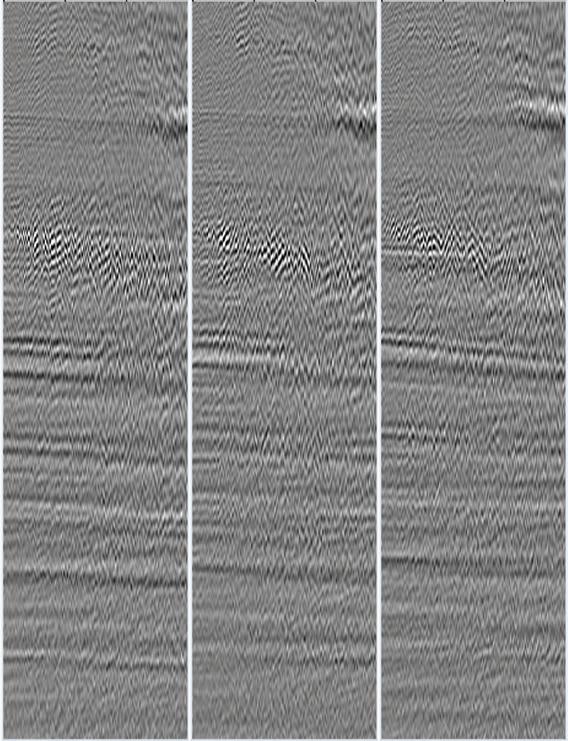

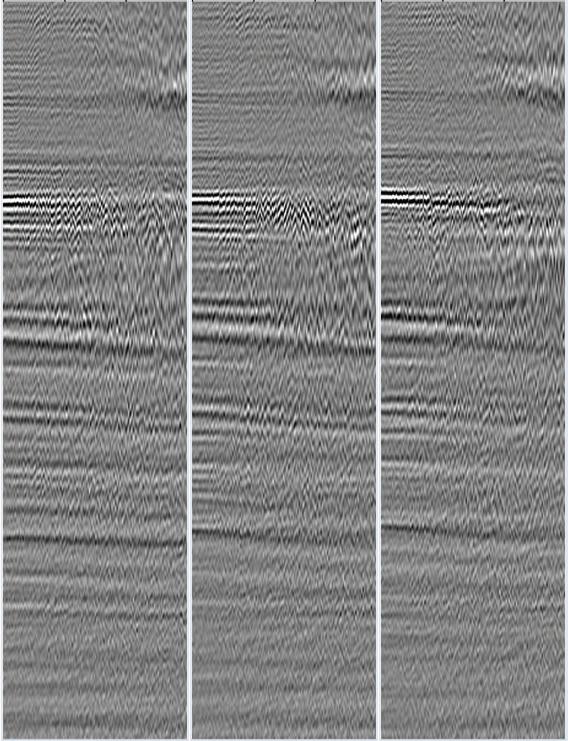



The Earth is inherently elastic. Using superior physics, DUG Elastic MP-FWI Imaging delivers a significant kinematic improvement and a reduction of azimuthal jitter, particularly around the high-impedance contrasts given by the carbonates in this onshore, desert setting.
It’s a complete replacement for traditional processing and imaging workflows!
info@dug.com | dug.com/fwi
Near Surface Geophysics journal is calling for submissions for forthcoming special issues aimed at enhancing the understanding of the geophysics and environmental science fields, with a focus on both innovation and practical applications.
Machine learning for nearsurface geophysics
Machine learning (ML) is transforming near-surface geophysics by enabling advanced solutions for complex subsurface problems across methods such as seismic, GPR and ERT. This special issue presents recent developments in ML-based modelling, inversion, classification and monitoring aimed at understanding shallow subsurface systems. Submissions are invited on innovative ML approaches for solving forward and inverse problems, processing and interpreting large-scale datasets, and integrating ML with conventional geophysical techniques. Real-world applications in environmental and engineering geophysics are also encouraged. The goal is to showcase both theoretical advances and practical implementations that push the boundaries of near-surface geophysical research.
Submission deadline: 31 December 2025
Launched to celebrate the 10th anniversary of the Italian Association of the Ground Penetrating Radar (GPR), this special issue invites contributions from researchers, professionals and manufacturers working in GPR, near-surface geophysics and integrated prospecting. The issue provides a platform for sharing recent scientific advances, technological developments and field applications, while also addressing current limitations and open questions in the use of these methods. Topics of interest include novel GPR techniques, multi-method geophysical surveys and practical case studies. Contributions that highlight both theoretical perspectives and real-world challenges in near-surface investigations are strongly encouraged. Submission deadline: 28 February 2026
Submission guidelines
Geo-disaster reduction under extreme climate
This special issue focuses on geo-disaster reduction in the context of extreme climate conditions, addressing the rising risks of landslides, collapses and mining-related hazards. As climate change intensifies extreme weather events, there is an urgent need for innovative, multi-disciplinary strategies. The issue invites contributions on the impact of climate change on geo-disaster frequency, early warning systems, resilient infrastructure, technological advances and policy responses. Submissions may also include case studies and best practices from around the world. By integrating science, technology and governance, this issue aims to support global efforts toward disaster resilience and sustainable development.
Submission deadline: 31 March 2026
Submission to Near Surface Geophysics journal is free-of-charge. To prepare your manuscript, please refer to the author guidelines published on the journal website or scan the QR code. When submitting your manuscript, make sure to identify the special issue by answering the question “Is this submission for a special issue?” by selecting the special issue title from the drop-down list.
19 NOV GEOTHERMAL RESERVOIR ENGINEERING OF ENERGY PRODUCTION, BY DENIS VOSKOV
20 NOV NEW TRENDS IN BOREHOLE GEOPHYSICS FOR GEOTHERMAL EXPLORATION AND DEVELOPMENT, BY SEBASTIEN SOULAS
OF GEOTHERMAL ENERGY MASTERCLASS

A record-breaking 700-plus delegates attended this year’s Near Surface Geoscience Conference and Exhibition 2025 in Naples featuring five parallel conferences making it the most successful event in the series to date. We report on the feedback.

All the feedback suggests that this year’s NSG 2025 in Naples was a big success with record numbers attending.
The event featured conference topics on Environmental and Engineering Geophysics, Mineral Exploration and Mining, Infrastructure Planning, Monitoring and BIM, Geohazards Assessment and Risk Mitigation, and UXO and Object Detection, highlighting a diverse range of topics in the near-surface industry. Additionally, 48 exhibitors representing a broad spectrum of geoscience technologies and services. Three workshops and one short course were part of the programme, designed to discuss in depth some of the latest advances in near-surface geoscience. Lastly, five unforgettable field trips allowed participants to immerse themselves in regional geological and archeological sites.
Naples proved to be a remarkable host city. With its unique blend of archaeological treasures and geologically rich landscapes, the city provided more than just a venue, it became an extension of the conference itself. Workshops were

enriched by the opportunity to see theoretical discussions come alive in the surrounding sites, creating a valuable link between learning and field exploration. Delegates were asked in a post-event survey to rate their overall experience, 93% stated themselves satisfied or higher. Exhibitors expressed strong satisfaction. In a post-event survey, when asked to rate their overall experience on a scale of 1 to 5, the average score was 4.0. For many, the event offered valuable opportunities to network, strengthen existing relationships and increase visibility within the geoscience and engineering industry. It successfully integrated technical presentations on the latest research developments with meaningful engagement from industry representatives.
NSG 2025 not only set new records in attendance, participation and exhibitors but has built great anticipation and excitement for the next edition among global delegates. NSG 2026 will be held in the beautiful city of Thessaloniki, Greece, on 20-24 September 2026. Mark the date.

‘This event is more than a conference. It’s a platform were the knowledge turns into opportunity. It’s very essential to be here, this is where the science, technology and industry meet to shape the future.’
Giovanni
Ranieri, CEO, Next Geosolutions
‘I meet many different professionals from different disciplines and countries. It was very versatile, accommodating, everyone seems very happy to be here. It was a very nice experience.’
Luke Giordanelli, global manager, Seequent
‘It’s been a very good experience. It’s positive to be here to have a chance to catch up with friends and colleagues and learn about the latest news in the sector.’
Rodrigo del Potro, business development manager, Xcalibur Smart Mapping
‘It’s been very positive. We have attended before but this is our first time exhibiting. It’s been very vibrant.’
Richard Humphreys, business development manager, Ocean Floor Geophysics
‘It was really well organised so it’s really important for any exhibitor, we feel very comfortable and welcome here. The best part is when we can share our products and our knowledge.’
Maria Linneberg, marketing manager, Impulse Radar
‘We are Bachelor students and it’s one of the best experiences I ever had in my academic career.’
Antonios Georgios Tsiftsidis, National Technical University of Athens


The Colombian Association of Energy Geologists and Geophysicists (ACGGP) made a notable contribution to the EAGE Near Surface Geoscience Conference in September in Naples.
Flover Rodríguez-Portillo, ACGGP executive director, participated as a panellist in the Opening Session Geoscience in the public eye: Bridging the gap between science and society for trust, transparency, and impact, where he addressed how to build community trust around geoscientific findings.
Rodríguez-Portillo told the audience: ‘At ACGGP we promote transparency in our findings, translating complex technical knowledge into language that is understandable and useful for decision-makers and communities. Our main point is that geoscientists must communicate not only the ‘what’ and ‘how’ of their work, but also the ‘why’ By engaging in dialogues with local communities, academia, indus-
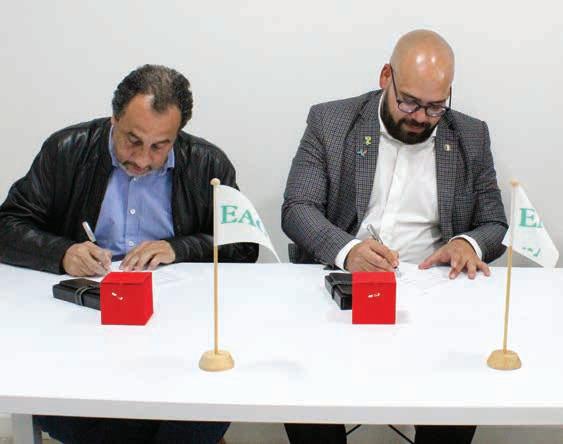
try and government we have demonstrated that geoscience is essential for addressing societal challenges such as climate change, energy co-existence and sustainable land use. This dialogue builds confidence and shows that geoscience is not abstract – it directly impacts people’s lives.’
In addition, Rodríguez-Portillo chaired the technical session Geophysical investigations in soils and agriculture and welcomed the participants in the NSG Talent Trail. During the latter, Rodríguez-Portillo provided advice to young professionals and students emphasising that geoscience is not only about technical excellence but also about social responsibility. ‘Thinking about the well-being of those around us is the most meaningful way geoscientists can contribute to a sustainable future,’ he said.
The ACGGP was also represented at the EAGE Annual in Toulouse where Rodríguez-Portillo presented Dialogue in territories: A path to understanding geothermal energy for sustainable development – Nereidas Valley, Colombia. He noted: ‘Participating in EAGE events is highly relevant for our Association, because this allows us to exchange global visions with a strong regional perspective. This interaction also enriches our understanding and enables us to bring back ideas that support public policy

Rodríguez-Portillo, ACGGP
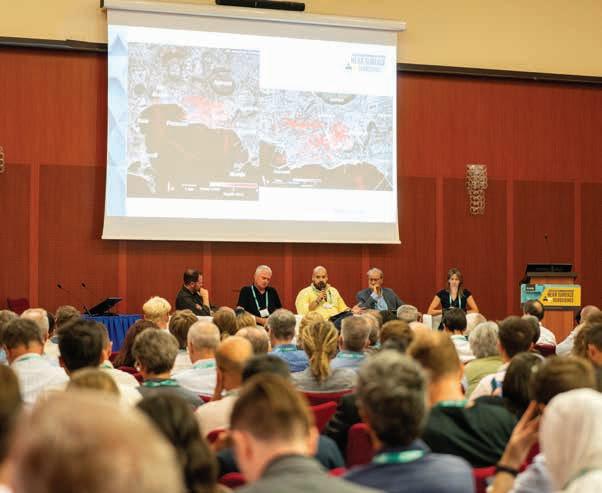
building in Colombia and Latin America, particularly on climate change, energy co-existence and sustainability. It also ensures that our regional realities are visible in the global conversation. Our participation also reflects the commitment we have with our affiliated societies, such as EAGE, to generate mutual value, exchange knowledge, and build joint strategies for the benefit of geosciences.’
On behalf of EAGE, we extend a special thanks to Flover Rodríguez-Portillo and ACGGP. Their active involvement at NSG 2025 made a meaningful contribution to our shared mission of knowledge exchange and collaboration.

Every month we highlight some of the key upcoming conferences, workshops, etc. in the EAGE’s calendar of events. We cover separately our four flagship events – the EAGE Annual, Digitalization, Near Surface Geoscience (NSG), and Global Energy Transition (GET).

1st EAGE Offshore Workshop: Seismic to Simulation
27-29 January 2026 – Kuwait City, Kuwait
Covering the journey from seismic acquisition through to dynamic reservoir simulation and field management, the workshop is designed to foster knowledge exchange, showcase innovation, and tackle the complex challenges of offshore operations until a total of five different themes. The theme, Exploring the frontiers, will explore the region’s recent offshore discoveries, emerging exploration opportunities and innovative approaches shaping the future of offshore energy. With Kuwait’s strategic location and increasing offshore potential, the city serves as the perfect setting to launch this recurring event, making it a must-attend for professionals eager to stay ahead.
Early bird deadline: 5 December 2025

2nd EAGE Workshop on New Discoveries in Mature Basins
28-29 April 2026 – Kuala Lumpur, Malaysia
The workshop takes as its theme that mature basins are far from exhausted. In fact, they are making a strong comeback worldwide, particularly in Southeast Asia, thanks to a powerful combination of established infrastructure, extensive datasets and decades of expertise. By integrating artificial intelligence, machine learning and high-performance computing, the industry is uncovering overlooked reservoirs, bypassed pay zones and entirely new plays. At the event leading geoscientists and engineers will be sharing knowledge, showcasing innovations, and highlighting how technology and strategy are revitalising these proven provinces.
Save the date!
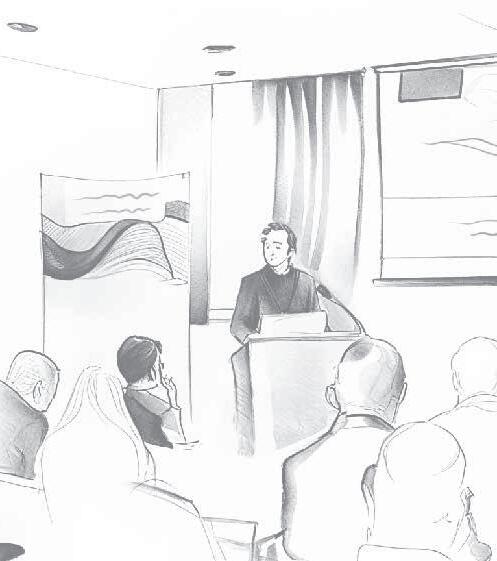

8th Asia Pacific Meeting on Near Surface Geoscience & Engineering (NSGE)
11-13 May 2026 – Bandung, Indonesia
Under the theme Geoscience Contributions for Sustainable Earth Resources, this flagship event will bring address the growing complexity of near-surface challenges across the APAC region. The programme will highlight applied technologies, sustainable practices and cross-sector insights in environmental geophysics, engineering applications, site characterisation, urban development and natural hazard mitigation. Discussions will also explore the critical role of near-surface methods in supporting geothermal energy, infrastructure resilience and carbon storage. Delegates can expect a dynamic mix of technical sessions, workshops and networking activities in Bandung’s scenic highlands environment.
Call for abstracts deadline: 15 December 2025

2nd EAGE/SBGf Conference on Deepwater Brazil Equatorial Margin
26-28 May 2026 – Rio de Janeiro, Brazil
The Equatorial Margin is entering a new chapter. Recent ultra-deepwater discoveries have renewed global interest in this frontier, confirming its vast potential and sparking critical industry dialogue. Returning for the second edition, this landmark event promises deeper insights, dynamic discussions and cross-disciplinary collaboration. We invite contributions on basin evolution, geoscience technologies, environmental and regulatory challenges and the role of the Equatorial Margin in the energy transition. Join leading experts to share knowledge, explore new opportunities and shape the future of this emerging region.
Call for abstracts deadline: 29 January 2026
Nefertiti Herman, EAGE Student Chapter at the University of Guyana, writes on experience presenting at 2nd EAGE Conference on Guyana-Suriname Basin (GSB).
Currently pursuing a bachelor’s degree in mechanical engineering at the University of Guyana, I was honoured to have the opportunity to not only attend the GSB conference but also present a poster on Environmental impact and carbon mitigation
I was among several other students from the University of Guyana, representing fields such as environmental studies, geology, petroleum engineering and economics who got the chance to take part in the conference and experience the diversity of disciplines for learning, collaboration and meaningful exchange of ideas.
Before attending, I anticipated gaining deeper insights into the GSB, and the three-day conference far exceeded my expectations. I was able to gather extensive knowledge about the history, current exploration activities and future outlook of the basin. Key topics included the role of artificial intelligence in energy systems, well placement strategies and reservoir insight using azimuthal ultra-deep resis-

tivity (AUDR) workflows, all of which highlighted the integration of innovation and technology in the energy sector.
Importantly, the event broadened my understanding of geoscience as critically significant in regional planning, environmental management and energy development. Seeing the significant connections between geoscientific knowledge and engineering, economics and policy was enlightening. It demonstrated the true value of inter-disciplinary collaboration by offering not only technical information but also a comprehensive overview of the energy situation in the area.
Lyanne Perez, Guyana in-country geoscience manager for ExxonMobil Guyana, writes about a milestone collaboration with the University of Guyana (UG) and EAGE: ‘I recently had the privilege of collaborating with UG and EAGE to help establish the first-ever EAGE Student Chapter at UG and to support student participation in the 2nd EAGE Conference on the Guyana-Suriname Basin, held in Georgetown.
Student involvement in a conference of this calibre is deeply impactful. It brings fresh perspectives to the room, enriching the diversity of presenters and attendees and fostering more creative and innovative discussions. For students, it’s an opportunity to gain technical insights, build professional networks and develop skills that will serve them throughout their careers. For companies, it offers a valuable window into the next generation of talent – allowing us to engage with potential future colleagues in a meaningful way.
I was proud to witness UG students participate in the EAGE conference for the first time. Their enthusiasm, professionalism and the quality of their presentations and posters were truly impressive. Even more exciting is the successful launch of the UG EAGE Student Chapter, which will continue to provide students with access to technical training, career development resources and networking opportunities as they progress through their academic journeys.
Personally, working alongside these students has been incredibly rewarding. Their energy and commitment to learning were inspiring, and I look forward to seeing their continued involvement in future EAGE events as the Student Chapter grows and thrives.’

What resonated with me the most was the strong emphasis on sustainability and the growing urgency for carbon mitigation within the industry. The discussions directly aligned with the focus of my own research on the balance between energy development and environmental responsibility.
Based on what I now know I have advice for other students. Keep yourself updated on forthcoming workshops, conferences and student contests hosted by organisations such as EAGE. Ask professors or advisors for advice on possible study subjects you can investigate and discuss. Even if a cross-disciplinary opportunity falls outside of your primary field of study, take advantage of it because innovation frequently occurs when disciplines converge. Participate when possible in poster sessions or submitting abstracts on your own initiative. It is a terrific opportunity to advance both academically and professionally. Finally, make contacts and cultivate relationships with students and professionals in the field. These interactions may result in employment possibilities, internships and mentorship.
A special invitation
students EAGE warmly encourages all students to renew their 2026 EAGE membership and continue engaging with opportunities offered through their Student Chapter. Being part of the EAGE student community provides access to conferences, workshops, competitions and networking opportunities that help you grow academically and professionally. Don’t miss the chance to strengthen your connection with peers worldwide and be part of shaping the future of energy and geoscience.













































































































































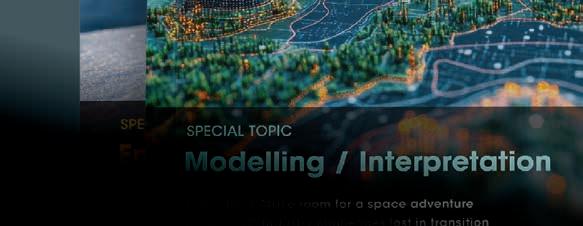




































































































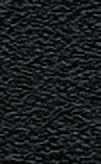




As part of its 2025 Evening Lecture Series, the EAGE Local Chapter London in May hosted Lisl Lewis (GeothermEx, SLB) and Eren Gunuc (London Geothermal) at Imperial College London for a timely discussion titled ‘The UK opportunity: A new geothermal story’. The talk addressed the current state and future outlook of geothermal energy development in the United Kingdom, highlighting both technological innovations and structural barriers to deployment.
Despite its favourable subsurface characteristics, the UK has yet to fully realise the potential of geothermal energy at scale – especially when compared to continental Europe, where geothermal heat networks have been more widely integrated into energy infrastructure. However, both speakers noted a recent increase in exploratory
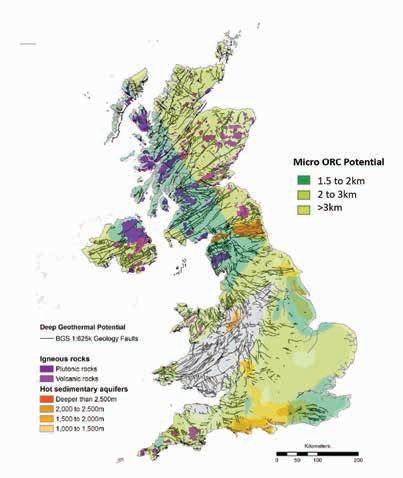

projects and public-private interest suggesting that a shift may be underway.
Lewis and Gunuc provided a comprehensive overview of the technological advances enabling localised, low-carbon geothermal solutions, including deep and shallow systems capable of delivering heating, cooling and electricity. These developments support the deployment of resilient, off-grid energy systems aligned with broader net-zero targets.
The presentation noted that geothermal energy is not solely a thermal resource, but part of a broader transition toward sustainable, secure and decentralised energy infrastructures. Particular attention was given to the geoscientific and engineering challenges related to characterising subsurface conditions, mitigating risk and scaling up demonstrator projects.
Gunuc referenced examples from London Geothermal highlighting potential business models that link geothermal development with innovative
financing strategies and next-generation heat network integration. Both speakers said supportive national policies were important, such as feed-in tariffs and regulatory incentives, to encourage private sector engagement and accelerate wider adoption of geothermal solutions in the UK.
The lecture concluded with a call for greater geoscientific involvement in project planning and policymaking particularly in the areas of hazard mitigation, resource assessment and system design. As the UK explores alternatives to gas-fired heating, the role of geothermal energy in a secure and decarbonised energy future becomes increasingly relevant.
A full recording of the session is available on the EAGE YouTube channel. LC London encourages members of the research and professional community to continue this conversation and contribute to ongoing discussions via abstract submission and participation in upcoming events.
The EAGE Student Fund supports student activities that help students bridge the gap between university and professional environments. This is only possible with the support from the EAGE community. If you want to support the next generation of geoscientists and engineers, go to donate.eagestudentfund.org or simply scan the QR code. Many thanks for your donation in advance!

Chrisopher Liner has done it all. He currently holds the Maurice F. Storm endowed chair in petroleum geology at the University of Arkansas, spent years working in the oil industry, was for a time editor of Geophysics , not to mention SEG president (2014-2015). These days geothermal is his main professional preoccupation, while his rare book collection and support for animal rights take up his time outside work.
My early academic performance was mediocre, but I was an avid reader of ancient history, science, science fiction, and the great mathematicians. With two of my brothers already in the University of Arkansas geology department I sought out iconic professor Walter Manger who said ‘You like geology and math? You are a geophysicist!’ But I struggled with math until encountering a young professor, Dennis Brewer. Under his guidance I made top grades in five semesters of calculus and applied mathematics. I took a master’s degree in geophysics from the University of Tulsa (TU) working with Stan Laster, leading to a research geophysics position with Western Geophysical in London where I became a lifelong Anglophile.
In London, conversations with my classmates back home who worked for oil companies convinced me that was the direction I needed to go. I joined Conoco in Oklahoma City as an exploration geophysicist. Back then firming up a prospect before drilling took years. Today a geophysicist on a shale oil team can drill dozens of wells per year. Final academic training was a doctorate at the Colorado School of Mines working with Norm Bleistein and Jack Cohen. I then joined the faculty of the TU Department of Geosciences. My teaching notes eventually became Elements of 3D Seismology. I also started the long-running column Seismos (now the online Seismos Report) and met Sven Treitel, a lifelong mentor and friend. Through Sven I became
assistant editor and, ultimately, editor of Geophysics. Sven even took credit for introducing me to my future wife, Dolores Proubasta.
After TU I joined Saudi Aramco as a research geophysicist in Dhahran, arguably my most interesting career adventure. Scientific research is more central to the life of a service company, while hydrocarbon prospecting and production are the focus of oil companies; I thoroughly enjoyed both environments. Academic life is less structured, direct reward for accomplishments, and constant enrichment from students. My other academic appointments were at the University of Houston and the University of Arkansas (U of A) since 2012 serving as department chair and associate dean. Although honoured by such posts, my interest has always been in solving physical problems. Geoscience is at the centre of some great issues of our time: energy, climate, water, metals, and critical minerals. I relentlessly advise geoscience students to double major or at least minor in another field to enhance career opportunities.
My SEG volunteer work ultimately led to the presidency. All of our professional societies are under stress as declining employment numbers in traditional fields translate into membership decline. But the mantra of perpetual growth can be a distraction. Perhaps it is better we manage the best possible society based on current membership and realistic forecasts. The future of societies lies with
co-operation, avoiding the duplication of programmes that members are less and less willing to fund.
My lifelong love affair with rare books is not just about holding an artifact in your hand, but sharing the thoughts of a mind from long ago, e.g., Euclid, Pliny, Suetonius, Shakespeare, Newton, Darwin, Einstein, Orwell, and so many more. The Liner Rare Book Collection at U of A was established in 2021 to eventually house my cherished 400+ volumes. In 2022 Dolores and I also endowed the Proubasta-Liner Animal Rights Speaker Series at the university law school to address the diversity of non-human life on Earth and their right to co-exist with us.
Our civilisation’s focus on immediate energy problems has overshadowed a powerful, long-term solution right beneath our feet: Utility-scale geothermal power. Intellectually, I find the topic a fascinating blend of physics, reservoir engineering, geology, and geophysics. While traditional hot spot geothermal power has been harnessed for over a century, new methods are making it accessible anywhere. This burgeoning industry is poised to change the world based on technology we have today. Geothermal is a 100,000-year solution to our insatiable energy needs and is a crucial pathway to a cleaner, more liveable planet. For the remainder of my career, I am committed to advancing this cause through teaching, research and innovation.
BY ANDREW M c BARNET

Speculation about the potential oil and gas reserves to which the Gaza Strip and West Bank of Palestine might lay claim have largely remained dormant since 7 October 2023 when Hamas militants massacred over 1200 mainly Israeli citizens and took 251 hostages. Until last month the world’s focus has been on the horror of the initial atrocity and the scale of Israel’s retaliatory action, the justification for which is beyond the scope of this column.
Now, two years on, a ceasefire (holding at the time of writing), release of hostages, and partial withdrawal from Gaza of occupying Israeli troops hopefully signals the first tentative steps towards a peaceful solution and with it the monumental challenge of restoring a community laid waste by war. In this context interest will at some point turn once again towards the possibility of revenue generation – meagre as it might be – from potential hydrocarbons exploitation in Palestinian territory.
This is an issue with a long and contentious history that reflects Middle East geo/oil politics dating back to the early 20th century, well before the creation of the state of Israel in 1948 and the partition of Palestine. One accessible reference to the early days can be found in the aptly named The Land That Oil Forgot: Palestine, 1913–1948 by the prolific Middle East historian Michael Quentin Morgan in an article published in GeoExpro (5 December 2020). This makes mention of a meeting (chance or not is unclear) in 1914 near Kurnub in the Negev Desert, at that time still part of the Ottoman Empire. The encounter was between William Yale (1887-1975), an American oil representative from Socony (Standard Oil and eventually Mobil), later a regional diplomat and spy based in Cairo, and the legendary TE Lawrence (of Arabia fame). Yale apparently made pretence of being a tourist while in fact scouting for oil. Lawrence was unconvinced, reporting his suspicions of Yale’s true intent.
the choice prospects of what were to be the oilfields of Iraq, and were only eventually admitted when the Iraq Petroleum Company (IPC), previously Turkish Oil Company, was formed in 1928. Morgan states the company went on to purchase interests in Palestine, invested in a Kurnub camp as a prelude to drilling for oil, to the apparent alarm of Britain. With the outbreak of war, Ottoman and British authorities effectively nixed the project until 1922. Then as the result of the US government calling foul play, Socony’s Palestinian status was reinstated and a preliminary survey conducted. However when Socony joined IPC in 1928, its interest lapsed.
‘An issue with a long and contentious history’
Initial post Second World War operations were carried out by an IPC subsidiary until the end of the British mandate in 1948. They were resumed by Israeli companies (Lapidoth Israel Oil Co and Israel Oil Prospectors) eventually striking oil on 22 September 1955 at what would be known as the Heletz field, southern Israel, close to the Gaza Strip. The find at 4906 ft depth was made by deepening an IPC well which, according to a contemporaneous Oil and Gas Journal report, would only have had 1500 ft further to go for a strike.
As Israel’s sole onshore oil producer (apart from some less significant oil activity around the Dead Sea and Golan Heights), Heletz and neighbouring sites have contributed a modest 17.2 million barrels.
Israel’s energy strategy up to the 20th century was preoccupied with securing oil and gas imports and their safe pipeline passage dealing with neighbouring or nearby countries, typically Iran (until 1979), Egypt, Jordan, Lebanon and Syria in often fraught relations on occasion marred by actual warfare. Electricity demand was met by coal production, now being phased out, and imported mazut heavy fuel.
Socony was active in the Palestine area because pre-First World War, American companies were effectively excluded from
No one predicted that Israel was to become a natural gas power house, now aggressively exploring new markets for export. In summary, the breakthrough came in 1999 when the Tethys Oil Partnership discovered the Noa gas field, offshore Ashqelon. The
Mari B field, operated by Noble Energy (acquired by Chevron in 2020) and the Delek Group, followed a year later and for a relatively brief period began delivering commerical gas from 2004, thereby initiating the country’s transition to gas-powered electricity.
In 2009, Nobel Energy and its partners discovered the Tamar-1 and the Dalit-1 gas fields. But it was the giant Leviathan field 30 km west of Tamar with estimated recoverable reserves of 650-619 bcm of gas which really transformed Israel’s energy outlook. Subsequently, additional amounts of gas have been discovered in the Karish, Tanin, Dolphin, Tamar SW and Aphrodita-Ishai fields. Tamar, Leviathan and Karish fields began production in 2013, 2020 and 2022 respectively.
According to the Israeli Ministry of Energy and Mining, Israel had total proved gas reserves of about 709 bcm (2023). Israel produced 27.38 bcm from its Leviathan, Karish and Tamar fields in 2024, an 8.3% increase compared to 2023 (25.28 bcm). Of gas production from these fields in 2024, 52% (14.27 bcm) was destined for domestic use, while the remaining 13.11 bcm was exported to Egypt, Jordan and more controversially and tentatively to EU countries since an MoU in 2022.
Much more is to come. For example, in February 2025, the Israeli company NewMed Energy submitted a $2.4 billion plan to the Israeli Government for the expansion and boosting of production at the Leviathan gas field to 23 bcm/year (from around 12 bcm/year currently).
company Gazprom was considered as an option. Unsurprisingly perhaps in 2018, Shell, which had taken over British Gas, decided to relinquish its 60% stake in Gaza Marine, transferring it to Palestinian state companies.
There has always been a plan on the table, focused on piping the Gaza Marine gas to Egypt, these days conflicted by its need to replenish its dwindling gas reserves but anxious not to put its more significant imports from Israel in jeopardy. Issues over the years have included the likely viability of this isolated development valued at $3 billion in revenue but with a capital cost possibly between $1-2 billion and vulnerable to fluctuating gas price. Although maritime borders were established in the 1995 Oslo Accords, interim agreements between Iarael and the then Palestinian Liberation Organisation, their legality remain contentious. Furthermore, international geopolitical tensions and disruptions in Gaza itself, control of which is disputed between the PA, based in Ramallah, West Bank and Hamas, are all factors constantly weighing on any approvals.
Meantime Gaza Marine’s potential to improve the fortunes of Gaza’s population has in some quarters reached almost mythical proportions. This applies also to Area C of the occupied West Bank where possible overlap from Israel’s minor Meged field is thought to harbour oil reserves denied to Palestinians.
‘Always been a plan on the table’
Adding to this abundance, Israel is believed to have the third largest deposits of shale oil in the world (estimated at 250 billion barrels) after the US and China, mainly in the Negev desert area and the Shfela Basin. Just how much would be recoverable is still to be determined, as is public acceptability of any development.
Amidst Israel’s stunning energy wealth generation, the Gaza Strip and West Bank have remained isolated: frustratingly so, because one of the early discoveries in the Levant Basin in 2000 was the Gaza Marine gas field (estimated reserves of 28.3 bcm ), 35 km off the Gaza coast made by British Gas in partnership with the Consolidated Contractors Company (CCC), under a licence granted by the Palestinian Authority (PA). According to multiple reports, Yasser Arafat, PA president, took a boat out to light the first flare stack at the well site. He referred to the find as ‘a strong foundation for a Palestinian state’.
The euphoria was short lived. As of today, 25 years later, the Gaza Marine prospect remains untouched, blocked primarily by Israel’s concerns for the security of its own neighbouring offshore fields and insistence that Hamas, which took control of the Gaza Strip in 2007, should not benefit from any development. No amount of persuasion, including past diplomatic efforts by the likes of John Kerry, US Secretary of State, and Tony Blair, ex British Prime Minister and Middle East negotiator, has got close to the finish line. At one time collaboration with the Russian
A report in 2019 from the UN Conference on Trade and Development entitled The Economic Costs of the Israeli Occupation for the Palestinian People: The Unrealized Oil and Natural Gas Potential claimed Palestine was missing out on ‘hundreds of billions of dollars for development.’ Hence the improbable theory that Israel’s onslaught on the Gaza Strip was about access to oil and gas.
A polemical rejoinder by Elai Rettig (Begin-Sadat Centre for Strategic Studies) and Lee Wilcox, an American writer, in The Gaza oil myth, is right to say the UN report conflates Israel’s hydrocarbons bounty with Gaza’s suggesting some sharing of wealth: ‘The Gaza Marine and Meged fields, while valuable in an economic sense, are not significant enough to drive military action’. The authors sense sinister forces at work, adding ‘The spread of the Gaza oil myth reflects the dangers of relying on dubious sources and conspiracy theories to explain complex geopolitical conflicts’.
In fact, before the massacre, Israel was warming towards some concession, motivation unclear. In June 2023, it approved the development of the Gaza Marine field, with Egypt’s stateowned Egyptian Natural Gas Holding Company (EGAS) which would lead development in collaboration with the PA. Once integrated by a 40 km pipeline into Egypt’s energy grid, gas would be sold, as an export, to Palestinians and others. Preliminary Israeli approval was said to be ‘subject to coordination’ between its security services, Egypt and the PA, an ominous proviso to Palestinian hopes after all these years that will doubtless persist.
Views expressed in Crosstalk are solely those of the author, who can be contacted at andrew@andrewmcbarnet.com.




























TPS provides geophysical clarity by enhancing the quality and value of seismic data and enabling effective imaging of the most complex geologies.
Image Better
• Improved imaging under salt and basalt.
• Elimination of local minima in Full Waveform Inversion and improved resolution.
• Reduced dependency on well logs in building blocky reservoir models.
Stay Safer
• Safer deployment, retrieval and prevention of auto-fires.
Be Greener
• Reduced high-frequency and sound pressure exposure levels.
• Exclusion zone reduction and lower duty cycle.








BP’s latest Energy Outlook shows that global oil demand will continue to grow until 2030, five years later than it forecast a year ago.
It estimates that the world will need 83 million barrels of oil a day in 2050, a rise of 8% compared with its previous estimate of 77 million barrels a day. bp said it expects oil demand to peak at 103 million barrels a day in 2030.
To meet global net zero targets by 2050 the fall in oil demand would have to drop to about 85 million barrels a day by 2035 and about 35 million barrels by 2050, bp said.
As electricity demand doubles over the period to 2050, oil demand will decline after 2030, but will continue to play a significant role in the global energy system over at least the next 10-15 years. China’s oil demand, which accounted for around half of global oil demand growth over the past decade, will fall in the second half of the 2020s.
UN climate goals are unlikely to be reached with global energy demand growing at an average of around 1% between 2019 and 2024. Growth is driven by increasing prosperity in emerging economies, says bp.
The pace of improvements in energy efficiency – measured as the amount of total final energy consumed per unit of GDP – continues to be subpar, averaging just 1.5% per annum between 2019 and 2024, down from almost 2% p.a. in the previous 10 years.
Carbon emissions have grown at an average rate of 0.6% per annum between 2019 and 2024. If CO2 emissions remain close to recent levels, the carbon budget estimated by the Intergovernmental Panel on Climate Change (IPCC) to limit global temperature rises to 2°C would be exhausted by the early 2040s.
Under what bp calls the ‘current trajectory’ of the energy transition, natural gas demand is estimated to be 4806 billion cubic metres a year in 2050, up 1.6% from its previous estimate of 4729 billion cubic metres.
Growth in natural gas demand has been led by China, and to a lesser extent the Middle East and the US. Based on LNG export

facilities which are either under construction or have taken final investment decision, global LNG exports are set to increase by more than half by 2035 relative to 2024, with the US and Middle East accounting for around two-thirds of that increase.
Wind and solar power generation have doubled between 2019 and 2024. Growth in renewable power generation has been led by China, which accounted for over half of the increase in the past five years. As a result, coal consumption falls, driven by declining use in power generation, especially in China.
Despite rapid growth in renewable energy, oil is still forecast to remain the single largest source of primary global energy supply for most of next two decades, at 30% in 2035. Renewables are forecast to rise, from 10% of the primary energy supply in 2023 to 15% in 2035 and will not surpass oil until the late 2040s, said bp.
Viridien and TGS have completed acquisition of the Laconia Phase III ultralong offset ocean bottom node (OBN) survey in the Gulf of America.
The latest phase spans 151 OCS blocks and expands ultra-long offset low-frequency OBN coverage of the Paleogene trend to provide improved
covered in 2006. bp last year approved development of its sixth operated hub over Kaskida, which also includes more than a hundred blocks of unlicensed acreage covered by this phase of the project.
The survey was acquired by a TGS deepwater OBN crew using TGS’

seismic data and subsurface imaging over this geologically complex area.
Laconia III includes coverage of the 100% bp-owned Kaskida field, dis-
ZXPLR nodes and Sercel’s Tuned Pulse Source (TPS). The Laconia Phase III data set will be imaged using Viridien’s elastic full-waveform inversion (E-FWI) to improve subsalt structural
clarity and support further exploration in central Keathley Canyon. Early data will be available at the end of October in time for the offshore lease sale scheduled in December. Final products will be delivered in early Q1 2027.
Dechun Lin, EVP, Earth Data, Viridien, said: ‘We are acquiring high-quality OBN data and applying our most advanced imaging to give operators the clearest view of these promising yet complex subsalt plays. This collaboration continues to raise the bar for subsalt images, helping the industry unlock new opportunities in the Paleogene trend with greater confidence. Phase III of the Laconia program represents an important step forward for exploration in Keathley Canyon.’
David Hajovsky, EVP Multi-Client at TGS, said: ‘ Laconia Phase III is designed to significantly enhance imaging, optimising near-term exploration of the critical Paleogene play. Through co-operation with Viridien, utilising leading-edge OBN acquisition and imaging technologies, we expect sharper subsalt definition, more reliable velocity models and clearer fault imaging supporting both regional and infrastructure-led exploration.’
Shearwater Geoservices has won a seven vessel-month streamer contract from Oil India starting in the fourth quarter of 2025. The combined 3D and 2D seismic survey will employ two vessels from the Shearwater fleet.
The project covers the Mahanadi and Krishna-Godavari fields and includes the acquisition of approximately 5000 km2 of 3D seismic and more than 4000 line-km of 2D data.
‘Shearwater is returning to India for our tenth consecutive season to acquire high-quality data. We are a significant contributor to India’s strategy of lowering the country’s energy deficit, having supported both the National Seismic Program and Indian oil companies with 2D, 3D and OBN data acquisition,’ said Irene Waage Basili, CEO of Shearwater. ‘Building understanding of the geology in this promising region is key to unlocking future investment opportunities for our client.’
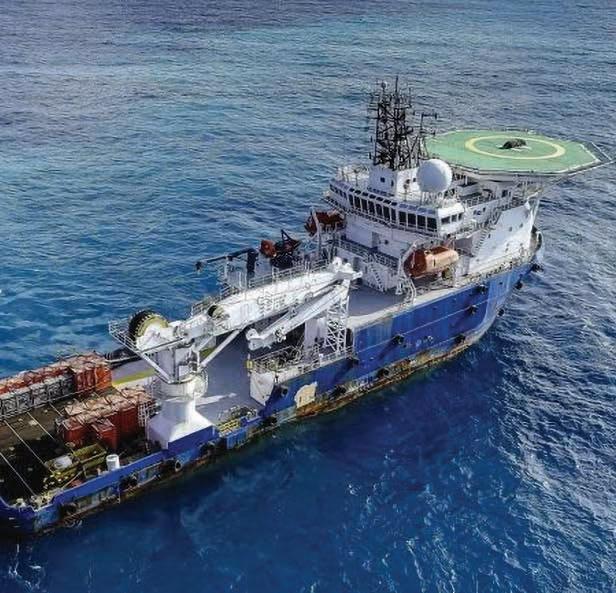
The UK could boost North Sea oil and gas production while remaining within the strictest international climate pathways, says Wood Mackenzie.
The energy analyst’s research shows the UK Continental Shelf (UKCS) production emissions outperform the Intergovernmental Panel on Climate Change’s net zero scope 1, 2 & 3 emissions pathway by 25 to 50 MtCO2e per annum through to 2050.
This creates ‘theoretical headroom’ for the UKCS to produce 2.6 billion barrels of oil equivalent by 2050. The surplus remains within climate science requirements whilst delivering substantial economic and environmental benefits.

‘The North Sea stands at a crossroads, but our analysis shows a clear pathway balancing climate science with energy security,’ said Gail Anderson, research director, North Sea Upstream at Wood Mackenzie. ‘Smart licensing policies targeting known discoveries could extend critical infrastructure life, whilst delivering substantial emissions and cost benefits over importing alternatives.’
The findings emerge as the government weighs whether to ban new exploration licences under its ‘science-aligned approach’ to future UKCS production. Wood Mackenzie’s analysis reveals ‘compelling advantages of maximising domestic production over imports’. Every additional trillion cubic feet of UKCS gas saves 15 MtCO2e of scope 1&2 emissions when displacing US LNG imports, it said.
‘The more the UKCS produces,’ said Anderson, ‘the less emissions will be released, and the less the UK will spend on imports. Such an approach will ensure production for decades to come and support the North Sea’s energy future.’
Due to recent fiscal turmoil, 2025 is set to become the first year since 1960 without a single wildcat well in the North Sea, said Wood Mackenzie. Its analysis advocates targeted licensing focused on discovered resources that could tie back to current infrastructure.
Wood Mackenzie has identified 2.3 billion barrels of oil equivalent across 7634 open and relinquished blocks, with gas comprising over a third. Only 34 blocks contain resources exceeding 20 million barrels of oil equivalent. However, these blocks total 1.4 billion barrels of oil equivalent and offer crucial tie-back opportunities to maintain host infrastructure viability.
By 2035, the UK could be relying on US LNG for over 60% of its gas supply as Norwegian piped imports decline. This shift will triple the emissions intensity of UK gas supply from 3.7 to 11.3 gCO2e/MJ by 2035, said Wood Mackenzie. As a result, 90% of scope 1&2 emissions from gas supply sources would come from US LNG by 2050. Wood Mackenzie’s analysis demonstrates that an additional 1 trillion cubic feet of UKCS gas production could deliver emissions savings of 14.6 MtCO2e. This potentially exceeds the North Sea Transition Authority’s mid-range platform electrification scenario savings of 13.4 MtCO2e from 2030 to 2050. The short-run cost of UKCS gas supply runs at almost half that of US LNG, Wood Mackenzie added.
‘UKCS emissions account for just 3% of net UK territorial emissions, yet the industry faces disproportionate pressure compared to other economic sectors,’ said the analyst. ‘Wood Mackenzie argues for a balanced approach encouraging hydrocarbons, carbon capture and storage, hydrogen and wind from the North Sea. Even under net zero scenarios, the UK will consume around 500,000 barrels of oil equivalent per day and remain a net importer.
‘The government faces pressure to restrict North Sea production, but risks undermining both climate goals and energy security,’ added Anderson.
The UK government’s consultation on ‘Building the North Sea’s Energy Future’ closes later this year.
Geoteric and Petronas Carigali have signed an agreement to strengthen co-operation in AI adoption.
Petronas Carigali will use Geoteric’s AI technology to identify new hydrocarbon prospects faster, increase drilling success and expedite exploration activities.
‘Geoteric is renowned for seamless integration into existing geoscience
workflows and the introduction of first-to-market AI into the software in 2019 has had a transformative effect on whole-project efficiency; achieving reductions in cycle time by up to 90%,’ said Geoteric. ‘By combining human expertise with AI, Geoteric empowers geoscientists to make faster, more informed decisions, and ultimately,
deliver a faster return on seismic data investments.’
As part of the strengthened co-operation agreement for the next three years, Petronas Carigali will leverage Geoteric AI across its operational portfolio, leveraging the software across the exploration and production lifecycle.

STRYDE has been selected by TAY Oil Services and Polaris to supply its technology for the largest onshore oil and gas exploration survey in North Africa in Concession 57 in Libya.
Commissioned by the state-owned oil company AGOCO (Arabian Gulf Oil Company), TAY Oil-Polaris has deployed the semi-automated, containerised seismic system, featuring 40,000 STRYDE seismic nodes, to enable a high-density 3D onshore survey over a 1480 km² area.
Abdellatif Hakkoumi, Polaris regional manager, said: ‘To meet the rising demand for high-resolution seismic imaging across
expansive areas of Libya, we required an innovative nodal system capable of supporting a high channel count, without the logistical and financial constraints of conventional systems. With the quick delivery of STRYDE’s fully autonomous nodes and semi-automated containerised seismic system, we have rapidly transitioned into a new era of land seismic acquisition. This advanced technology enables us to dramatically increase trace density per square kilometre. As a result, our customers benefit from improved subsurface imaging, reduced geological uncertainty, optimised well placement, and lower drilling risks, ultimately increasing exploration success rates.’
STRYDE’s Containerised Seismic System, housed within a 20 ft shipping container, seamlessly integrates all essential hardware for semi-automated node charging, harvesting, and on the fly generation of seismic data deliverables.
Customised to meet TAY Oil-Polaris specific project requirements and high-channel count efficiency, the containerised system allows a single operator to rotate 13,000 nodes within 24 hours – dramatically reducing crew size, HSE
risk exposure, and operational costs, said STRYDE.
Fully burying STRYDE nodes, TAY Oil-Polaris can benefit from zero surface obstructions, minimising surface noise contamination, said STRYDE.
Mehdi Tascher, sales director at STRYDE, said: ‘With our state-of-the-art seismic system, TAY Oil-Polaris is set to carry out the largest nodal seismic acquisition project ever conducted in North Africa and will be able to meet fully Libyan onshore seismic growing demand. We are proud to supply TAY Oil-Polaris with the industry’s only fully integrated and semi-automated seismic system, enabling unprecedented operational efficiency while delivering high-resolution seismic data to their Libyan customers. ‘Libya’s complex geology, defined by thick carbonate sequences and rugged terrain, poses significant challenges for accurate subsurface imaging. To overcome these obstacles, high-density sensor deployment is essential for delivering superior structural and stratigraphic resolution. By harnessing STRYDE’s advanced nodal system, TAY Oil-Polaris is equipped to navigate these complexities.’
PXGEO has appointed Ammar Chattha as chief financial officer (CFO).
A qualified chartered accountant and chartered financial analyst with a background in financial consultancy across Europe and Middle East, Chattha succeeds Hans-Peter Burlid, who previously served as chief commercial officer and CFO at PXGEO before stepping into the newly created role of chief strategy and transformation officer in July.
Chattha brings extensive experience across manufacturing, industrial and infrastructure companies. He joins PXGEO from a leading global manage-
ment consultancy, where he was most recently a director, spending seven years in UK and Middle East. Prior to this, he spent four years at KPMG in London, within the financial advisory and valuations practice.
Charles ‘Chuck’ Davison Jr, PXGEO CEO, said: ‘Financial leadership is about more than numbers, it’s about guiding decisions that shape the future of the business, and Ammar brings exactly that. His track record and outstanding financial acumen combined with his strategic perspective will be invaluable to us as we continue the business. Under his guid-

ance, we are well-positioned to seize new opportunities and accelerate sustainable growth.’
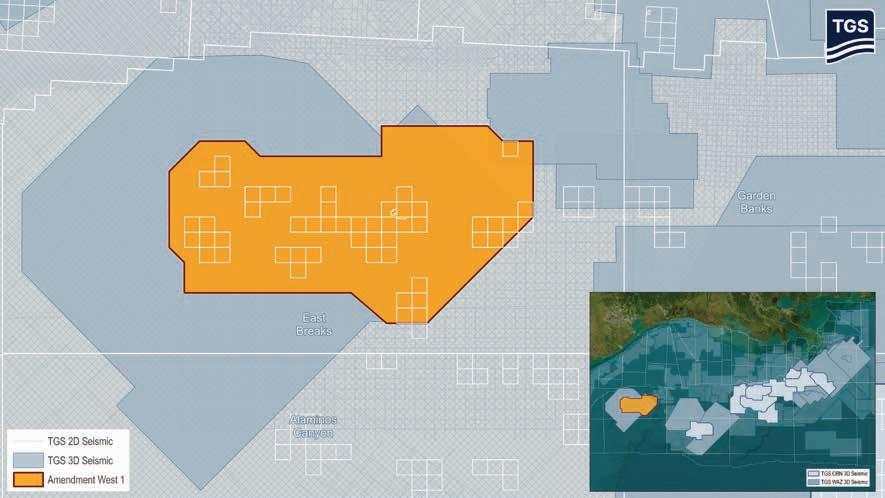
TGS has launched of a multi-client UltraLong Offset Ocean Bottom Node (OBN) data acquisition campaign in the Gulf of America. The Amendment West-1 survey is TGS’ second campaign expanding multi-client node coverage in the Paleogene West play, adding more than 5400 km2 within the East Breaks protraction area.
Amendment West-1 will feature TGS’ Gemini-enhanced frequency source and TGS’ ZXPLRe nodes. The Gemini source has been engineered to generate increased low-frequency energy for deep penetration and Full Waveform Inversion (FWI), while preserving high-frequency content necessary for conventional processing and imaging workflows.
The dataset – leveraging TGS’ Elastic Full-Waveform Inversion (E-FWI) and Reverse Time Migration (RTM) imaging technologies, and integrating TGS’ Crystal C wide azimuth streamer data – will improve subsurface clarity of the emerging Paleogene west play potential in the East Breaks area, which will feature in upcoming lease rounds.
Amendment West-1 node deployment commenced mid-September and data acquisition is expected to complete in mid-March 2026, with delivery of initial products scheduled for Q2 2026.
Kristian Johansen, CEO of TGS, said: ‘With the Amendment West-1 OBN survey we expand on our success of
providing multi-client OBN programs over existing wide azimuth streamer data in the Gulf of America, and this survey is playing a pivotal role in facilitating Paleogene exploration targets. Our recent processing advances have attracted considerable industry attention.’
Meanwhile, TGS has launched the PAMA Phase II 3D multi-client survey in the Equatorial Margin area offshore Brazil, covering 11,500 km2, including blocks currently under nomination for upcoming licensing rounds scheduled for 2026 and 2027. A Ramform Titan-class vessel equipped with TGS GeoStreamer technology started data acquisition early June and is expected to complete the survey early March 2026.
The Pará-Maranhao Basin features evidence of a functioning deepwater petroleum system in the Cretaceous and Paleogene layers and has attracted significant industry interest spurred by prolific discoveries in neighbouring countries such as Guyana and Suriname, said TGS.
The first phase covered 19,343 km2 and more than 25 future exploration blocks within the Pará-Maranhao Basin. Johansen said: ‘With the ongoing Megabar extension multi-client project in the Barreirinhas Basin we will have two Ramform Titan-class vessels active in the Equatorial Margin through the remainder 2025.’
Shell has been selected by Google as its renewable energy supply manager in the UK. Shell will manage a renewable power portfolio for Google that addresses the intermittency of renewable generation through access to battery energy storage systems. When power production is high, Shell will store the surplus in readiness for when generation falls and more energy is needed.
The UK North Sea Transition Authority has issued Stewardship Expectations to help carbon storage licensees meet their obligations. The five areas covered are: risk assessment; appraisal and sub-surface characterisation; data acquisition and use for appraisal and monitoring; technology development and deployment; and stakeholder engagement.
TotalEnergies and Veolia have signed an agreement for further co-operation in energy transition. Veolia will contribute expertise in water resource management and the resource recovery of new waste streams, and TotalEnergies its expertise in the measurement and reduction of methane emissions and the production and supply of low-carbon energies.
Wagenborg has launched the vessel Carbon Destroyer 1 – measuring 150 m in length and 16 m in beam. The CO2 carrier is designed to carry about 5000 tons of liquified CO2.
1PointFive, a carbon capture, utilisation and sequestration (CCUS) company announced that the shipping company NYK has purchased carbon dioxide removal credits that will be enabled by 1PointFive’s Direct Air Capture (DAC) technology.
UK Oil and Gas has raised $0.5 million of investment towards its South Dorset and Yorkshire salt-cavern hydrogen storage and generation projects and a collaboration with National Gas to bid for the UK’s Hydrogen Transport and Hydrogen Storage Business Model allocation rounds in H1 2026.

Sercel has supplied high-performance land seismic acquisition and source solutions to a big North African geophysical contractor.
As part of the contract, Sercel supplied 75,000 DSU1-508 digital sensors,
increasing the contractor’s total installed base to more than 350,000. In addition, 24 new Nomad 90 Neo broadband vibrators were delivered to equip an additional land seismic crew.
With this latest delivery, the contractor has reached a total equipment capability of more than half a million 508xt land acquisition system channels and 64 Nomad 90 Neo vibrators, significantly increasing its ability to conduct large-scale 3D surveys in complex terrain.
To optimise survey performance, Sercel has also provided the contractor with a set of value-added support services. Nomad productivity is boosted with the Nomad Connect Asset Optimisation service, providing real-time insights into
fleet performance and an overview of vibrator configurations. The Vibrator Auto-Guidance functionality also enhances operational accuracy and productivity in the field, said Sercel.
‘These additional features, combined with the DSU1-508 single-sensor design and MEMS technology, ensure that the contractor is equipped with the most advanced broadband seismic acquisition solutions available to deliver the highest-quality seismic data in challenging environments,’ said Sercel.
Jérôme Denigot, CEO of Sercel, said: ‘This latest milestone highlights the growing demand for field-proven solutions that meet the evolving challenges of onshore exploration in North Africa and beyond.’
Egyptian oil and gas services company ARGAS has purchased 30,000 Range+ STRYDE nodes and STRYDE’s Nimble Seismic System, marking the first-ever deployment of nodal technology for onshore seismic acquisition in Egypt.
The first deployment of the STRYDE system will be on a large 2D seismic survey in Egypt. The technology will be used to acquire seismic data across highly prospective sedimentary basins, supporting oil and gas exploration efforts in one of Egypt’s most promising frontier regions.

STRYDE’s technology includes its ultra-lightweight Range+ nodes, coupled with a high-capacity charging, harvesting, and QC ecosystem, enabling thousands of nodes to be rotated daily.
‘After working with STRYDE’s system on previous projects, it became clear that this technology brings a significant advantage to both us and our clients,’ said Soufiane Azzi, director of commercials and collaborations at ARGAS.
Mehdi Tascher, STRYDE sales director, said: ‘The system has proven to drastically reduce deployment time, reduce headcount and vehicles count, simplifies logistics, improves recording time window, and delivers excellent seismic data. We are proud to be the first to bring node technology to Egypt.’
EMGS’ utilisation for the third quarter was 24% compared with 40% for the third quarter of 2024. EMGS had one vessel in operation and recorded 3.0 vessel months in the quarter. In the third quarter 2024, the company recorded 3.0 vessel months.
At the end of the third quarter 2025 EMGS had one vessel on charter, the Atlantic Guardian, which completed
fully prefunded multi-client surveys in the North Sea and was due to be redelivered to her owners at the expiry of the current charter period on 20 October 2025.
The company does not expect to record any multi-client revenue in the third quarter of 2025, but expects to recognise the revenue from the fully prefunded North Sea surveys in the fourth quarter upon final data delivery.

Trinidad and Tobago has attracted a total of four bids from two bidders for its 2025 Deep Water Competitive Bidding Round.
Three bids were received from China National Offshore Oil Corporation (CNOOC) International for Blocks TTDAA 24, TTDAA 25 and TTDAA 30 and the other bid from a consortium comprising of Nigeria’s STIT Energy and Groundports Ltd for Block TTDAA 5.
The round included all currently available deep-water blocks. The ultradeep area (Blocks TTDAA 17, 18, 19, 20, 21, 22 and 23), collectively known as TTUD-1, were not included in the round as negotiations with Exxon-
Mobil commenced in 2024, prior to the launch of the bidding round in January, 2025. The production sharing contract for Block TTUD1 was executed with ExxonMobil on 12 August 2025.
Roodal Moonilal, Minister of Energy and Energy Industries, said that the country will strengthen co-operation with leading international energy companies in deep-water technology and promised that the government will review fiscal incentives to make Trinidad and Tobago a more attractive hydrocarbon province. He also proposed to continue engaging with multi-client partners to improve 3D seismic data through acquisition and reprocessing.

TGS has released a stratigraphic and petrophysical dataset for the Wind River Basin in the US state of Wyoming, further expanding its Rocky Mountain data portfolio.
Building on the releases of 2025, including the Greater Green River Assessment and the Unita, Piceance and Paradox basins, the latest dataset delivers subsurface insights across 1572 wells and includes 35 stratigraphic tops with more than 9700 formation picks spanning the basin’s diverse geological framework. The release also includes detailed petrophysical interpretations and regional property
maps, supporting both traditional and emerging energy workflows.
The dataset enables regional stratigraphic interpretation across the basin’s structural complexities and diverse depositional environments; petrophysical analysis of key reservoir characteristics, including porosity, permeability, and fluid saturation; basin-wide property mapping, prospect evaluation, reservoir modelling, and carbon storage screening; and enhanced understanding of the Wind River’s geological features and hydrocarbon systems.
‘Our Wind River Basin dataset addresses a key gap in Rocky Mountain subsurface intelligence,’ said David Hajovsky, executive vice-president of multi-client at TGS. ‘We’re delivering the geological foundation our clients need to unlock value in this underexplored basin – from traditional drilling programs to next-generation carbon storage projects.
The Wind River Basin dataset is built to integrate seamlessly into existing workflows’, he added.
BRIEFS
Staatsolie is planning to conduct a seismic survey in a 2000 km2 area of shallow water in Suriname off the coast of Saramacca and Coronie at a water depth of 20 to 50 m. The survey is scheduled to start in mid-October and will continue until mid-December 2025. Staatsolie has appointed ILACO to conduct an environmental management and monitoring Plan.
TotalEnergies has appointed Nicola Mavilla as senior vice-president exploration, replacing Kevin Maclachlan, who has joined Chevron as head of exploration. Mavilla has 25 years of experience in the oil and gas industry. He joined Eni in 2002 and since 2024 has been head of exploration projects of Eni.
Shearwater has appointed Simon Telfer as CTO, responsible for leading its technology strategy, including IT, infosec, and digitalisation, whilst continuing to steer the growth and advancement of Software, Processing and Imaging (SPI). Telfer has been holding interim responsibility for the technology and manufacturing organisation since January 2025, in addition to his role as SVP of SPI at Shearwater.
The American Petroleum Institute (API) has welcomed a US federal court ruling that the previous administration’s attempt to permanently ban new oil and natural gas activity across millions of acres of federal waters was unlawful.
According to the US Energy Information Administration, US offshore production accounts for 14% of total US crude oil production, or nearly 2 million barrels of oil per day. Offshore oil and natural gas development could generate more than $8 billion in government revenue by 2040.
ExxonMobil is laying off 2000 workers globally, particularly in Canada and across the European Union, as part of a long-term restructuring plan that will affect about 3% to 4% of the company’s workforce. About 1200 positions will be cut in Norway and the EU by the end of 2027.
Global awards of new offshore wind sites and offtake contracts fell more than 70% in the first nine months of 2025, according to a new industry report. In its latest Quarterly Market Overview report, TGS|4C said recent setbacks are prompting a reset as governments, developers and suppliers adapt to new market conditions.
Instead of pursuing larger gigawatt targets, the analysis indicates that policy stability, reliable offtake agreements and flexible policies are taking precedence. As auctions slow and supply chains tighten, governments are implementing new frameworks while developers focus on flexibility and risk sharing to protect projects during volatile cycles, creating a more stable and attractive market for investment.
Of about 20 GW of global offtake auctions expected in 2025, 2.2 GW has been awarded so far. This compares with an annual offtake award average of 11.7 GW in 2022, 2023 and 2024. Several major
European auctions have been postponed, with top developers sitting out entirely.
This year has also seen a significant decrease in the rate of new site awards, as governments have delayed lease rounds and developers’ appetite for new sites has waned. A total of 11.2 GW has been awarded to date, compared with an annual average of 70 GW in 2022, 2023 and 2024.
Germany, the Netherlands and Denmark are among the countries preparing new Contract for Difference (CfD) and site awards frameworks to improve project bankability and restore investor confidence.
During the first three quarters of 2025, 14.6 GW achieved final consent, which is just slightly lower than last year’s permitting record.
‘Current momentum hinges on just a handful of projects in France, South Korea, and the UK,’ said TGS. France is the most resilient market, backed by €11 billion in
SOCAR and SLB have signed an agreement to accelerate the redevelopment of the Bahar and Gum Deniz fields in the Caspian Sea. This partnership will identify promising production zones, develop comprehensive reservoir modelling and the design of well and drilling rig programs.
Chevron is drilling the Korikori-1 exploration well 78 km offshore Suriname in the north-central part of Block 5 at a water depth of around 40 m. Block 5 is operated by Chevron (40%) in partnership with Paradise Oil Company (POC) (40%) and Qatar Energy (20%).
Pantheon Resources, which is developing the Kodiak and Ahpun projects on Alaska’s North Slope, has completed the hydraulic fracture stimulation on the Dubhe-1 well. Twenty five hydraulic fracture stimulation stages were completed in eight days and the well is being prepared for clean-up and production testing. It
was drilled to a total measured depth of 15,800 ft.
Eni has resumed exploration activities in the offshore area northwest of Libya, specifically in Block 16/4, after a hiatus of more than five years. It has re-entered the exploratory well C1-16/4 (also known as BESS-3), where drilling operations were previously halted in 2020 due to the Covid-19 pandemic. The well reached a depth of 3200 m and lies at a water depth of 743 m, 95 km from the Libyan coast and around 15 km from the Bahr Es Salam gas field.
The Norwegian Ocean Industry Authority (Havtil) has granted Equinor consent for exploration drilling in Block 7018/5 in the Barents Sea.
Eni has reached a final investment decision to develop the Coral North FLNG project, deepwater offshore Cabo Delgado, north of Mozambique. The project will
European Commission funding for three floating projects, it added.
TGS|4C’s supply and demand modelling indicates a potential turbine shortfall of about 2500 units (about 40 GW) by 2040, underscoring the importance of global manufacturing expansion and Chinese supplier integration.
By 2040, about 3GW of projects will reach end-of-life, rising to 27 GW by 2050. Decisions around repowering, lifetime extension or removal present new investment opportunities.
‘Auctions are the key battleground for offshore wind, with tough market conditions reshaping how costs and risks are shared between governments and developers. While stuttering auctions threaten energy targets, it’s encouraging to see governments stepping up as they recognise the need for offshore wind in their power systems,’ said Patrick Owen, lead author of the report.
put in production the gas volumes from the northern part of Area’s 4 Coral gas reservoir, in the Rovuma basin, through a floating LNG facility. The project will be implemented by the joint venture of Eni (50%), CNPC (20%), Kogas (10%), ENH (10%) and ADNOC’s subsidiary XRG (10%).
Rhino Resources Namibia has found gas in Block 2914A, offshore Orange Basin, Namibia. PEL85, where the well was drilled, is operated by Rhino with a working interest of 42.5%. Co-venturers are Azule Energy (42.5%), Namcor (10%), and Korres Investments (5%). The well reached a total depth of 447.5 m penetrating the Upper Cretaceous target. The well found 26 m of net pay in richgas condensate-bearing reservoirs, with the reservoir showing excellent quality petrophysical properties and no observed water contact.
Shashi Kumar1*
Introduction
Abstract
Ocean bottom nodes (OBNs) are critical for high-resolution marine seismic data acquisition, offering full-azimuth, high-fold, and multi-component recordings directly on the seafloor. However, misalignment between the node’s local coordinate system and the global reference frame can compromise subsurface imaging quality. This study introduces a novel data-driven method to estimate and correct node orientation — pitch, roll, and heading — by leveraging radial-transverse (RT) transformations of seismic data. The methodology optimises orientation parameters by minimising transverse energy while maximising radial energy using a tailored loss function. Differential Evolution (DE), a stochastic optimisation algorithm, is used to achieve precise alignment. Evaluation metrics, including radial energy, transverse energy, and vertical amplitude, validate the method’s effectiveness using seismic data from the KG-Deepwater OBN project along India’s eastern coast. Results demonstrate significant improvements in radial energy, transverse energy reduction, and vertical polarity restoration. This approach ensures accurate sensor orientation without pre-processing corrections, enhancing data quality for subsurface imaging across diverse water depths. The findings underscore the importance of reliable orientation estimation for advancing OBN seismic acquisition techniques.
Ocean bottom nodes (OBNs) have become increasingly vital in marine seismic data acquisition, providing high-quality multi-component data directly from the seafloor. This enables high-resolution imaging of subsurface structures through full-azimuth, high-fold, and long-offset recording. Unlike conventional streamers, OBNs are deployed on the seabed, allowing them to capture both P and S waves using a hydrophone and three-component geophones or accelerometers (Barnes et al., 2024). OBNs are placed on the seafloor using either remotely operated vehicles (ROVs) or the Node On A Rope (NOAR) method. Underwater currents and fishing activities in shallow areas can displace the nodes from their original positions. This results in unknown node locations, leading to misalignment between the internal coordinate system and the global reference frame used in data processing. The relocated positions can be estimated by jointly inverting water velocity and node positions using recorded direct arrival times (Amini et al., 2016).
If internal coordinate system misalignment is not corrected, it can disrupt the entire processing workflow and degrade the final subsurface image. This issue is particularly critical in multi-component and converted-wave processing, where accurate vector orientation is essential. Despite advancements
1 Oil and Natural Gas Corporation
* Corresponding author, E-mail: shashikolic@gmail.com DOI: 10.3997/1365-2397.fb2025082
in geophone technology, reliable orientation estimation methods remain crucial for quality control and sensor accuracy verification (Tellier & Herrmann, 2023).
(Gaiser, 1999) estimated the horizontal component orientation in a four-component ocean bottom cable with gimbaled receivers by analysing direct arrival energy and applying a leastsquares method to minimise energy on the transverse component. Similarly, Wang et al. (2016) used a grid search approach to estimate sensor misorientation of broadband seismic stations relative to true North, based on the principle that transverse component energy should be minimised. Other methods, such as Centre of Gravity (CoG) and Simultaneous Estimation, are also available, as discussed in (Patterson, 2016) master’s thesis.
This study introduces a data-driven approach to estimating OBNs tilt and orientation using direct arrivals with the help of Differential Evolution Stochastic Search Algorithm. The fundamental idea is that if the receiver is correctly aligned, its local coordinate system transforms into the global coordinate system. Consequently, in the radial-transverse (RT) system, the transverse component of the direct arrivals should be near zero, while the radial component should contain the maximum energy. The following sections will elaborate on this methodology in detail.

P-waves are longitudinal waves where particles move in the same direction as the wave travels. SH waves move perpendicular to the P-wave’s polarisation plane, while SV waves also move perpendicular to the wave direction but stay within the P-wave’s polarisation plane. The direct P-wave, travelling through water, consists only of P-waves since shear waves can’t traverse through fluid. When direct arrival is converted to radial-transverse components, the transverse part of the direct waves will have little to no P-wave energy. Meanwhile, the radial component will contain both P and SV waves, as SV waves form when P-waves interact with the seabed (Wang et al., 2016). However, P-waves cannot convert to SH-waves (horizontally polarised) at isotropic interfaces due to orthogonal polarisation (Li et al., 2007).
To understand the method proposed in this paper, we first need to define the co-ordinate systems and how they relate to each other. In ocean bottom node (OBN) seismic acquisition, multiple co-ordinate systems are used to accurately represent data and receiver orientations. The Node’s Local Coordinate System defines directions relative to the node itself as it rests on the seafloor, typically including inline, crossline, and vertical directions. The Global Coordinate System refers to the actual geographic directions: true inline, true crossline, and true vertical, aligned with a fixed global reference frame. Additionally, a Radial-Transverse Coordinate System is employed by rotating the true inline axis to align with the source-receiver azimuth, providing radial and transverse components relative to the source direction.
The relationships between these coordinate systems are essential for determining orientation parameters in this study. The Node’s Local Coordinate System can be converted to the Global Coordinate System by applying rotations based on pitch, roll, and heading (Palais et al., 2009). A specific set of these values aligns the local inline with the true inline, the local crossline with the true crossline, and the local vertical with the true
vertical. This ensures that the node is correctly positioned flat on the seabed, with its local coordinate system fully transformed into the global co-ordinate system.
The recorded seismic data in the Node’s local co-ordinate system can be represented by three components: the inline component (I (i)), the crossline component (C (i)), and the vertical component (V (i)) for the i th shot. After transforming the data into the global co-ordinate system, these components are denoted as the true inline (TI (i)), true crossline (CI (i)), and true vertical (TV (i)) for the i th shot. The transformation from the local co-ordinate system to the global co-ordinate system is achieved through the inverse of a rotation matrix, , which is a function of heading (h), pitch (p), and roll (r). This transformation is mathematically expressed as:
where h is the heading, p is the pitch, r is the roll, and is the inverse of rotation matrix given as:
Equation 3 is obtained by matrix multiplication of three rotation matrices which are applied in a right-to-left order. By applying this transformation, the local co-ordinate system is aligned with

Figure 2 Coordinate system defined by source-receiver geometry. O is the receiver’s centre, and S’O is the projection of the shot-receiver vector on the XY plane. OX, OY, and OZ are the true inline, true crossline, and vertical (downward) directions respectively. OR points along the source-receiver azimuth toward the receiver, and OT is perpendicular to OR, making the true crossline to align with OR.
the global co-ordinate system, ensuring that the node’s true inline, crossline, and vertical directions are (Lawton & Wang, 1994) correctly oriented. Subsequently, the global coordinate system is further transformed into a radial-transverse coordinate system, where the true inline direction is aligned with the shot-receiver azimuth. This transformation is achieved using the following equations:
(5)
where R (i) represents the radial component, T (i) is the transverse component and αi denotes the angle that aligns the true inline with the i th shot-receiver azimuth for the shot as shown in Figure 1.
On a 3D cartesian plane shown in Figure 2, Let O be the centre of the receiver (the OBN location), and let S’O be the projection of the shot-receiver vector on the XY plane. Following the left-hand rule convention, we define OX as the true inline direction, OY as the true crossline direction, and OZ as the true vertical direction pointing downward. The radial-transverse co-ordinate system is defined relative to the source-receiver geometry, with OR representing the radial direction aligned with the source-receiver azimuth pointing toward the receiver achieved by rotating true inline to align with the S’O, and OT representing the transverse direction perpendicular to OR such that true crossline in now along OT.
When a receiver is correctly aligned with its global co-ordinate system and its direct arrival data is transformed into the RT coordinate system, the radial component will predominantly capture P-wave energy. In contrast, the transverse component, being perpendicular to the plane of wave propagation, will contain minimal energy, primarily from SH waves. Polarity convention follows that the radial component should always be positive as it aligns with the shot-receiver azimuth, while the true vertical component, after transformation, should remain positive since it points towards the negative z-axis. Based on these physical principles, the proposed methodology is designed to maximise radial energy, minimise transverse energy, and ensure the radial and vertical components remain positive. The following loss function can be defined as:
standard optimisation algorithms to be applied. The optimisation problem is formally stated as:
The numerator term in the loss function (Equation 6) is maximising the radial energy and Sgn(h,p,r) is ensuring that the radial components and vertical components are always positive. On the other hand, denominator term is minimising the transverse energy. This loss function effectively combines all objectives into a single optimisation criterion. The negative sign converts the maximisation problem into a minimisation problem, allowing
These constraints ensure that the orientation parameters remain within their natural ranges: heading (h) as an azimuthal angle between 0° and 360°, pitch (p) as an elevation angle between -90° and 90°, and roll (r) as a rotation angle between -180° and 180°. The combination of h, p, r and that minimises the loss function provides the optimal orientation and tilt parameters for the ocean bottom node. To obtain these optimal values, Differential Evolution (DE), a population-based stochastic optimisation algorithm suitable for solving continuous domain problems, is used. The next section provides a detailed discussion on Differential Evolution.
Differential Evolution (DE) is a population-based stochastic optimisation algorithm designed for solving problems in continuous domains. Unlike conventional optimisation techniques, DE utilises both distance and directional information within the population to guide its search process efficiently (Ahmad et al., 2022). The fundamental principle of DE involves generating trial vectors by modifying target vectors using difference vectors. If a trial vector yields a lower objective function value than a selected population member, it replaces that member and advances to the next generation. DE begins with a fixed population size, denoted as NP, where each individual in the population is represented as:
(9)
with D being the dimensionality of the problem. The index i ranges from 1 to NP. At the initial (0th) generation, NP individuals are randomly generated using: (10)
where U [a,b] is a uniform random number between a and b To introduce diversity in subsequent generations, a mutation vector is computed to ensure variation from parent solutions. Several mutation strategies exist, but for this problem, the ‘best/1/bin’ scheme is used (Eltaeib & Mahmood, 2018). The mutation vector is defined as: (11)
where Xbest is the best candidate so far, r1 and r2 are randomly chosen distinct indices from the population, such that r1 ≠ r2
The scaling factor F controls the amplification of the differential variation and can be generated using U [a,b] for different generations After mutation, crossover is performed to generate a trial vector Ui, which inherits elements from either the original target vector Xi or the mutation vector Vi. The crossover operation ensures that the new trial vector is a mix of both, increasing the diversity of solutions. Each element Ui,j of the trial vector is defined as:
where, CR is the crossover rate, controlling the fraction of parameters inherited from the mutant vector, while j represents the index of the solution vector dimensions, and jr is a randomly chosen index ensuring that at least one element from Vi is inherited in Ui, preventing Ui from being identical to Xi. Once the trial vector is formed, it is evaluated against its own parent-based on the objective function, and the fittest candidate is retained for the next generation. The selection criterion is defined as:
4. Overall Transverse Energy (OTE): It evaluates transverse energy across all receivers. A high OTE indicates systematic rotation errors and misalignment. It can be defined as: (17)
5. Average Vertical Amplitude (AVA): It is the average of vertical amplitude for a particular receiver. It can be defined as:
The iteration keeps on going until the maximum generation limit is reached (Storn & Price, 1997). For this problem, the population size (NP) is set to 15, and the algorithm runs for 100 generations. The values for a and b are set 0.5 and 1, respectively, while the crossover rate (CR) is set to 0.7.
To evaluate the effectiveness of receiver rotation to its true global coordinates, the following metrics are defined with M being the total number of receivers (nodes), Nj is the total number of shots j th for receiver, i representing a specific shot for a given receiver, and N representing the total number of shots used for a particular receiver The shots are restricted to an offset equal to the water depth of the receiver. The unit of energy here is (mbar)2 and that of amplitude is mbar.
1. Average Radial Energy (ARE): It measures how much energy is aligned with the radial component for a receiver. Higher values indicate better alignment, ensuring clear separation from transverse energy. It can be defined as:
6. Positive Vertical Node Percentage (PVNP): It denotes the percentage of receivers where all vertical component values are positive. The formula can be expressed as:

2. Overall Radial Energy (ORE): It represents the global measure of radial energy across all receivers. A higher value confirms consistent receiver alignment. It can be defined as:
3. Average Transverse Energy (ATE): It evaluates how much energy remains in the transverse direction. Ideally, TE should be low, indicating that most energy has shifted to the radial component after rotation. It can be defined as:

where I(.) is an indicator function that returns 1 if all radial components for the j th receiver are positive, otherwise 0.
7. Log Ratio of Radial and Transverse Energy (LRRTE): It represents how well radial energy dominates over transverse energy. A higher value means better alignment, while a lower value suggests transverse energy contamination. It can be defined as:

8. Mean Log Ratio of Radial and Transverse Energy (MLRRTE): It provides an overall measure of radial vs. transverse energy separation across all receivers. A higher value confirms consistent receiver alignment across the dataset. It can be defined as:

The dataset analysed in this study comes from the KG-Deepwater OBN survey conducted off India’s East Coast. Water depths in the study area ranged from 100 m to 1750 m as shown in Figure 3. The recorded geophone data were converted from acceleration units to millibar-equivalent units. The offsets used in the algorithm were set equal to the water depth to ensure that the angle of incidence remained pre-critical, thereby minimising contamination of the direct arrival signal by refractions, which exhibit anisotropic behaviour and could result in unreliable angle estimations.
Figure 4 presents an iterative algorithm for estimating receiver Pitch (p), Roll (r), and Heading (h). Input data include direct arrival amplitudes of inline, crossline, and vertical components, along with source and receiver coordinates. Shots are filtered using an offset criterion equal to the receiver’s water depth,
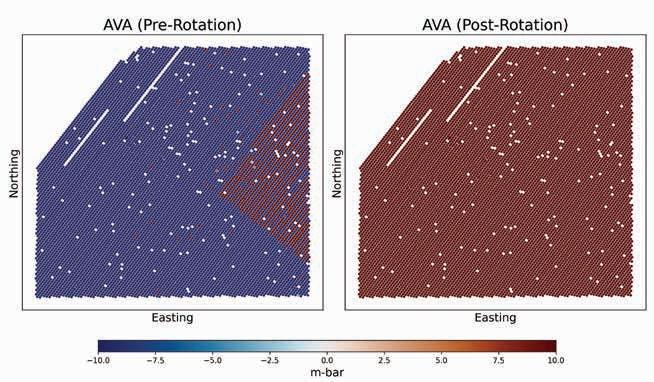

Table 1 Parameter table for Differential Evolution (DE) algorithm.
isolating direct arrivals. The RT algorithm iteratively computes tilt and orientation parameters. A transverse energy threshold, defined as a function of water depth, evaluates convergence. If unmet, iterations proceed until convergence or a maximum of


three cycles. Final estimates of p, r, and h are obtained. Variable definitions are provided in Table 1.
In this study, datasets from the KG Deepwater OBN project were utilised to evaluate the effectiveness of the proposed method and the optimiser’s ability to determine the optimal values for heading, pitch, and roll while minimising the loss function defined in Equation 6. The proposed approach significantly improved evaluation metrics when applied to the entire dataset.
Figure 5 presents the average radial energy before and after rotation. Post-rotation, the radial component’s energy increased notably, especially in the shallower region (Northwest), with Overall Radial Energy (ORE) rising from 264.99 to 497.65. Likewise, Figure 6 illustrates the average transverse energy distribution, which was initially high before rotation. After applying the correct tilt and orientation parameters, average transverse energy was effectively minimised, with Overall Transverse Energy (OTE) decreasing from 267.13 to 0.22.
Additionally, most receivers initially exhibited a negative vertical component due to the vertical axis pointing toward the




Figure 12 A sample of a partial dataset node displaying the field-recorded Inline (a), Crossline (b), and Vertical (c) components. Post-rotation views include Inline (d), Crossline (e), and Vertical (f) which are perfectly aligned towards true inline and Crossline direction. Pre-rotation representations of Radial (g), Transverse (h), and Vertical (i) components, followed by post-rotation Radial (j), Transverse (k), and Vertical (l) showing very minimal transverse amplitude. The negative amplitudes are on the eastern part of (d) properly aligning along the true inline direction, The negative amplitudes are on the northern part of (e) properly aligning along the true crossline direction, and vertical amplitude (f) are positive.
positive z-axis, indicating that the polarity was flipped because of upside-down deployment. After rotation, polarity of the vertical components was restored to their correct configuration, as depicted in Figure 7, with the Positive Vertical Node Percentage (PVNP) improving from 7.55% to 100%. Another key performance metric, the Log Ratio of Radial and Transverse Energy (LRRTE), is shown in Figure 8, demonstrating a significant increase in this metric for each node post-rotation, with Mean Log Ratio of Radial and Transverse Energy (MLRRTE) rising from 2.88 to 6.24.
The water depth was classified into four categories: 0–200 m (Category A), 200-500 m (Category B), 500-1000 m (Category C), and 1000-1800 m (Category D). As summarised in Table 2, the post-rotation OTE remained consistently low across all depth categories, demonstrating the algorithm’s robustness in different depth conditions. Similarly, MLRRTE exhibited an increasing trend across all depth groups. A clear pattern emerged where ORE and OTE decreased with increasing water depth, which can be attributed to greater attenuation of direct arrival energy in deeper water compared to shallower depths. Similarly, MLRRTE also decreased with water depth due to the decline in ORE with water depth, which appears in the numerator of its calculation.
The scatter plot in Figure 9 illustrates the relationship between Average Transverse Energy (ATE) and Average Radial Energy (ARE) before and after rotation. Pre-rotation data exhibited high ATE and lower ARE, indicating significant transverse energy. In contrast, post-rotation data showed a reduction in ATE and an increase in ARE, confirming the proposed method’s effectiveness in aligning energy along the radial direction. Similarly, the ATE vs. Water Depth scatter plot in Figure 10 demonstrates a consistent decrease in ATE with increasing water depth, with post-rotation ATE significantly lower than pre-rotation values, further validating effective energy realignment. The ARE vs. Water Depth scatter plot in Figure 11 shows a decreasing trend in ARE with increasing water depth, while post-rotation ARE is generally higher than pre-rotation, further supporting improved radial energy alignment.
The proposed method effectively handled nodes with partial datasets, noisy data, and those positioned at the survey edges with skewed shot distributions. Figure 12 presents an example of a partial dataset before and after rotation, while Figure 13 illustrates a noisy node’s pre- and post-rotation comparison. Although the method successfully rotated noisy datasets, some vertical energy was redistributed among inline and crossline



Figure 13 A sample of a node with noisy dataset displaying the field-recorded Inline (a), Crossline (b), and Vertical (c) components. Post-rotation views include Inline (d), Crossline (e), and Vertical (f) which are perfectly aligned towards true inline and Crossline direction. Pre-rotation representations of Radial (g), Transverse (h), and Vertical (i) components, followed by post-rotation Radial (j), Transverse (k), and Vertical (l) showing very minimal transverse amplitude other than the noisy traces which is showing its presence across all domains after rotation.
components, making them noisy as well. The most effective solution in such cases is to discard traces associated with noisy shot points, preventing unwanted energy redistribution. Similarly, Figure 14 compares a node at the survey edge before and after rotation, while Figure 15 compares a node deployed in the vicinity of obstruction pre and post rotation, demonstrating the robustness of the proposed method under diverse scenarios. A polarity reversal of the direct arrivals is notably observed near the midpoint of the gather, in the inline component of the inline gather (Figure 16) and the crossline component of the crossline gather (Figure 17) after applying rotation correction. This observation further confirms the effectiveness of the proposed method in accurately correcting receiver orientation.
This study introduced an optimisation-based rotation correction method for OBN data using the Differential Evolution Stochastic Search Algorithm. The proposed approach effectively estimated the optimal heading, pitch, and roll values, aligning all components with their true orientations by minimising transverse energy and at the same time maximising the radial energy. This ensured amplitude consistency across



14 A sample of a node which was deployed on the survey boundary, displaying the field-recorded Inline (a), Crossline (b), and Vertical (c) components. Post-rotation views include Inline (d), Crossline (e), and Vertical (f) which are perfectly aligned towards true inline and crossline direction. Pre-rotation representations of Radial (g), Transverse (h), and Vertical (i) components, followed by post-rotation Radial (j), Transverse (k), and Vertical (l) showing very minimal transverse amplitude.
the survey area. The method demonstrated robustness across varying water depths and challenging conditions, including partial datasets, noisy receivers, and survey-edge receivers. The results confirm that this approach provides a reliable solution for correcting OBN sensor misalignment in realworld seismic surveys.
Notably, the study was conducted in water depths as shallow as 106 ms. Future research could explore the method’s applicability in even shallower waters to further assess its performance under more constrained deployment conditions. Future study may include testing this approach on shallower OBN datasets.
I sincerely express my gratitude to ONGC for granting me permission to utilise the data for this study.
The data used in this study is proprietary and owned by ONGC. Due to confidentiality agreements and internal restrictions, the data cannot be shared publicly. Views expressed in this paper are that of the author and may not necessarily be that of ONGC Ltd.



15 A sample of a node which was deployed in the vicinity of an obstruction, displaying the field-recorded Inline (a), Crossline (b), and Vertical (c) components. Post-rotation views include Inline (d), Crossline (e), and Vertical (f) which are perfectly aligned towards true inline and crossline direction. Pre-rotation representations of Radial (g), Transverse (h), and Vertical (i) components, followed by post-rotation Radial (j), Transverse (k), and Vertical (l) showing very minimal transverse amplitude.


References
Ahmad, M.F., Isa, N.A.M., Lim, W.H. and Ang, K.M. [2022]. Differential evolution: A recent review based on state-of-the-art works. Alexandria Engineering Journal, 61(5), 3831-3872. https://doi.org/ https://doi.org/10.1016/j.aej.2021.09.013.
Amini, A., Peng, H., Zhang, Z., Huang, R. and Yang, J. [2016]. Joint inversion of water velocity and node position for ocean-bottom node data. In SEG Technical Program Expanded Abstracts 2016, pp. 5490–5494. https://doi.org/doi:10.1190/segam2016-13964730.1. Barnes, E., Soliman, M. and Cooper, C. [2024]. An Efficient OBN Acquisition and the Processing Consequences. 85th EAGE Annual Conference & Exhibition, Extended Abstracts . https://doi. org/10.3997/2214-4609.202410150.
Eltaeib, T. and Mahmood, A. [2018]. Differential Evolution: A Survey and Analysis. Applied Sciences, 8(10). https://doi.org/10.3390/ app8101945.
Gaiser, J.E. [1999]. Applications for vector coordinate systems of 3-D converted-wave data. The Leading Edge, 18(11), 1290–1300. https:// doi.org/10.1190/1.1438202.
Lawton, D.C. and Wang, S. [1994]. Converted-wave (P-SV) processing and interpretation for 3-D surveys: A physical modeling example. In SEG Technical Program Expanded Abstracts 1994, pp. 1445–1448. https://doi.org/doi:10.1190/1.1822807.
Figure 16 Seismic sections of an Inline gather showing Inline (a), Crossline (b), and Vertical (c) components before rotation, and Inline (d), Crossline (e), and Vertical (f) components after rotation. Note the polarity reversal in the Inline component postrotation, indicated by the black circle.
Figure 17 Seismic sections of a Crossline gather showing Inline (a), Crossline (b), and Vertical (c) components before rotation, and Inline (d), Crossline (e), and Vertical (f) components after rotation. Note the polarity reversal in the crossline component postrotation, indicated by the black circle.
Li, X., Dai, H. and Mancini, F. [2007]. Converted-wave imaging in anisotropic media: theory and case studies. Geophysical Prospecting, 55(3), 345-363. https://doi.org/10.1111/j.1365-2478.2007.00612.x.
Palais, B., Richard, P. and Rodi, S. [2009]. A Disorienting Look at Euler’s Theorem on the Axis of a Rotation. The American Mathematical Monthly , 116(10), 892-909. https://doi. org/10.4169/000298909X477014.
Patterson, F. [2016]. Data driven Orientation Determination of Multicomponent Seismic Sensors [Delft University of Technology]. https:// resolver.tudelft.nl/uuid:8d87b84d-b53d-476d-a85e-5cc115f7cd47.
Storn, R. and Price, K. [1997]. Differential Evolution – A Simple and Efficient Heuristic for global Optimization over Continuous Spaces. Journal of Global Optimization , 11(4), 341-359. https://doi.org/10.1023/A:1008202821328.
Tellier, N. and Herrmann, P. [2023]. MEMS-based OBN: Lessons Learnt from the Largest OBN Survey Worldwide. First Break, 41(11), 71-79. https://doi.org/10.3997/1365-2397.fb2023093.
Wang, X., Chen, Q., Li, J. and Wei, S. [2016]. Seismic Sensor Misorientation Measurement Using P-Wave Particle Motion: An Application to the NECsaids Array. Seismological Research Letters, 87(4), 901-911. https://doi.org/10.1785/0220160005.

Marcella Rapini Braga1*, Gilberto Rodrigues de Lima1, Bruno Chaves Moreira Gomes1, Moacyr de Souza Bezerra1, Danilo Santos Cruz1 and
Andrea Carvalho Damasceno1
Abstract
We conducted a feasibility study on the processing of converted PS waves for an OBN (ocean bottom node) acquisition parameterised for PP data only. The PS seismic data was preconditioned and prepared as input for tomographic iterations to update the Vs velocity. Available geotechnical measurements were combined with an empirical model to construct the very shallow Vs velocity from the water bottom up to 200 m. From 200 m to the basement, the initial VS model was built using a predefined conversion pattern using the legacy PP velocity. After several tomographic steps, an initial set of images, migrated with Kirchhoff algorithm, presented several identifiable PS events in the PP volume. Refinements of Vs field, conducted by PP-PS correlation, improved the quality of PS data, mainly below the salt layer. Finally, partial stacks served as input data to a joint PP-PS elastic inversion test which resulted in a S impedance volume much closer to well data than the one derived from inversion of PP data only.
The number of offshore multi-component seismic acquisitions has been growing in Brazil in the last 15 years due to the need to study increasingly complex areas (Cruz et al., 2021). Processing of compressional wavefield (PP) recorded in these seismic data has been evolving over time, mainly in the pre-migration processing and compressional wave velocity (Vp) model-building for imaging (Ristow et al., 2024). Seismic cubes with higher azimuthal richness and spectral bandwidth have been obtained, with an excellent quality of the velocity model due to the incorporation of the full waveform inversion (FWI) technique into the workflow (Jouno et al., 2019; Brando et al., 2023; Casado et al., 2024).
On the other hand, the processing of converted PS wavefield is still in its early stages, mainly due to the challenges of sampling this wavefield. The shear wave propagation velocity (Vs) is lower than Vp, which requires much denser acquisitions than the ones acquired nowadays (Davydenko et al., 2016), usually in the order of 500 x 500 m receiver grid. Properly sampling this wavefield in shallower portions is an even more challenging task (Gaiser, 2016). Seismic surveys with such density are impractical due to the high cost and operational issues such as limited battery time and the total number of available receivers.
Previous attempts at processing PS data in an offshore environment using Ocean Bottom Sensors have been successful, although with smaller receiver spacing and shallower water depths (Ata et al., 2013, D’Afonseca et al., 2014). We investigated the viability of processing converted wave signal in an OBN
1 PETROBRAS
* Corresponding author, E-mail: mrapini@petrobras.com.br DOI: 10.3997/1365-2397.fb2025083
acquisition, with a receiver spacing (in this case, 500 m) that was optimised for the PP data. We selected the seismic data from a project in Santos Basin, Brazil, and applied the following processing steps: pre-processing, imaging, and Vs model building.
The survey is in Santos Basin, an Atlantic pull apart basin with three major stratigraphic sequences: Post-, Intra- and Pre-Salt, with reservoirs in the Pre-Salt sequence, offshore Brazil (Figure 1) (Formigli, 2008).
The OBN data was acquired in the years 2018/2019. This was a large-scale acquisition, with a receiver area of 1621 km2 and 6602 receiver stations with 4 components: 1 hydrophone and 3 geophones. The receivers were arranged in a 500 x 500 m grid,


and the shooting grid has a sampling of 50 x 50 m. We selected an area of 677 km2 for this pilot processing project (red rectangle in Figure 2) and 3051 receivers for imaging this area. The water depth in the pilot area ranges from 1740 to 2030 m.
The processing of the PP wavefield was done previously, right after the completion of the acquisition, to obtain a precise, reliable and high-resolution full azimuth subsurface seismic image, especially in the pre-salt depth, allowing structural and stratigraphic interpretation and prospect evaluation. The pre-processing flow consisted of several important steps such as travel time inversion for node position, water velocity variation and residual clock drift; geophone reorientation; source ghost attenuation and wavefield separation (upgoing and downgoing). Regarding the PP velocity model building, the processing team built a TTI (transverse tilted anisotropy) model by applying the two main techniques available: tomography and FWI (full wave-
form inversion, from total wavefield) (Zhigang et al., 2018). The following iterations were performed:
1. Water velocity update
2. Post-salt tomography 1
3. Post-salt FWI
4. Post-salt tomography 2
5. Top salt interpretation and salt flooding
6. Intra-salt FWI and tomography
7. Base of salt interpretation and initial pre salt model (gradient)
8. Pre-salt tomography and FWI
The use of FWI in the velocity model-building was essential to create a model that is geologically consistent and matches the well data (sonic logs and tops). The final P-wave imaging data was generated by using both Kirchhoff and RTM 45 Hz

algorithms. For imaging the converted PS wavefield, the Vp and anisotropic parameters were not updated. Furthermore, we used the upgoing wavefield migrated data when comparing PP and PS data, since it displays similar sampling problems to the ones of the converted wave data.
We used auxiliary data for the initial Vs model building and quality control: well logs and Vs measurements in the shallow part from geotechnical wells.
There were 31 wells available in the pilot area at the time the project started. The conventional sonic logs were available for all of them, but only a few had the sonic dipole log acquired.
After an initial QC of the log data, we observed that the postsalt sedimentary sequence presented no data in most of the wells. Most of the wells had data only in the reservoir interval and some had information also in the salt dome areas, as illustrated in figure 3. The lack of consistent information for shear-wave velocity in the entire interval was an issue for building and analysing the quality of the Vs model, mainly in the 0-500 m depth from the water bottom horizon.
The Vs measurements in the very shallow part (0 to 60 m) were crucial to define the shear velocity behaviour in the deeper section. In this shallow portion, Vs is very low and consequently, the Vp/Vs ratio can be anomalously high (values greater than 10 can be observed). There were eight profiles of geotechnical wells available in the full acquisition area but only two in the pilot area, as shown in Figure 4.
The geothecnical wells were acquired in 2022 (Baziw et al., 2017). The equipment used in this campaign is mounted with two hydraulic hammers in opposite horizontal directions on its stern foot to generate shear waves at the mudline. The seismic probe has two triaxial geophones mounted 1 m apart for recording the seismic signals.

The interval velocity is calculated by measuring the difference of shear wave arrival times between two geophones using the below formula,
where L2 and L1 are the assumed travel paths from mudline to the lower and upper geophones, respectively. The difference between these two geophones is fixed at 1 m and seismic data was acquired at a sampling rate of 0.25 miliseconds. The Vs profiles have a final spatial sampling of 3 m and maximum depth of 60 m, approximately. Results will be shown in the next section.
We applied the following pre-processing steps to prepare the seismic data for the shear velocity model-building with Kirchhoff imaging: noise attenuation, reorientation (Radial-Transverse), source deghosting, zero-phasing and bubble attenuation. The input data was the set of raw field data which contained calculated corrections (derived from the PP data) in its headers: receiver positioning, clock-drift, subsample, and water velocity correction. Therefore, these corrections were applied to the data. The amount of bubble energy in the radial data was unexpected and required a debubble step added to the original processing sequence. It is worth mentioning that the binning steps for the COV (common offset vector) domain with a cell size of 1000 m in a hexagonal grid and we applied Voronoi weights before the final Kirchhoff migration to correct for amplitude variations due to trace fold fluctuation. We did not apply the receiver statics correction to the data. Therefore, we did not update the Vs velocity using such information (since it was not possible to access it in a deep water OBN geometry).
We built the initial Vs model for the tomographic update process as follows:
1. Vs measurements at depths of 0-60 m below the seafloor (8 profiles).
2. Empirical equation from 60 to 200 m depth below the seafloor (Suarez, 2005).
3. Vs volume provided by the asset team for the post-salt after smoothing.
4. Vs calculated from Vp using a nearly constant Vp/Vs ratio within the salt.
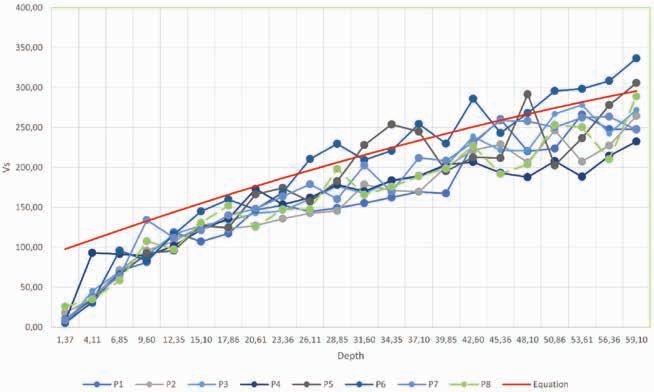

In Figure 5, there are the Vs measurements from the 8 profiles mentioned in the previous section (lines with dots), compared to the empirical equation (Suarez, 2005) in red.
It is noticeable that, on average, the measured values are lower than those predicted by the equation. However, we did not access the lateral variation of Vs due to the small number of measurements in the pilot area, then an average velocity profile was used for the processing area. The use of lower velocity values in the ultra-shallow part (0-60m) resulted in preliminary seismic sections with a top salt horizon closer to the interpreted horizon from the PP data.
Finally, using the initial Vs described above and the other model parameters (Vp, delta, epsilon, theta, and phi) obtained from PP wave processing, we performed five tomographic inversions to update the Vs model only, as follows:
1. Tomography in post-salt sediments.
2. Vp/Vs analysis and editing.
3. Tomography in post-salt sediments.
4. Global tomographic update.
5. Intra-salt editing.
6. Tomography in the salt and pre-salt regions.
7. Final tomography in the pre-salt portion.
The migrated gathers used as input for tomography were split into 6 azimuth sectors, each azimuth corresponding to 60 degrees interval. To improve the continuity of the events for moveout picking, a set of spatial median filters were applied to the data. For the two tomographies aimed at the post-salt sequence, we have selected CRP gathers that are closer to the receiver positions since they have a more homogeneous amplitude distribution of the events.
A FWI algorithm for updating Vs is in development and could not be tested in this project.
After updating the Vs volume in the post-salt, intra-salt, and presalt columns, we observed a significant improvement both in the calculated Vp/Vs ratio cube (Figure 7) and in the seismic image of the PS wavefield. The output Vp/Vs ratio shows more details and lateral changes, mainly in the pre-salt portion of the section.
The PS seismic imaging step was performed using an acoustic Kirchhoff algorithm adapted to PS-type conversions. The Kirchhoff algorithm was not modified but we calculated the travel times using Vs for the path between conversion point


and receiver position. Figure 8 shows a comparison between a crossline of the migrated PP upgoing section, and the migrated PS section with final filters applied (curvelet domain filtering and structural consistent filtering). In the region of the red circle, there is a good correlation between the events in both sections, including the faults. In the blue circle, there is a strong and coherent signal in the PS section, with structures that are consistent with the PP image. There is also a degradation of the signal below the thicker salt layer.
We tested an RTM imaging algorithm adapted for PS imaging and the preliminary results indicated a major uplift in the imaging of complex structures like salt flanks. However, due to high computational cost, the RTM algorithm could not be applied to the pilot area during the project and results are not included in this paper.
After having the first Kirchhoff migrated PS cube, the correlation analysis between the PP and PS data in depth indicated that the velocity still showed incorrect values in the shallow part, between 100 and 1000 m below seabed, causing differences in depth of the main post-salt horizons between the two datasets. As the quality of the gathers prevented better updates of the velocity via tomography, we tested a new procedure based on PP-PS registration.
We generated nine perturbed Vs volumes (ranging from 92 to 108 % of the Vs input model) between two shallow horizons, approximately 100 to 1000 metres below the seabed. From the perturbed velocities, we had migrated inlines (every 40 inlines) for each perturbation scenario. We built a new Vs volume from the picked perturbated values that varied laterally. This interpretation in the migrated images was made based on the criteria of highest correlation between the depths of the PP and PS data in the perturbation region. After that, the velocity volume was smoothed and subjected to the tomographic updates from the first model-building workflow, as presented in the previous section.


Sometimes, the correlation between PP and PS amplitude sections is not straightforward since they are affected by the rock properties in different ways. Nevertheless, comparing the migrated volume before and after the refinement routine, we observed improvements in several points of the volume regarding the focus of events. Figure 9 shows improvement in the image just above and below the base of salt horizon mainly in the left portion of the section (arrows) where we have a thicker salt body.
When comparing the Vp/Vs ratio volume (Figure 10), we observed an evolution in terms of layer definition and structural correlation between this property and the main events after the final model refinement.
We performed tests of elastic inversions after the first velocity model-building flow (before the tested refinement) to assess the value of adding the PS data in the process and the results are discussed in Damasceno et al., 2025.
We demonstrated the feasibility of producing geologically consistent PS stack volumes from standard OBN data, even in challenging imaging targets and with the application of conventional adapted tools. We observed that the impact of knowing Vs in the vicinity of the seafloor, where the Vp/Vs ratio is anomalously high, sometimes exceeding values of 10, is significant. The inclusion of information from the measured Vs profiles proved to be crucial in obtaining a consistent PS image. Furthermore, the resulting shear velocity model from this workflow can be used subsequently as an input to more advanced update techniques such as elastic FWI (Bulcão et al., 2023; Cho et al., 2022; Ning et al., 2024) and shallow refraction tomography (Bezerra et al., 2022).
The S-impedance attribute has a great impact on the characterisation of pre-salt reservoirs because it may allow discrimination between lithologies that overlap in the P-impedance, in addition to contributing to the distinction of rock and fluid effects. Adding the PS volumes to the elastic inversion process will significantly improve this petrophysical characterisation of the reservoir zones since we obtain a higher quality S-impedance in terms of resolution, signal-to-noise ratio and well log match (Damasceno et al., 2021, Damasceno et al., 2025).
The authors would like to thank Petrobras and partners (CNOOC and CNODC) for giving permission to present this work. The authors acknowledge the asset team in addition to all sectors of Petrobras that made essential contributions to the project.
Ata, E., Olson, R., Mosher, C.C., Shaw, S. and Betterly, S. [2013]. Look at converted waves from an OBN test survey. SEG Technical Program Expanded Abstract, 5170-5174.
Baziw, E. and Verbeek, G. [2017]. Quality Assessment of Seismic Data Sets and the Impact on Interval Velocity Estimates in DST. Proceedings of the DFI 42nd Annual Conference on Deep Foundations, 598-608.
Bezerra, M., Simmons, J. and Gaiser, J. [2022]. Seafloor elastic parameters estimation using a regression neural network. Society of Exploration Geophysicists and American Association of Petroleum Geologists, 3671-3675.
Brando, G., Benjamin, H. and Cypriano, L. [2023]. Imaging the presalt with elastic FWI using OBN data. Third International Meeting for Applied Geoscience and Energy Expanded Abstracts, 685-689.
Bulcão, A., Almeida, A.C., Dias, B.P., Cortez, C.A.C., Soares, D.M., Alves, G.C., Barros, P.M. and Girardi, T.I. [2023]. Elastic FWI: A study on parametrization and applications of the pseudo-Hessian. Eighteenth International Congress of the Brazilian Geophysical Society, Abstract
Casado, N., Carneiro, M., Parekh, C., Barros, P., Igarashi, J. and Castro, C. [2024]. Improved Target Illumination Using High-Frequency Elastic FWI for Santos Basin OBN Surveys. Fourth EAGE Conference on Pre-Salt Reservoir, Extended Abstracts
Cho, Y., Solano, C.P., Kimbro, J., Yang, Y., Plessix, R. and Matson, K. [2022]. Influence of shear velocity on elastic full-waveform inversion: Gulf of Mexico case study using multicomponent ocean-bottom node data. Geophysics, 87(5), 391-400.
Cruz, N., Cruz, J., Teixira, L., Costa, M., Oliveira, L.B., Urasaki, E.N., Bispo, T., Jardim, M., Grochau, M. and Maul, A. [2021]. Tupi Nodes pilot: A successful 4D seismic case for Brazilian presalt reservoirs. The Leading Edge, 40(12), 886-896.
D’Afonseca, L., Krishnasamy, T., Birkeland, O.J., Guillaume, P., Santiago, T.M.G, Guerra, C. and Lima, R. [2014]. Innovative PSDM processing of OBC data on Albacora field. SEG Technical Program Expanded Abstracts, 1832-1836.
Damasceno, A., Tura, A. and Simmons, J. [2021]. The added value of joint PP–PS inversion for reservoir characterization: A case study using Jubarte PRM seismic data (offshore Brazil). Geophysical Prospecting, 70(1), 121-134.
Damasceno, A., Lima, G.R., Rapini, M. and Silva, L.M.T. [2025]. Nodes Acquisitions PS-waves Added Value: Impact of PS-stacks on Elastic Inversion for a Brazilian Pre-Salt Reservoir. 86th EAGE Annual Conference & Exhibition (including the Workshop Programme), Extended Abstracts
Davydenko, M. and Verschuur, D. [2016]. Optimal imaging of OBN data using all multiples. SEG Technical Program Expanded Abstract, 4230-4234.
Formigli, J. [2008]. Santos Basin Pre-Salt Cluster: How to Make Production Development Technical and Economically Feasible. Rio Oil and Gas Conference, Abstract
Gaiser, J. [2016]. 3C Seismic and VSP: Converted waves and vector wavefield applications. SEG Distinguished Instructor Short Course, 155-200.
Jouno, F., Martinez, A., Ferreira, D., Donno, D. and Khalil, A. [2019]. Illuminating Santos Basin’s pre-salt with OBN data: Potential and challenges of FWI. SEG Technical Program Expanded Abstract, 1345-1350.
Ning, I., Tan, J. and Dash, R. [2024]. Sparse ocean bottom node seismic interferometry and inversion: A Gulf of Mexico study. Fourth International Meeting for Applied Geoscience & Energy, 18301834.
Ristow, J., Lanznaster, D. and Jouno, F. [2024]. Advances in OBN Imaging for Pre-Salt Fields. 85th EAGE Annual Conference and Exhibition, Extended Abstracts
Rodriguez-Suarez, C. [2005]. Sea-bottom shear-wave velocities and mode conversions. Revista Brasileira de Geofísica, 23(1), 75-87.
Zhigang, Z., Mei, J., Lin, F., Huang, R. and WangZhang, P. [2018]. Correcting for salt misinterpretation with full-waveform inversion. SEG Technical Program Expanded Abstracts, 1143-1147.

Geoscientists are continuing to innovate seismic solutions for hydrocarbon exploration and Energy Transition projects such as carbon capture and storage along with offshore wind projects. Papers this month demonstrate how companies are improving data acquisition in global hotspots with latest applications in MultiAzimuth, Triple Source Configuration and Full Wave Inversion.
Alexey Dobrovolskiy describes the challenges and solutions involved in integrating MBES and SSS systems with UAVs.
Eric Mueller et al demonstrate why multi-azimuth (MAZ) multi-sensor towed streamer seismic data are an efficient and competitive means to providing significantly improved imaging of South Viking Graben (SVG) margin flanks and graben centres.
Karyna Rodriguez et al demonstrate why the shared tectonostratigraphic evolution with the conjugate margin of the southwestern Atlantic (northern Argentina, Uruguay and southern Brazil) provides a robust analogue for the development of exploration models, petroleum system assessments, and play-based evaluations in the South Atlantic region.
Ian Setterfield discusses how the industry is meeting the data management challenge that is holding back seismic data innovations in the marine seismic sector.
Julien Large et al describe an optimised survey design that encourages the industry to acquire data using a triple-source configuration with the TPS.
Ali Tura et al demonstrate recent industry applications of PS-wave data to show improvements in elastic Full Waveform Inversion (FWI), quantitative direct hydrocarbon indications, subsalt reservoir characterisation, imaging under complex overburden such as shallow gas, enhanced time-lapse seismic analysis and estimation of pore pressure in the overburden and reservoir.
First Break Special Topics are covered by a mix of original articles dealing with case studies and the latest technology. Contributions to a Special Topic in First Break can be sent directly to the editorial office (firstbreak@eage.org). Submissions will be considered for publication by the editor.
It is also possible to submit a Technical Article to First Break. Technical Articles are subject to a peer review process and should be submitted via EAGE’s ScholarOne website: http://mc.manuscriptcentral.com/fb
You can find the First Break author guidelines online at www.firstbreak.org/guidelines.
January Land Seismic
February Digitalization / Machine Learning
March Reservoir Monitoring
April Underground Storage and Passive Seismic
May Global Exploration
June Navigating Change: Geosciences Shaping a Sustainable Transition
July Reservoir Engineering & Geoscience
August Environment, Minerals and Infrastructure
September Modelling / Interpretation
October Energy Transition
November Marine Acquisition
December Data Management and Processing
More Special Topics may be added during the course of the year.
Alexey Dobrovolskiy1* describes the challenges and solutions involved in integrating MBES and SSS systems with UAVs.
Abstract
We present the integration of a lightweight multi-beam echosounder (MBES) and side-scan sonar (SSS) with a UAV platform. A custom dual-hinge foldable mount and dedicated data-logging workflow allow the MBES head to be georeferenced directly, achieving accuracy comparable to established SBES and USV surveys while offering superior spatial resolution. Field tests in Latvian lakes and rivers demonstrate feasibility, highlight logistical advantages, and show complementary roles of MBES and SSS. This work outlines a practical approach to UAV-based hydrography and expands the toolkit for shallow-water surveying.
Introduction
Bathymetric surveying of inland and coastal waters is a rapidly growing application for UAV-mounted sensors. Several technologies are already used for this purpose, including green (bathymetric) LiDAR, low-frequency ground-penetrating radar (GPR), and single-beam echosounders (SBES). Each of these methods has inherent limitations: restricted depth penetration, sensitivity to water flow, dependence on water clarity and conductivity, and limited capability to resolve bottom features, achieve full coverage, or provide adequate data density.
Although these technologies are widely used, the most advanced bathymetric instruments—multi-beam echosounders (MBES) — have until recently been confined to ships and manned or unmanned boats. This was due to their size, weight,
and the complexity of data acquisition. Mounting MBES on floating platforms also requires direct water access and typically involves significant mobilisation and logistics costs, even when using small USVs. In recent years, however, advances in sensor miniaturisation and UAV capabilities have opened the possibility of carrying MBES on small-to-medium-class aerial platforms.
In 2024, the US company Cerulean Sonar introduced the Surveyor 240-16, a lightweight MBES weighing less than 800 g. Its compact design makes it well suited for UAV integration. Despite our prior experience integrating a wide range of sensors — including SBES and GPR — adapting MBES required nearly a year of experimentation with mounts, suspension systems, and workflows. The final solution was a foldable dual-hinge mount combined with custom data-logging software, designed to meet the specific requirements of MBES operation on a UAV platform.
Integrating MBES with UAV platforms poses significant engineering challenges because of competing requirements. The most critical is the need to know the precise position and attitude of the MBES sensor head for every ping, while keeping the system lightweight, affordable, and compatible with typical UAV payload limits. Multi-rotor UAVs must also retain full freedom of pitch and roll to remain airborne, so the payload must not introduce inertia that restricts control. A straightforward option

1 SPH Engineering
* Corresponding author, E-mail: adobrovolskiy@sphengineering.com DOI: 10.3997/1365-2397.fb2025084

would be to mount the required sensors on a UAV-towed float carrying the MBES head, IMU, compass, and RTK/PPK GNSS receiver. However, this solution has major drawbacks: it complicates take-off and landing, performs poorly in wind, adds weight, reduces effectiveness in currents and waves, and duplicates sensors already available on most industrial UAVs.
The Surveyor 240-16 MBES includes integrated pitch and roll sensors, so the missing elements for full attitude determination are heading and the XYZ position of the MBES sensor. Modern UAVs already provide this information through their onboard GNSS receiver, compass, and IMU. The main challenge, therefore, was to design mounts and data-logging algorithms that could combine MBES outputs with the UAVs built-in sensors for accurate recording and geotagging. Our first prototype, assembled in just a day or two, used a corrugated cable pipe as a flexible mount. When fully extended, it prevented rotation of the MBES head in the XY plane while still

allowing the UAV the necessary freedom of movement to carry or tow the relatively heavy sensor.
The first prototype demonstrated the feasibility of MBES integration, validated the concept of attitude information fusion, and enabled initial testing and optimisation of the data-logging code. However, despite its simplicity and very low cost, data quality and stability were inadequate: the heading of the MBES head relative to the UAV varied significantly, producing unsatisfactory results in most cases. After three design iterations, we arrived at a foldable dual-hinge mount.
The upper hinge (a cardan joint) with quick-release attachment to the UAV allows forward–aft and left–right movement while preventing rotation, ensuring that when unfolded, the MBES head maintains the same heading as the UAV. The middle hinge simplifies take-off and landing and keeps the payload compact for transport. The MBES head itself is enclosed in a housing that protects the sensor and reduces drag in the water.
With this dual-jointed design, the position of the sensor head relative to the UAV (and its GNSS antenna) changes with the UAV’s speed over the water. For accurate results, however, we require the XYZ coordinates of the MBES head, not the UAV. Our initial approach was to measure the MBES head offset behind the UAV and its vertical separation from the GNSS antenna at a recommended survey speed. This speed was determined experimentally as the ‘economical speed’ at which the UAV could tow the submerged sensor. By photographing the UAV in flight along survey lines and checking the data, we measured the horizontal and vertical offsets. The results were satisfactory for survey lines flown at constant speed.
Fixed offsets proved unreliable at different UAV speeds relative to the water, during manual surveys with variable speed, or in rivers where the UAV’s course shifts against the flow. To address this, we adopted a new approach: instead of applying fixed offsets in post-processing, we calculated the average ratio





between the inclination angles of the upper and lower sections of the foldable mount. Using this ratio together with pitch and roll data from the MBES head’s built-in sensors, we could precisely compute the real offset of the sensor relative to the UAV. In this way, the MBES data are geotagged directly with the XYZ coordinates of the sensor head itself.
Figure 5 EchoNIMBUS-MBES mounted on a commercially available UAV. Top: fully folded mount with the UAV on the ground; bottom left: fully extended mount with the MBES head above the water; bottom right: UAV in flight on a survey line.
Figure 6 Patch Test implemented in BeamworX AutoPatch software using data collected with a dronemounted MBES.
Figure 7 Example of an under-surveyed area at shallow depth.
Accurate data processing requires precise knowledge of the alignment between the MBES head and the pitch, roll, and heading sensors. In practice, roll, pitch, and heading offsets are applied during processing to correct for misalignments and systematic sensor errors. These offsets are determined
through a procedure known as a Patch Test. The concept is similar to airborne LiDAR processing, but with one important difference: airborne LiDAR collects orders of magnitude more points, so standard survey lines usually provide enough data to estimate offsets. MBES data are much sparser, which makes a dedicated calibration procedure essential. In its simplest form, the calibration requires surveying two lines, with each line run twice in opposite directions, and with at least 50% overlap between the lines. Most MBES processing software can then compute the mounting angle offsets from this dataset. The same procedure applies to UAV-mounted MBES systems.
The good news is that the Patch Test does not need to be repeated for every survey. It is only required when the system configuration changes, and the resulting offsets can then be reused for an extended period. In our case, the same offsets were applied successfully across multiple surveys in Latvia between July and September 2025.
One limitation of the current UAV-integrated MBES system is that the survey grid remains fixed while the UAV follows its pre-planned route. If the survey area includes large depth variations, this can result in excessive overlap in deeper zones



8 MBES survey planned in UgCS Expert ground-control software. A regular survey grid is supplemented with additional laps along the banks to improve coverage of shallow areas.
10 MBES data overlaid with an SBES data stripe (shown in silver for visibility) and a cross-section comparing outputs from multiple bathymetric systems.

and data gaps in shallower zones. For example, in one project (Figure 6), depths ranged from 2 to 37 m; applying a constant line spacing across the entire area would have caused both inef-

ficiency and incomplete coverage. To avoid this, we recommend dividing the survey area into subareas and adjusting line spacing according to the expected depth.
For water bodies such as ponds or lakes, where the shallowest areas are usually near the banks, we recommend adding one or two laps along the shoreline to ensure complete bathymetric coverage in the shallowest zones.
Of course, none of this matters if the system cannot deliver accurate data. To evaluate performance, we carried out multiple tests in several Latvian water bodies, including Titurga Ezers (lake) — likely the most surveyed lake in the country, as we have used it for bathymetric testing since 2021, beginning with UAV-integrated SBES. For this site, we hold reference datasets collected with various platforms: several UAV-mounted SBES models (EchoLogger ECT400 single-frequency, ECT D052 dual-frequency, and ECT D24 dual-frequency), an Apache 3 USV with a D230 single-frequency SBES, and an OceanAlpha SL40 USV with a GeoSwath 4 bathymetric side-scan sonar.
A thorough comparison of overlapping datasets showed that the drone-mounted MBES delivers accuracy equivalent to established SBES systems, while clearly outperforming them in data density and resolution. Over flat bottom areas, depth and elevation differences were negligible. In rougher terrain, deviations appeared in both directions, reflecting the higher resolution of MBES compared with SBES.

A striking demonstration of MBES resolution came from a survey of a sand quarry, which revealed intricate bottom features created by suction dredging. These fine details were



almost invisible in the SBES dataset, even when collected with a tight 3 m survey grid (Figure 11).
A relatively large survey (by UAV standards) was carried out at the confluence of the Daugava and Perse rivers. Water levels in this area were raised following construction of the Riga Hydroelectric Power Plant dam. The MBES survey revealed the former channel of the Perse River as well as the remains of an old bridge, now submerged. A key challenge during this project was avoiding navigation traffic while flying the UAV across the 480 m–wide Daugava River.
Encouraged by the success of MBES integration, we next experimented with side-scan sonar. Historically, demand for UAV-mounted side-scan sonar had been limited, mostly arising from tragic events such as searches for drowned persons in hard-to-access areas. These requests were too infrequent to justify a full integration effort from scratch. However, the Cerulean Omniscan 450SS side-scan sonar offered a similar software interface and comparable weight to the already integrated Cerulean Surveyor 240-16 MBES, which motivated us to test this technology. The manufacturer kindly provided a loan unit, and the first prototype was developed in record time: one week of mechanical design, a few hours of 3D printing, and a couple of days of software development to adapt the existing MBES data-logging code. Not only the software but also the foldable mount concept — originally created in 2022 for magnetometers — were reused (Figure 14).
In our first test at Titurga Lake, the SSS data revealed a sunken boat (Figure 15). This is a known wreck, first detected in 2024 during our demo days using an OceanAlpha SL40 USV with a GeoSwath 4 bathymetric side-scan sonar. Interestingly, the wreck is barely visible in the MBES dataset and could only be identified because its coordinates were already known — a clear demonstration of the differences between the two sonar technologies.
UAV-mounted MBES has matured into a practical alternative to vessel-based shallow-water hydrography. With a lightweight dual-hinge mount, direct geotagging of MBES data, and reuse of existing UAV sensors, the system achieves accuracy on par with SBES while offering higher data density and finer resolution. SSS integration further broadens the scope, enabling efficient target detection and habitat mapping. Together, these advances make UAVs a versatile and cost-effective platform for bathymetric surveying in inland waters, reservoirs, and other environments where vessel operations are constrained.
Eric Mueller1*, Martin Widmaier1 and Julien Oukili1 demonstrate why multi-azimuth (MAZ) multi-sensor towed streamer seismic data are an efficient and competitive means to providing significantly improved imaging of South Viking Graben (SVG) margin flanks and graben centres.
Introduction
Multi-azimuth (MAZ) multi-sensor towed streamer seismic data are an efficient and competitive means to providing significantly improved imaging of South Viking Graben (SVG) margin flanks and graben centres. Flexible survey design and acquisition efficiency combined with modern processing and velocity model-building workflows create a step up in data quality to image potential new plays in the otherwise mature North Sea rift system. Data quality and MAZ illumination allow imaging of Upper Jurassic lateral successions of fault scarp graben edges, details of terrace floor gravity flow deposits, terrace incisions and basin floor fans extending out on the graben centre at current burial depths greater than 4000 m.
From novel acquisition concepts to an integrated exploration solution
In 2019 an innovative towed-streamer multi-azimuth acquisition and imaging concept branded as GeoStreamer® X was piloted in the Viking Graben (North Sea) as a cost-effective and intelligent solution for high-definition exploration. The initiative aimed to enhance the value of multi-client multisensor ‘broadband’ exploration data acquired in the North Sea and Norwegian Sea offshore Norway during the previous 10 years. Evolving imaging and velocity model-building technologies, e.g., full waveform inversion (FWI), as well as the need for higher resolution, improved illumination, and more accurate subsurface images for interpretation of a variety of exploration targets formed the basis for modern survey designs and advanced acquisition technologies.
Over that past decade, exploration campaigns in areas such as the Viking Graben were typically conducted using narrow azimuth towed-streamer configurations. These surveys used dual-source setups with 6 to 10 streamers spaced 100 m apart, and approximately 6000 to 7000 m in length. The legacy configurations resulted in crossline acquisition bin sizes of 25 m and thus limited resolution. The relatively sparse source-line sampling led to limited near-offset coverage, which in turn
1 TGS
* Corresponding author, E-mail: Eric.Mueller@tgs.com
DOI: 10.3997/1365-2397.fb2025085
compromised imaging of the shallow overburden and introduced the so-called shallow ‘acquisition footprints’. While the seismic offsets acquired during these campaigns were well-suited for reflection imaging and move-out-based velocity model-building, they were insufficient for refraction-based full waveform inversion targeting deeper exploration objectives offshore Norway.
Recent advances in seismic vessel capabilities, streamer inventory, and towing and handling systems for sources and streamers have expanded the solution space for smarter survey designs (Widmaier et al., 2019). These improvements enable better integration with advanced imaging technologies, without necessarily increasing the cost or turnaround time of seismic exploration surveys.
One of the key configuration changes compared to legacy multi-client library data was the shift from a standard dual-source setup to a wide-tow multi-source configuration, particularly the introduction of a wide-tow triple-source geometry. Increasing the number of sources from two to three reduces the crossline bin size by approximately 33%, assuming constant streamer separation, and even more when streamer spacing is reduced simultaneously.
To maintain fold and inline source sampling with the triple-source setup, the source firing interval had to be shortened. Any potential loss in acquisition efficiency due to reduced streamer separation was effectively mitigated by increasing the number of streamers to 14.
The wider towing of source arrays was introduced to improve the distribution of near-offset traces compared to legacy acquisition configurations (e.g. Widmaier et al., 2021). Traditionally, marine source arrays were positioned in front of the two central streamers, with a nominal source separation determined by dividing the streamer separation distance by the number of source arrays. In contrast, the wide-tow triple-source configuration introduced a source separation that exceeded the streamer separation. This adjustment significantly enhanced shallow imaging quality without compromising efficiency.
Another smart enhancement to the acquisition setup was the introduction of variable streamer lengths. For high-defi-

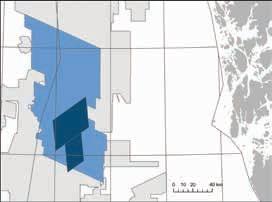
Figure 1 Adding two new acquisition directions to an existing survey. While the legacy data was acquired with dual source and standard streamer spread, the new data acquisition comprised wide-tow triple sources and streamer tails. Inset map shows MAZ (dark blue), narrow azimuth towed-streamer (light blue), and MegaSurvey data (grey) locations.
nition exploration campaigns, a high-density streamer spread optimised for high-resolution imaging was complemented by 10km-long streamer-tails. These extended streamers provide the long-offset data necessary for FWI using diving and refracted waves. Since FWI relies primarily on very low-frequency energy, the spatial sampling requirement for the long-offset data could be relaxed. This allowed for efficient integration of long-offset data without a significant increase in streamer inventory.
The wide-tow multi-source and variable streamer length configurations were combined with MAZ acquisition technology which was a well-known application from areas with complex geological targets. Key benefits of MAZ include improved azimuthal illumination and increased trace density. MAZ is a flexible and scalable approach in marine seismic acquisition,
typically executed with a single vessel, unlike wide-azimuth streamer or ocean-bottom node (OBN) surveys that require multi-vessel operations. Modern seismic data can be acquired in a complementary fashion over existing datasets. For example, adding two new azimuth directions to legacy data results in three dominant azimuths, significantly improving offset and azimuthal coverage.
This complementary acquisition strategy densifies legacy exploration data in both the shot and receiver domain and enhances imaging accuracy from shallow to deep targets. A schematic illustration is shown in Figure 1, and configuration examples from surveys conducted in 2019, 2020, and 2022 are provided in Table 1. Since the pilot project in 2019, several tens of thousands of square kilometres of exploration data have been acquired using this concept across the North Sea and Norwegian Sea.
The data processing must be optimised to fully take advantage of the complete MAZ dataset. Increased density and fold should yield better signal-to-noise ratio, thus supporting clearer imaging and interpretation. Advanced imaging techniques are necessary to ensure the illumination from all offsets and estimation of all azimuths can be recovered and combined constructively. As a result, high resolution and more detailed interpretation is achievable from shallow to deep targets. This must be followed through from the wavelet processing stage, demultiple processes, the migration stage, and final post-migration processing including optimised MAZ stacking which was described in a comprehensive review of processes and benefits by Oukili et al. (2020). The data preparation workflow prior to migration is built upon the GeoStreamer platform which provides very high fidelity broadband data with seamless merge capabilities. This allows blending of all data into a single MAZ image for interpretation, provided a reliable velocity model is available.
Velocity modelling techniques such as full waveform inversion (FWI) are now a fundamental element of any modern imaging workflows. The most advanced algorithms can make use of practically all components of the recorded wavefields and implement complex physics to yield a very accurate representation of the subsurface, and most importantly to improve resolution at greater depths. It is now well understood that such objectives can only be met if the near surface complex geology is properly resolved. The Viking Graben is notorious for having numerous challenges with complex, at times chaotic, velocity anomalies at practically any depth in the overburden. In this case, both short and long offsets, as well as the rich azimuth distribution of the MAZ datasets contributed to more reliable velocity updates at all depths.
Table 1 Configuration examples from surveys acquired with different azimuths over existing seismic data offshore Norway in 2019, 2020, and 2022. All examples comprise wide-tow triple source configurations and dense streamer spreads with streamer-tails.
Figure 2 illustrates the difference that can be expected when employing the same complex FWI workflow utilising both diving waves and reflections in the inversions. However, in one case the data selection is limited to the input corresponding to a narrow azimuth (NAZ) dataset (with no long streamer-tails) versus the full MAZ dataset. In this example, high velocity contrasts in the shallow subsurface cause distortions at deeper levels. The geometry of those anomalies does not fit a single azimuth and requires rich and diverse illumination to be resolved, although


the NAZ data simulation shows clear indications of it whilst lacking dynamic range and missing certain details of equally high magnitude.
Limonta et al. (2021) presented the complete velocity model strategy by showing how the innovation in acquisition solutions is complemented by data-driven imaging techniques to significantly impact the interpretability of deep structures. Further demonstration of the significant uplift achieved with the modern dataset and workflow is shown in Figure 3. All overburden complexities must be addressed to reveal a clear image of the deep subsurface.
The Southern Viking Graben (SVG) is a mature petroleum province where near field exploration and new approaches to field development add reserves to declining production. However, new exploration plays are in short supply and developing
new targets requires cost-effective step ups in seismic data acquisition and processing technologies to detect and image challenging new traps, particularly in the largely untapped deep terraces and graben centres (sub-basins). The Upper Jurassic is of particular interest in this respect as coarser-grained clastics were intercalated in an otherwise shaly and source rock-prone Draupne Formation deposited during the graben rift phase.
The Brae Sandstone (Humber Group) is a successful Upper Jurassic play on the steep western graben flank of SVG (Turner and Cronin, 2018, and references therein). Upper Jurassic sands (Intra-Draupne sandstone) have been drilled on the Norwegian flank of the SVG but have not been major targets comparable to other reservoir sections such as the Paleocene and Middle Jurassic. Depth and the significant stratigraphical aspect of Upper Jurassic traps discourage exploration off structural highs and in the deep sub-basins.

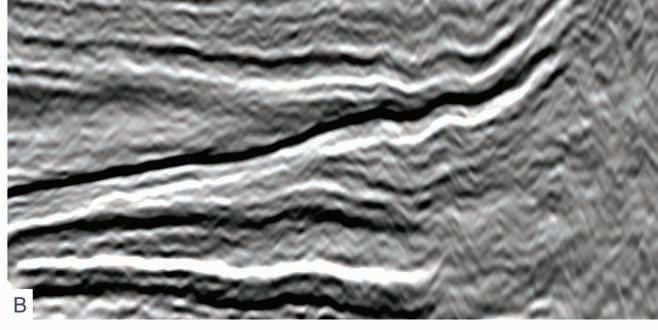




data provide the illumination and high signal-to-noise ratio required to interpret details of the depletion and accumulation/compressional
of the slump at a depth of around 4400 m (scale bar=1.5 km, maximum slump thickness approximately 150
Upper Jurassic reservoirs represent gravity-driven sediment mass flows limited to the deeper terraces and the SVG graben centres and appear to be absent on the highs (Utsira, Heimdal).
Non-commercial discoveries such as Busta 25/7-7 and Earb 25/10-11 (Figure 5A) drilled heterogenous Upper Jurassic reservoirs (sands-conglomerates) with limited connectivity at the faulted Utsira High-Gudrun/Heimdal Terrace margin. Repeat Jurassic sections in the latter are interpreted as rock-fall and attest to catastrophic failure of the graben margin during rifting. Recently, the Norma discovery 25/7-11S (Figure 5A; Sokkeldirektoratet, 2023) proved the presence of Upper Jurassic deep-water sands in the Vana Sub-basin. Petroleum is produced from Upper Jurassic reservoirs in the Gudrun field, where the Upper Jurassic is interpreted as gravity flow sediments (Hoth et al., 2018), while the Upper Jurassic in Hanz field is interpreted as shallow marine deposits (Berntsen et al., 2010). Both fields are located on structural highs, the potential of off-structure Upper Jurassic remains largely untested except for the Norma discovery. Accessing the morphological and stratigraphic aspects of mass transport complexes (MTC) requires high quality seismic data and a source-to-sink approach to pin-point reservoir sand
prone facies and accommodation areas. Towed-streamer MAZ data can reveal these details even at large burial depths due to the broadband range that preserves higher frequencies with high signal-to-noise ratio. An example of this is the imaging of the internal structure of Upper Jurassic clastic wedges that are often found close to the fault scarps. Figure 4 compares legacy conventional 3D and multi-sensor NAZ data that show parallel bedding in the clastic wedge. MAZ data indicate toe thrust of a slump with deposition in the accommodation space of the slump depletion zone between toe thrusts and fault scarp. Individual azimuths only partially reveal these features, demonstrating the benefits of MAZ illumination.
The presence of slumps suggests instant emplacement of the clastic wedge and as indicated by analogues (e.g. Kneller et al., 2016) associated sand facies can be expected on top or at the toe thrusts and in the depletion zone of the slump. Transport of sediment eroded from the exposed fault scarp after slumping will preferentially occur between individual slumps as they are morphological highs on the sea floor and divert mass transport accordingly. Maximum amplitudes extracted from the Upper Jurassic MTC layer show linear features that are interpreted as
gullies emanating at the fault scarp (Figure 5B). These provide short distance sediment transport routes across the terrace into the graben centre. If sufficient coarse-grained sediment is eroded and transported from the source area, sandy basin floor fans will expand out at the base of the terrace slope onto the deep basin/ graben centre floor. This seismic morphology becomes apparent in the MAZ data post-stack attribute maps (Figure 5B). Sediment sources are Middle Jurassic and older sections exposed at the fault scarps which comprise poorly consolidated reservoir quality clastics.
The Upper Jurassic MTC isopach map in Figure 5A shows that the eastern thick areas at the faulted Utsira High-Gudrun Terrace margin correlate with the location of mapped slumps (blue outlines mapped based on internal structure and reflector geometry). Depth ranges from 4 km at the fault scarp to more than 5.5 km to the west. It is only possible to regionally map the top and base of the Upper Jurassic MTC on MAZ data. Seismic data inversion and multi-attribute rotation (MARS, Alvarez et al., 2015) provide an estimate of maximum porosity in the Upper Jurassic MTC layer shown in Figure 5C. Higher porosity sediments are apparent in the gullies but not detected outboard in the area where basin floor fans are expected to be present. Gross sand thickness may be rather low as reported from the Norma well 25/7-11S (DNO, 2023) and below seismic resolution at depths of >4500 m. Elongated porosity distribution patterns are found associated with the slumps, which are interpreted to be ponded

sands. These accumulate in the depletion zone of the slumps that serve as accommodation space after slump emplacement and excess rock mass piles up in the toe thrust compressional zone of the slump.
An arbitrary line through the Upper Jurassic section near the graben centre and perpendicular to the sediment transport direction displays the Upper Jurassic internal reflector geometries in the deep Vana Sub-basin where the gullies open onto the graben floor (Figure 6). The imaging quality between conventional 3D, NAZ and MAZ is compared. Impedance contrasts and reflector continuities are difficult to discern on the NAZ image and not visible on conventional 3D data. Top and base of the Upper Jurassic MTC are most continuous and mappable on the MAZ data. The section is interpreted to indicate Upper Jurassic basin floor fans near the base of slope suggesting multiple and possibly stacked fans at a depth of around 4800 m.
Smart acquisition setup using towed-streamer spreads with variable streamer lengths and modified source arrangements can be used with legacy NAZ data to produce multi-azimuthal coverage that allows imaging of challenging plays in an already mature area. Taking advantage of the full MAZ dataset and FWI modelling that address velocity heterogeneities in the entire sedimentary section provides detailed subsurface imaging even at large depths. Imaging of gravity driven mass

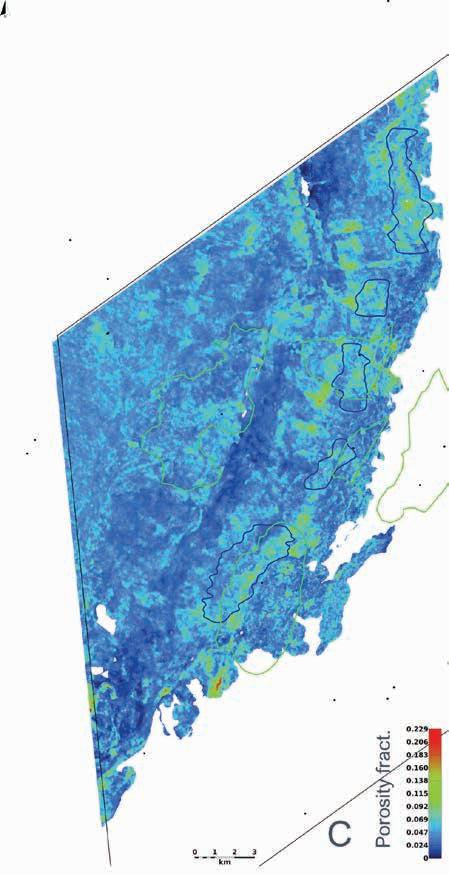
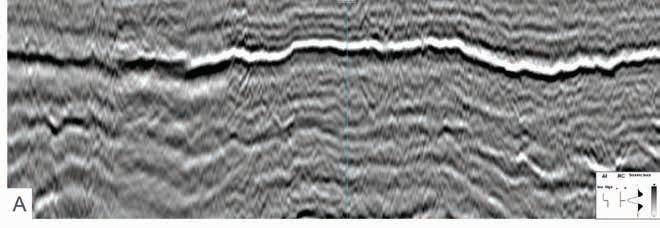


Alvarez, P., Bolivar, F., Di Luca, M. and Salinas, T. [2015]. Multi-attribute rotation scheme: A tool for reservoir property prediction from seismic inversion attributes. Interpretation, 3, SAE9–SAE18.
Berntsen, B.A., Hagen, E., Sørlie, R., Govers, M. and Jones, C. [2010]. Developing an invisible field in the North Sea. SPE Annual Technical Conference and Exhibition 2010, Expanded Abstract. https://doi. org/10.2118/135721-MS
DNO. [2023]. https://www.dno.no/en/investors/announcements/dnomakes-play-opening-discovery-at-norma-2023-09-19
Hoth, S., Knaust, D., Sánchez-López, A., Kassold, S. and Sviland-Østre, S. [2018]. The Gudrun Field: Gravity-Flow Deposition during Rifting and Inversion. In: Colin C. Turner; Bryan T. Cronin Rift-Related Coarse-Grained Submarine Fan Reservoirs; the Brae Play, South Viking Graben, North Sea. AAPG Mem., 115, 387-421
Kneller, B., Dykstra, M., Fairweather, L. and Milana, J.P. [2016]. Mass-transport and slope accommodation: Implications for turbidite sandstone reservoirs. AAPG Bull., 100, 213-235.
Limonta, L., Korsmo, Ø. and Ciotoli, M. [2021]. Novel acquisition design to improve illumination for velocity estimation and imaging, North Sea case study. 82nd EAGE Annual Conference and Exhibition, Abstract.
Oukili, J., Limonta, L., Bubner, M., Mueller, E. and Kultom Karlsen, T. [2020]. Revealing new opportunities with a cost-effective towed-streamer MAZ solution in the South Viking Graben, Norway. First Break, 38, 98-101.
transport complexes in the deeply buried Upper Jurassic of the Southern Viking Graben demonstrates the value of MAZ data. The data allow detailed seismic morphology interpretation and in combination with post- and pre-stack attributes confirm reservoir quality clastic facies associated with MTCs in the SVG rift system.
The authors would like to thank TGS for allowing us to publish and TGS colleagues for their contribution and reviews.
Sokkeldirektoratet. [2023]. https://www.sodir.no/en/whats-new/ news/exploration-drilling-results/2023/gascondensate-discovery-in-the-north-sea
Turner C.C and Cronin, B.T. [2018]. Rift-Related Coarse-Grained Submarine Fan Reservoirs; the Brae Play, South Viking Graben, North Sea. AAPG Mem., 115 Widmaier, M., O’Dowd, D. and Roalkvam, C. [2019]. Redefining marine towed-streamer acquisition. First Break, 37, 57-62.
Widmaier, M., Roalkvam, C., Oukili, J. and Tønnessen, R. [2021]. Maximizing quality and efficiency with wide-tow multi-source configurations. First Break, 39, 75-80.






To serve the interests of our members and the wider multidisciplinary geoscience and engineering community, EAGE publishes a range of books and scientific journals in-house. Our extensive, professional marketing network is used to ensure publications get the attention they deserve.
EAGE is continually seeking submissions for both book publishing and articles for our journals. A dedicated and qualified publishing team is available to support your publication at EAGE.
Josefina Marmisolle1, Bruno Conti1, Pablo Rodriguez1, Karyna Rodriguez 2* and Neil Hodgson2 demonstrate why the shared tectonostratigraphic evolution with the conjugate margin of the southwestern Atlantic (northern Argentina, Uruguay and southern Brazil) provides a robust analogue for the development of exploration models, petroleum system assessments, and play-based evaluations in the South Atlantic region.
Introduction
Recent discoveries in Cretaceous sequences offshore Namibia have renewed industry expectations in the South Atlantic, positioning the Orange Basin, on the western African margin, as one of the most promising areas for hydrocarbon exploration.
The shared tectonostratigraphic evolution with the conjugate margin of the southwestern Atlantic (northern Argentina, Uruguay and southern Brazil) provides a robust analogue for the development of exploration models, petroleum system assessments, and play-based evaluations in the South Atlantic region.
On both margins, common petroleum system elements have been identified, including the presence of Barremian-Aptian source rocks, Lower and Upper Cretaceous turbiditic reservoirs and channel systems, as well as stratigraphic and combined traps in deep-water settings (>1200 m). Available 2D and 3D seismic data from Uruguay’s and southernmost Brazil’s offshore indicate both similarities and differences when compared to the geological features associated with the recent discoveries in Namibia, reflecting a divergent geological evolution of the two margins, particularly from the Late Cretaceous onwards.
In the Uruguayan and southernmost Brazilian margins, a greater thickness of the Barremian-Aptian source rock has been interpreted either in specific depocentres (Uruguay) or as a NW-SE aligned trend of at least three pulses of source rock deposition resulting in an overall deposit of over 300 metres (Pelotas Basin). However, uncertainties persist (primarily due to the scarcity of direct data) regarding its thermal maturity, as well as reservoir quality and trap effectiveness.
This study addresses one of these key elements, focusing on the reservoir quality of the Cretaceous sequence in the Uruguayan margin and the southern Brazil Pelotas Basin. This has been a long-standing perceived risk offshore Uruguay and southernmost Brazil, but has become a particularly relevant issue recently, given that some discoveries in Namibia have documented low-permeability reservoirs (Kombrink, 2024), potentially linked to a high content of diagenetic minerals such as chlorite,
1 ANCAP | 2 Searcher
which could adversely affect their commercial viability. Even when reservoir quality is not an element that can be directly compared across conjugate margins as the provenance for these reservoirs is not the same, the widespread Paraná-Etendeka Igneous Province, which occurred approximately 136 to 132 million years ago, and outcrops on both sides, has in part led to the questions raised on reservoir quality offshore Uruguay and southernmost Brazil.
To assess reservoir quality from a source-to-sink perspective, it is essential to consider the tectonic, paleogeographic, and magmatic controls that operated from the Jurassic to the Cretaceous/ Paleogene boundary, as well as the lithological characteristics of the potential sediment source areas.
The following article presents a set of pieces of evidence related to the main source areas that supplied sediments to the post-rift succession of the Uruguayan and southernmost Brazil continental margins, the Area of Interest (AOI) in this study, including direct and indirect indicators suggesting the presence of high-quality reservoirs.
Lithologically, two major geological regions can be identified as potential source areas for sediments deposited in the offshore AOI: the ancient basement terranes exposed in the southern part of the country (Río de la Plata Craton – RPC, the Dom Feliciano Belt – DFB), and the Lower Cretaceous basalts outcropping in the north, which are part of the Norte Basin (Figure 1).
The RPC is a Paleoproterozoic block dominated by gneisses, granites, and high-grade metamorphic rocks, while the DFB resulted from a Paleo to Neoproterozoic orogenic event and is composed of gneisses, migmatites, syn- and post-tectonic granites, metavolcanic and metasedimentary sequences, as well as mafic and ultramafic rocks (Sánchez et al., 2009; Hueck et al., 2017; Oyhantçabal et al., 2018).
In turn, the continental basaltic flows, grouped in the Serra Geral Group (Arapey Formation in Uruguay), cover an
* Corresponding author, E-mail: k.rodriguez@searcherseismic.com
DOI: 10.3997/1365-2397.fb2025086

area of more than 1 million km² across northern Argentina, northern Uruguay, southern Brazil and eastern Paraguay. These lithologies are part of the Paraná-Etendeka Igneous Province, dated at the Jurassic-Cretaceous boundary (~132 Ma), reaching thicknesses of up to 1.7 km (Rosetti et al., 2018), and are predominantly composed of basaltic flows with subordinate acidic volcanic rocks (Figure 1). Subsurface data indicate a depocentre in the northwestern region of Uruguay, with thickness decreasing towards the south and east of the territory. Geological evidence suggests that these basaltic flows did not reach the coast during the opening of the Atlantic, as the Río de la Plata Craton constituted an elevated terrain during the Cretaceous (Hueck et al., 2018), see Figure 2. Otherwise, the lack of basaltic clasts in the units overlying the basalts suggests that magmatic domains constituted topographic lows at the time of deposition (Figure 3).
Meanwhile, offshore seismic data show that the Polonio High (composed of the DFB) operated as a structural high during the Cretaceous, later being overlain by the first Cenozoic transgression in the Paleocene.
Figure 1 Uruguay and Brazilian states of Santa Catarina and Rio Grande do Sul outcrop geological map. Location of the Figure 3 samples is also shown (black stars). Modified from Hueck et al., 2017; Oyhantçabal et al., 2018; and Garzanti et al., 2025.
Consequently, the Río de la Plata Craton and the Dom Feliciano Belt (Figure 1) likely functioned as the primary sediment source areas (hinterland) for the post-rift succession of the Uruguayan and southernmost Brazil continental margins. Subsurface and seismic data indicate that sediments derived from these elevated basement regions were funnelled towards the offshore depocentres, controlling the thickness and distribution of the post-rift deposits (Figure 4). The paleogeographic configuration during the Late Cretaceous, associated with a paleo Río de la Plata River, likely channelled sediment transport towards the east and south east, feeding deltaic systems at the base level. Today, the main sediment input to Uruguay’s offshore basins comes from the Río de la Plata, through the tributaries of the Uruguay and Paraná rivers.
The Uruguay River drains predominantly through Paraná–Etendeka volcanic deposits (59%), Paleozoic to Cenozoic siliciclastic deposits (14%), and Precambrian basement (6%) (Garzanti et al., 2025). See Figure 1.
According to these authors, current sediment composition shows that, although Paraná basalts are widely exposed in Uruguay,
the Río de la Plata estuary sands are predominantly quartz-rich with negligible heavy minerals and negligible (<1%) basaltic silt.
Samples from the only two wells drilled in the Punta del Este Basin (Lobo and Gaviotín), located in shallow waters at 40-50 m depth (see Figure 4) indicate Cretaceous sandstones that are predominantly quartz–feldspar, suggesting a provenance likely linked to felsic rocks with porosity values between 18 and 25%. In addition, the Tertiary reservoir penetrated by the Raya well, located in the deep-water (≈3400 m) sector of the Uruguayan Pelotas Basin (Figure 4), consists of fine quartz-rich sandstones, whereas the overlying Miocene shales contain less than 12% chlorite.
No wells have yet been drilled in the deep-water sector of the Uruguayan or southernmost Brazil offshore that penetrate the Cretaceous post-rift succession, and therefore, no direct data on reservoir quality is available. Sediments like those encountered in the Lobo and Gaviotín wells (of felsic origin) are expected, but with greater textural and mineralogical maturity.
Insights from the recent exploration success in the conjugate Orange Basin are helping to de-risk the elements of the petroleum system offshore Uruguay and southernmost Brazil. Access to a regional 3D dataset in the Orange Basin has shed light on the seismic characteristics of the world-class proven Aptian source rock, as well as reservoir depositional systems, main trapping mechanisms, and, most importantly, the seismic response of hydrocarbon accumulations.
A composite seismic line (Figure 5) from the over 20,000 km2 of multi-client 3D seismic data acquired between 2021 and 2022 in the Orange Basin, illustrates the seismic character associated with the key elements of the petroleum systems of the three play fairways opened by the TotalEnergies-operated Venus well, the Shell-operated Graff well, and the Galp-operated Mopane well. All these discoveries have since been followed by a series of wells testing the extension of the play fairway with mixed but overall, very positive results. The ‘Venus’ play fairway is located in the deep-water present-day basin where a clear proven world-class Aptian source rock character can be

Figure 2 Schematic evolutionary model of the Uruguayan Shield and associated sedimentary record from Paleozoic to Upper Cretaceous. SYSZ, Sarandí del Yí Shear Zone; SBSZ, Sierra Ballena Shear Zone; SLB, Santa Lucia Basin; LMB, Laguna Merín Basin; RPC, Rio de la Plata Craton; DFB, Dom Feliciano Belt; MVD, Montevideo; SR, Santa Rosa High. Modified from Hueck et al., 2017.


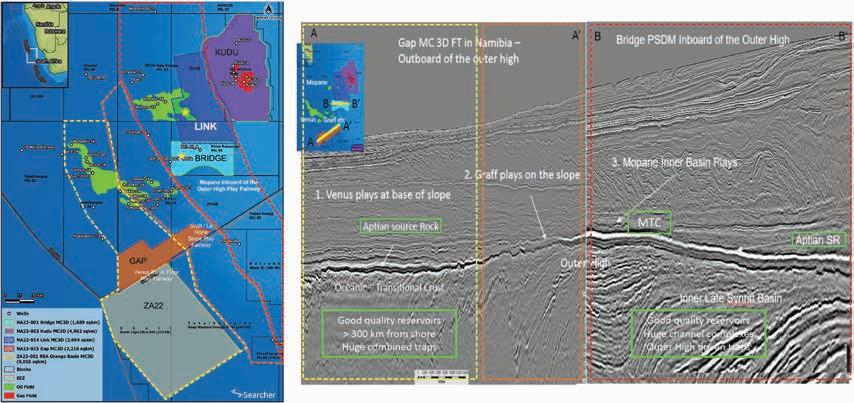
Figure 3 (A) and (B) Quartz-K feldspar sandstone of Guichón Formation (Upper Cretaceous: post- Cretaceous basalts, Norte Basin), located in Meseta de Artigas, over the Uruguay River, Paysandú, Uruguay. (C) and (D) Polymictic conglomerate of Mercedes Formation (Upper Cretaceous: post-Cretaceous basalts, Norte Basin) located near Mercedes City, Soriano, Uruguay. Outcrop locations are shown in Figure 1.
Figure 4 Seabed map (Gradient Attribute) highlighting the present-day channels transporting sediment offshore.
Figure 5 (Left) Map showing the recently acquired multiclient 3D seismic datasets in the Orange Basin. The dashed lines represent the inferred extensions of the three main Play Fairways opened by the successful wells mentioned in the text. The stars show two of the most recent wells (the Rhino Resources-operated Capricornus well and Galp-operated Mopane-3x well). These wells are located within the recent 3D datasets, and the seismic expression of the hydrocarbon accumulations is discussed in the text. (Right) Composite seismic line from the Gap and Bridge seismic datasets, illustrating the seismic expression of the three play fairways shown in the map. The clear expression of the world-class proven Aptian source rock is pointed out both inboard and outboard of the Outer High. The depositional systems bringing sand into the basin, the trapping mechanisms, and the characteristics of the hydrocarbon-bearing sands are all discussed in the text.
observed (white strong amplitude anomaly associated with a decrease in acoustic impedance and a decrease in amplitude with offset (AVO Type IV)).
Directly overlying this source rock, a series of strong amplitude anomalies (AVO Type III) analogous to and on trend with the Venus discovery, have been mapped and show a clear turbidite-related basin-floor fan, with one of those fans extending over an impressive area of around 2000 km2 (Figure 6). This is a prospect estimated to hold more than 3 BBOE with conservative resource estimates. The trap is provided by the counter regional dipping geometry observed in the depth data, resulting in a 3-way structural and one-way stratigraphic trap.
Channels mapped inboard of the Outer High stack in fan-like geometries, likely caused by the change in slope provided by the Outer High. The Mopane channel complex is interpreted to have formed by this process. Mass Transport Complexes (MTCs) play an important role in sealing the Capricornus channel. Capricornus has a clear AVO Type II response (Figure 6) and was reported to flow 11,000 bpd of light oil from high-quality reservoir sands.
The Orange Basin discoveries and prospects analysed on the recent 3D seismic datasets provide insights into the seismic
character of not only the depositional systems but also the hydrocarbon accumulations. The Ultrafar angle stack is proving to be an essential tool to identify both AVO Type II and Type III anomalies associated with reported oil discoveries.
Offshore Uruguay and southern Brazil Pelotas Basin seismic indications
Taking the learnings from the Orange Basin is helping to de-risk the observations offshore Uruguay and southernmost Brazil. These observations align with the sediment provenance discussed previously and point to huge potential with good-quality reservoirs on this side of the margin.
Offshore Uruguay seismic interpretation and reservoir been assessment: Chafalote
The arbitrary seismic line shown in Figure 7 illustrates the seismic facies of both the Chafalote prospect and the Raya reservoir. Both areas exhibit well-defined reflectors and strong internal continuity, indicative of high-quality reservoir potential. Raya, drilled in 2016, confirmed excellent reservoir properties with an average effective porosity of 24% (Rodriguez et al., 2019)


Figure 6 (Top) E-W zoomed in full stack and (UltrafarNear)*Utrafar angle display showing a clear AVO Type II anomaly (blue represents brightening in the ultrafar angles) associated with the Capricornus discovery. (Bottom) NE-SW full stack and (Far-Near)*Far angle display showing the clear AVO Type III response (red is brightening in the far angles) of the 2000 km2 basin floor fan (pink horizon) mapped over the proven world-class Aptian source rock (brown horizon).
7

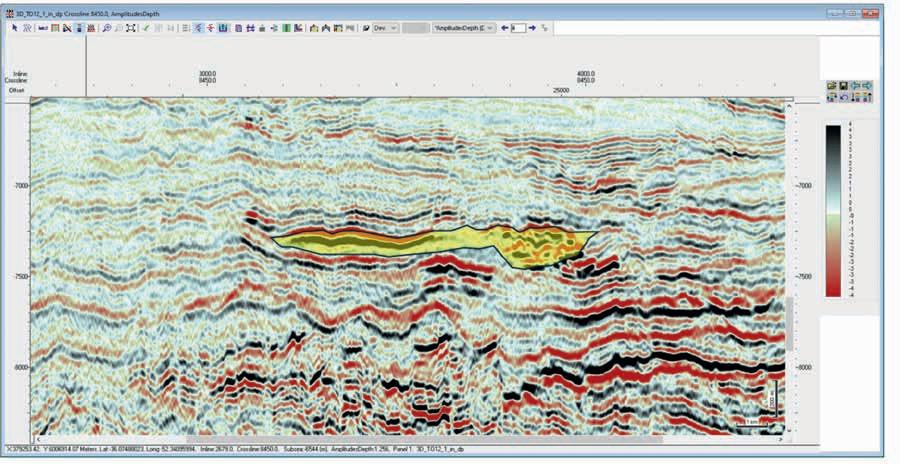
and favourable permeability. However, the interval proved to be entirely water-bearing. This result provides valuable insight into the quality of the turbiditic reservoirs but does not confirm hydrocarbon generation or charge within the system.
The RMS amplitude map in Figure 8 delineates the geometry of the Chafalote submarine fan system, characterised by multiple lobes and a central channel. This interpretation is further supported by the strike-oriented seismic profile shown in Figure 9, which reinforces the fan architecture.
Additionally, as illustrated in Figures 10 and 11, Chafalote exhibits a pronounced amplitude increase from Near to Ultra-Far offsets, indicative of an AVO Type II anomaly, suggesting a change in elastic properties within the target interval.
Additional confidence is gained through correlation with Capricornus, the Lower Cretaceous turbidite play in the Orange Basin described in the previous section. Both areas share similar seismic facies and reflector continuity, pointing to a common depositional environment. This analogy strengthens
the reservoir model and reduces uncertainty regarding reservoir quality.
The primary risk in Chafalote is trap effectiveness, not reservoir presence. While Raya demonstrates the existence of excellent turbiditic sands in the system, the critical question is whether the Chafalote structural and stratigraphic configuration ensures effective hydrocarbon trapping. If this condition is met, the seismic evidence, including the contrasting AVO behaviour, supports a positive exploration outcome.
Southern Brazil Pelotas Basin seismic interpretation and reservoir assessment
A modern multi-client 3D dataset has recently been acquired offshore southernmost Brazil in the Pelotas Basin (Figure 12).
One of the breakthroughs allowing the shortening of the exploration cycle is the generation of very high-quality fast-track data, delivered a few weeks after the last shot point, and most importantly, with angle stacks. In the Orange
Basin, all the datasets were delivered with this fast-track model, allowing the respective companies working in the area to identify and high-grade amplitude anomalies potentially indicative of hydrocarbon accumulations. This resulted in early well planning, only reconfirming the final location with the final PSDM data. Within two years of acquiring the seismic data, two successful wells were drilled (Mopane-3x and Capricornus-1). This same type of data has been received for the
Pelotas Basin enabling a first ever 3D evaluation of the source rock, reservoir depositional systems and trapping mechanisms (Figure 13).
Both AVO Type III and Type II responses have been identified (Figure 14) for the different potential reservoirs, which vary in depositional settings from basin floor fan turbidites, to turbidites reworked by fast velocity contourite currents, to stacked/amalgamated channels and fans.





Integration of geological and geophysical data supports a source-to-sink model in which Cretaceous sediments were primarily derived from the Río de la Plata Craton and the Dom Feliciano Belt, the main hinterland during that time, rather than from the Paraná Etendeka magmatic provinces. In addition, Upper Cretaceous outcrops show the absence of basaltic clasts in units overlying the basalts, indicating that magmatic regions were topographically low during deposition.
Cretaceous offshore units exhibit favourable reservoir properties, including good porosity and compositional maturity with no significant input of volcanic material from the Paraná-Etendeka Igneous Province.
Sediment compositional maturity also indicates recycling of sedimentary rocks and low denudation of volcanic terrains.
In that sense, reservoir quality in the Uruguayan and southernmost Brazil offshore must be understood within a tectonic framework that excludes direct input of magmatic products. The source-to-sink approach is essential for reconstructing sedimentary pathways, facies distribution, and for developing predictive models for the exploration of new Cretaceous plays in the South Atlantic margin.
Prospectivity analysed with 3D seismic indicates the presence of reservoirs that have a similar response to that observed in the Orange Basin, which are typically good-quality reservoirs with significant hydrocarbon accumulations. Understanding the provenance for these systems greatly reduces reservoir quality risk and points to a very exciting area for future exploration activity.
Figure 13 E-W fast track full-stack depth converted seismic line from the 2024 3D dataset in the southern Brazil Pelotas Basin. Thick, extensive Aptian source rock with clear AVO Type IV response has been identified. Based on a BSR-derived geothermal gradient, the source rock is modelled to be in the oil window. Eight different play types have been mapped.
Figure 14 Fast-track PostSTM full-stack depth converted seismic line showing the sets of different types of AVO response in the different depositional settings.
References
Garzanti, E., Dinis, P., Barbarano, M. and Limonta, M. [2025 (preprint)]. Basaltic sources but quartzose sand: sediment provenance, weathering, and recycling in the Uruguay River catchment. Journal of Sedimentary Research, 95(4), 675–692. https://doi.org/10.2110/ jsr.2025.011.
Hueck, M., Oriolo, S., Dunkl, I., Wemmer, K., Oyhantçabal, P., Schanofski, M., Basei, M.A. and Siegesmund, S. [2017]. Phanerozoic low-temperature evolution of the Uruguayan Shield. Journal of the Geological Society, 174, 609–626. https://doi.org/10.1144/jgs2016-101.
Kombrink, H. [2024]. Namibia – Looking at the factors that cause concern when it comes to developing the recent deep-water finds. GeoExpro, 5
Oyhantçabal, P., Cingolani, C.A., Wemmer, K. and Siegesmund, S. [2018]. The Rio de la Plata Craton of Argentina and Uruguay. In Siegesmund et al. (eds.), Geology of Southwest Gondwana, Regional Geology Reviews, Chapter 4. https://doi.org/10.1007/978-3-31968920-3_4.
Rodriguez, P., Ferro, S. and Weijermars, R. [2019]. Probabilistic Techno-Economic Appraisal of Prospective Hydrocarbon Resources in Five Turbidites, Offshore Uruguay. Proceedings of Offshore Technology Conference Brazil 2019. https://doi.org/10.4043/29929-MS.
Rossetti, L., Lima, E.F., Waichel, B.L., Hole, M.J., Simões, M.S. and Scherer, C.M. [2018]. Lithostratigraphy and vulcanology of the Serra Geral Group, Paraná-Etendeka Igneous Province in southern Brazil: towards a formal stratigraphical framework. Journal of Vulcanology and Geothermal Research, 355, 98–114.
Sánchez, B., Peel, E. and Masquelin, H. [2009]. Neoproterozoic tectonic synthesis of Uruguay. International Geology Review, 52(1), 51–78. https://doi.org/10.1080/00206810903358095.
Ian Setterfield1* discusses how the industry is meeting the data management challenge that is holding back seismic data innovations in the marine seismic sector.
Energy companies are expected to spend $21 billion by 2032 on seismic data management and interpretation software and related tools, as part of their exploration and production (E&P) strategies. These are impressive figures, but despite such a commitment to innovation, the sector still sees fundamental constraints on companies’ E&P capabilities because many operators are unable to fully leverage their seismic data’s potential for interpretation, decision-making and development.
Many geoscience and engineering teams cannot easily access, interpret and collaborate on data held across their multiple hubs and remote locations. Some companies are still maintaining game-changing seismic data in inaccessible, inflexible, and hardto-maintain storage formats.
These tendencies may be exacerbated by the sometimes piecemeal development of data storage. Corporate growth, or consolidation of business units, can lead to duplication or cutbacks in technology stacks, with IT teams resorting to manual data backups and copying processes to maintain data capacity and resilience. Whatever the causes, data management challenges are holding back seismic data innovations and ultimately, slowing time-to-oil.
Legacy or ‘siloed’ data storage infrastructures are rarely a headline-maker, but delays in rationalising them are driving up
energy companies’ exploration costs and increasing their overall risk. This is because many storage architectures are no longer able to keep pace with, still less harness, the raft of innovations in data acquisition, just as these advances are helping to transform subsurface exploration and seismic data interpretation’s capabilities. Key seismic data acquisition advances include:
• Ocean-bottom seismic (OBS/OBN) surveys — where autonomous recording devices or nodes on the seabed deliver more detailed and higher-resolution seismic data
• Wider use of distributed acoustic sensing (DAS) — using fibre optics’ capabilities to achieve real-time, higher-resolution seismic data acquisition and analysis at scale
• Full waveform inversion (FWI) — where entire seismic wavefields and higher frequency content provides higher-fidelity subsurface modelling options
• High-performance computing (HPC) hubs — these supercomputers aggregate and analyse massive datasets to crack new interpretation requirements and smooth the path for adoption of AI and machine learning (ML) tools for enhanced data interpretation.
These advances have moved seismic data interpretation capabilities away from the realms of static 3D imagery towards highly detailed, flexible and dynamic decision-making tools. However, with the complexity of many firms’ file storage arrangements,

1 Nasuni
* Corresponding author, E-mail: isetterfield@nasuni.com
DOI: 10.3997/1365-2397.fb2025087


and with stored data regarded in accounting terms as an ongoing cost, energy firms need simpler and more reliable ways to store, process and interpret seismic data, optimising their innovation capabilities and boosting the value derived from exploration activities.
And as AI rapidly becomes integral to subsurface data analysis and asset optimisation, companies are seeking ways to break down data silos, consolidate and simplify access to their global data sets to give E&P teams unfettered use of the latest AI tools and further accelerate seismic data analysis and interpretation.
Despite data acquisition innovations and the ever-increasing storage capacities required, a new generation of storage tools is transforming energy firms’ data management capabilities. The breakthrough is being achieved by hybrid cloud storage platforms which enable energy companies to take control of and gain full visibility of their seismic data assets. They also optimise oil and gas firms’ use of industry-standard analytics tools across multiple E&P applications.
These cloud-native replacements for network-attached storage (NAS) and file server infrastructures consolidate file data in expandable, durable object storage at appreciably lower cost than legacy on-premises storage. Allied to virtual desktop infrastructure (VDI), engineered for the high-performance compute demands of seismic interpretation, and synchronised between regions, these platforms make massive seismic data files instantly accessible to an operator’s asset teams, despite them working across regions and in remote locations. Contrast this data accessi-
bility with the 12 to-18-month cycles often needed for laborious seismic data collection, copying, sharing, and analysis when using legacy file-storage infrastructure.
Hybrid cloud platforms are changing and simplifying the ways that higher resolution seismic data sets are stored, managed, accessed, analysed and collaborated on.
A second key advantage of cloud-native platforms is their pivotal role in streamlining workflows and simplifying multi-disciplinary team collaborations, whether as part of companies’ ongoing digitisation programmes, or in readiness for AI tools’ adoption. In an industry that still sees instances of data physically transported to data scientists in different locations, unified data platforms offer a step change in rationalising workflows and transforming the scale, depth and speed of team data modelling and interpretation projects.
Thirdly, new storage platforms’ unlimited capacity raises the prospect of energy firms making huge operating cost savings: their IT teams now have the opportunity to reduce their dependence on, or do with away altogether with costly and unwieldy on-premises storage set-ups that barely protect vital intellectual property while consuming precious IT budget resources for repeated upkeep demands on an ongoing basis.
Specific opportunities for geoscientists and IT professionals from unified data foundations include the following.
Hybrid cloud platforms bring E&P data assets into one unified platform, enabling a clear overview of all information. This is a profound shift away from on-premises legacy NAS, file servers, and backup systems that complicate data management and create silos of unconnected data.
For example, an energy services company consolidated its multiple storage and backup systems into one single platform, enabling immediate data access from anywhere. This unified data availability has helped geoscientific teams to accelerate their data interpretation projects and improve cross-team collaborations. The strategy delivered a general 90% improvement in seismic data management processes, more accurate exploration development plans, and shortened time to oil.
Wider availability and adoption of AI analytics tools are already transforming the potential for seismic data interpretation across core exploration processes, whether accelerating data interpretation, reducing development cycles and helping reduce overall investment risk.
Unified data strategies have a proven record of consolidating data for AI use. Cloud-native storage platforms give large language models (LLMs) full data access, giving E&P teams unprecedented scope to harness new and existing data at scale. The improved data access delivered by hybrid cloud storage also facilitates LLMs’ access to all internal policy, ESG, and other regulatory data sets, so IT teams can build effective guardrails for safe AI operations with inbuilt compliance with industry regulations.
The combination of a unified data environment and AI tools is already enabling geoscientists to increase the proportions of seismic data being used in modelling and interpretation — up to 90% in some cases — because the data is instantly available to all team members; it doesn’t have to be retrieved from tape or disk and separately processed before use.
Another under-realised aspect of cloud native platforms is their ability to unleash legacy seismic data’s potential in different ways while massively driving down operating costs.
First, unified cloud platforms resolve geoscientists’ and other departments’ challenges when accessing Petabytes of
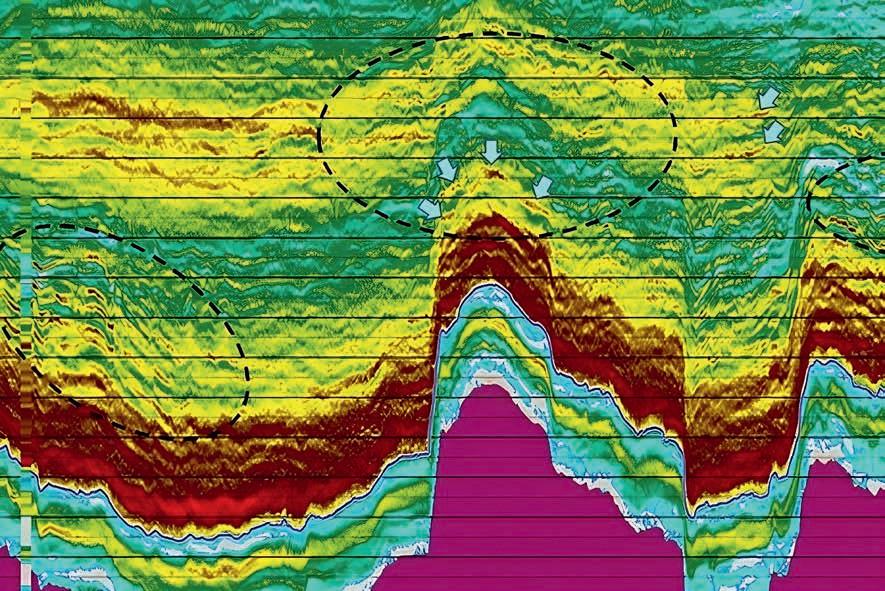



data previously held on outdated and inaccessible media (e.g. tape).
Second, hybrid cloud tools enable IT to centralise, consolidate and simplify data storage across multiple locations (e.g. removing legacy storage silos) to allow faster ‘without limits’ file storage. In a recent case, a global firm achieved fast file access and effective data sharing worldwide by consolidating 12 sites. Such rationalisation can drive further savings, since data is removed from inefficient legacy storage media such as tape and disk.
Third, hybrid cloud storage equips E&P teams with unlimited storage capacity and configuration flexibility. While companies constrained by NAS capacity limits saw IT teams locked into time-consuming data duplication and backup processes, cloud storage models enable operators to upscale their data modelling and interpretation demands while giving local offices faster access to cached files at the network edge. Whether operators
specify high-powered, local workstations or a scalable VDI arrangement, hybrid cloud offerings are individually configured to centralise all data. The days of IT teams having to plan extra capacity and find the budget to bolt on additional storage infrastructures are numbered.
Fourth, data consolidation with cloud-native platforms transforms infrastructure and associated maintenance costs. Upgrading legacy infrastructure for managing massive seismic data files requires significant capex outlay, with considerable uncertainty of over computational resources ultimately needed. As a result, companies often intentionally overbuy or underbuy storage and performance capabilities. In contrast, cloud-based storage offerings combined with on-demand compute offer IT teams scope to navigate financial volatility by shifting expenditure into an Opex model.
Organisations that replace on-premises infrastructures with hybrid cloud can do away with costly back-up systems and associated maintenance budgets; such infrastructure rationalisations typically deliver cuts to storage and backup costs of up to 60% and reduce site-by-site hardware needs by up to 80%.
Centralising data with hybrid cloud platforms also underpins wider and secure collaborations because of the enhanced integrity of data being managed and interpreted for multi-disciplinary collaborations.
Leading hybrid cloud platforms’ architecture delivers global ‘file lock’ capabilities for multi-site file sharing without the version conflicts seen with on-premise set-ups. Since these tools simultaneously connect to multiple clouds, they can also simplify IT teams’ compliance with data security and sovereignty specifications.
Some IT teams have preferred to maintain their own on-premises storage, citing data latency, network management and audit / compliance issues. Cutting-edge hybrid cloud offerings have addressed and resolved such concerns: they can fully incorporate enterprise-class NAS QoS, cache pinning, audit, and migration. Leading providers have ramped up their network management and security capabilities for users by adding SNMP alerts and antivirus protection services.
Hybrid cloud storage offerings greatly reduce the risk of data loss and downtime from system outages or disasters. Cloud architectures incorporate millions of restore points, enabling company IT teams to ‘turn the clock back’ to the time immediately before an incident to restore Terabytes or Petabytes of data in minutes. IT teams armed with granular control over RPO and RTO can reduce risk from outages, corruption and mailicious attacks. Organisations can now restore their data to a precise time in a matter of minutes instead of hours and days. This capability will help ensure the continuity of subsurface workflow projects and ensure time-to-oil metrics continue on-track. Ransomware protection is becoming increasingly relevant and leading hybrid cloud storage offerings combine ‘in-line’ edge detection of ransomware, immutable snapshots, rapid rollback capabilities, and air-gapped storage layers, helping IT teams to neutralise threats quickly.
Adopting a unified platform can unlock less obvious benefits, such as simplifying the operations of federated companies, independent business units, and remote working policies. For example, a forward-looking energy company implemented a hybrid cloud storage solution as part of a more agile and cost-effective technology stack.
By consolidating and simplifying access to its data assets, the company helped to transition its global workforce to a WFH model without adversely affecting project delivery, collaborations and productivity. While expected business outcomes included a 92% reduction in the on-site storage disk footprint, this result was rivalled by enhanced home working options and wellbeing for remote teams with unfettered seismic data access and workplace flexibility.
Unified data environments are transforming seismic data interpretation and its uses by energy businesses. Hybrid cloud
platforms not only remove data accessibility challenges but also give geoscientists a single view of the more detailed, higher-density seismic data sets from OBS, DAS and FWI and AI applications, despite the scale of the data sets moving across company networks.
As operators plan increased E&P investments, the tools are now available for geoscientists and engineers to transform their seismic data storage access and interpretation processes and rethink the costs involved. Cloud native-based unified data strategies ensure global scale, performance and security for oil and gas companies: whatever the data type, geoscientists and IT teams can avoid the need for multiple copies of data and instead gain one source of the truth. Delivering transformative breakthroughs in seismic data’s analysis and interpretation, development projects. Ultimately, reducing time to oil is now a practical proposition for energy companies worldwide.
An independent oil company with operations in dozens of countries worldwide maintained a strong track record of investing in the most advanced technologies. While this investment focus saw the company adopt various vendors’ cloud solutions in its operations, E&P teams’ capabilities, productivity in interpreting seismic data was constrained. There were still cases of geoscientists and colleagues having to wait hours and sometimes more to access the data they needed.
With time-to-oil a critical variable, these delays risked losing commercial opportunities. Worse, recovering lost or deleted files was also proving to be problematic, while cloud vendor costs were higher than expected. The IT team wanted to ensure accelerated global access to geophysical data, cost-effective cloud capacity and reduced data recovery times, alongside reduced need for management oversight.
To resolve these challenges, the company switched to an interpretation software used in conjunction with a flexible
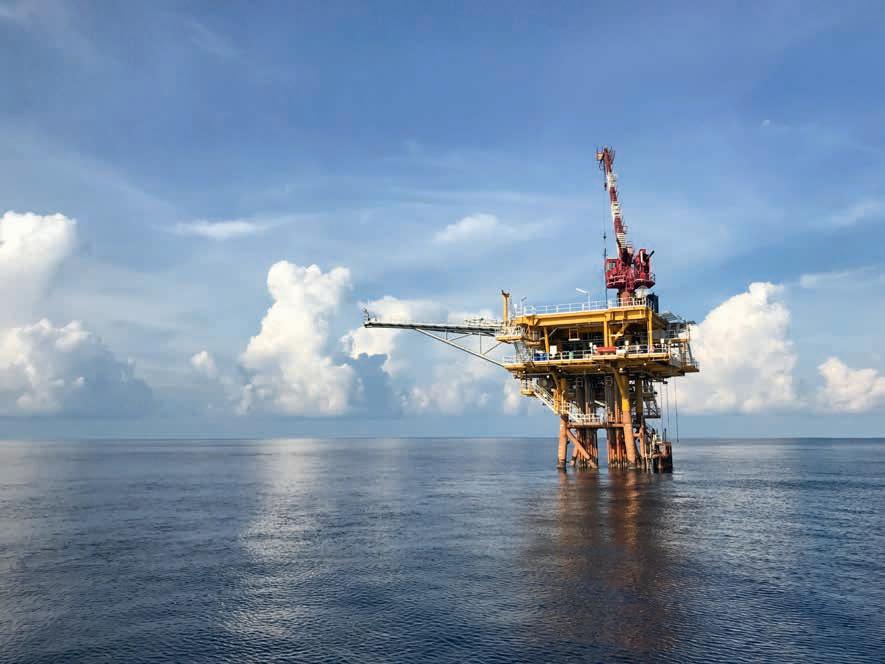
hybrid cloud storage platform. Once the company’s data is ingested at one location, it is available within minutes anywhere in the world, from Singapore to Houston to Norway. This process is automatic and efficient, with no duplication or copying processes required.
By switching to an interpretation tool used in conjunction with a hybrid storage platform, the company has achieved a raft of collaboration benefits and cost savings. The company has already identified overall savings of 35% over its previous storage model that used both on-premises and hybrid cloud. It also achieved a 99% reduction in recovery time and accelerated global workflows by ten times and faster overall time to oil.
A hybrid cloud storage company is providing the underlying file storage infrastructure for a leading seismic data analytics platform’s enterprise users. This combination enables users to collaborate across E&P and engineering teams with high performance, regardless of location and harness all available scientific data to optimise asset development.
Designed for scalability, security and performance, the cloud-native platform consolidates file data in easily expandable, highly durable object storage at a fraction of the cost of on-premise arrangements. Users gain automatic data access, scalability, built-in security and fast edge performance
that increase business productivity within a single, unified experience.
All data is stored securely on the hybrid cloud provider’s volumes, backed by cloud object storage within the analytics platform itself. Data is presented to desktops via edge appliances, either in single or multiple cloud regions, to ensure high-performance access for geoscientists and engineers using industry-standard applications such as Petrel.
The platform’s file synchronisation caches active files from cloud storage on low-latency storage within edge appliances deployed close to the user’s VDI infrastructure. This combination enables geoscientists to access a global file system of centrally stored assets regardless of their location, removing the need for data replication or travel to regional offices and accelerating decision time and accuracy.
The global file system’s continuous versioning stores data securely and allows for multiple recovery points to be created. Its simple and fast recovery process enables Petabytes of data to be recovered in minutes to any location, reducing the risk surrounding large capacity datasets storage.
Since the hybrid cloud file system resides in limitless cloud object storage, there are no limits on file, volume, or directory size, number of snapshots or locations it spans, allowing large subsurface data sets to be stored, from hundreds of Terabytes to hundreds of Petabytes, as required.














Julien Large1*, Shuki Ronen1, Paul Wentzler1, Maxime Benaniba1 and Jeremy Aznar1 describe an optimised survey design that encourages the industry to acquire data using a triple-source configuration with the TPS.
Introduction
Some of the most challenging E&P projects are conducted in complex geological settings, including chalk, basalt, carbonate or salt formations. These structures often cause wavefield scattering above target zones. In such environments, the absence of low-frequency content, combined with limited acquisition offsets and azimuths, severely impedes the penetration of the useful seismic signal. When modern data-driven inversion techniques, such as Full-Waveform Inversion (FWI), are applied in these complex settings, they are prone to convergence issues — most notably local minima, commonly referred to as cycle-skipping. This makes them heavily reliant on subjective prior information, resulting in inverted velocity and reflectivity models that often fail to accurately depict the subsurface. Moreover, it takes more time to process the data. Limited seismic signal penetration has significant impacts on project life cycles, from prospect identification to well placement. To overcome these challenges, seismic surveys must utilise broadband sources that generate very low frequencies (as low as 1 Hz), spanning at least seven octaves recorded over wide-azimuth and long-offset geometries. Such broadband data enable a robust inversion process with minimal dependence on prior information. A low-frequency source is a critical component of this solution to efficiently address the demands of long-offset, wide-azimuth acquisitions.
The first large-scale 3D long-offset, low-frequency (LOLF) seismic acquisition and imaging survey using the Sercel Tuned Pulse Source (TPS™) was conducted in the deep-water US Gulf. This survey (Meritt, 2024) demonstrated the value of the low-frequency signal emitted by the TPS, which proved essential for subsalt imaging. It also enabled the construction of a high-resolution blocky post-salt Earth model. Owing to the efficiency and reliability of deploying the TPS in a production environment, the survey achieved full-azimuth coverage with offsets of up to 80 km. The project was completed on schedule in just four months. By avoiding cycle skipping when performing Full-Waveform Inversion (FWI), data processing took only six weeks after last node recovery, to deliver a fast-track imaging product that unveiled subsalt images with detail never seen before with legacy data acquired with airguns and full-azimuth streamers.
A few weeks after retrieving the last TPS in the US Gulf, Sercel conducted additional low-frequency seismic surveys
1 Sercel, a Viridien Business
* Corresponding author, E-mail: julien.large@sercel.com DOI: 10.3997/1365-2397.fb2025088
offshore Malaysia. These operations demonstrated the synergy of the TPS with airguns in Distributed Source Array (DSA) mode (Allemand, 2023) and revealed previously unseen deep geological features (Kaur, 2024).
This article describes an optimised survey design that encourages the industry to acquire data using a triple-source configuration with the TPS. This makes it possible to cover a wider survey area, decrease acquisition time and acquire higher-quality data. The TPS is a low-frequency source and has a large volume of 28000 cu.in.. When deployed in a triple-source configuration, it can provide a total volume of 84,000 cu.in. This significant volume could be challenging to fill for a seismic vessel designed for a triple conventional airgun (CAG) source of 3 x 5000 cu.in., totalling 15000 cu.in..
The main objective is to demonstrate that the TPS can be deployed and triggered from a single seismic vessel in a cost-effective manner, for either hybrid TPS-CAG or pure TPS survey operations. CAG arrays and low-frequency TPS sources have complementary signatures, enabling delivery of the broadest possible bandwidth. Alternatively, a pure triple TPS source can be deployed to increase the shot density and improve the Signalto-Noise Ratio (SNR). In such cases, the higher mid-frequency coverage provided by the CAG may become unnecessary. However, the operating pressures of these sources differ significantly — 2000 psi for the CAG arrays and 1000 psi for the TPS — which presents challenges in safely accommodating both systems without risking overpressure. To address this, an innovative Pressure Regulation System (PRS) integrated within the vessel’s existing setup was developed (Benaniba, 2024). This PRS ensures that pressure inside the TPS remains below 1000 psi, while conventional sources are fed at 2000 psi. The onboard PRS includes regulators to decrease air pressure and a control valve as a safety device to bleed the umbilical, if needed. The hybrid survey presented by Benaniba successfully demonstrated the feasibility of deploying and operating CAG arrays in parallel with the low-frequency TPS, maximising the benefits of both sources. However, the onboard PRS revealed some limitations in
refill time and pressure stability. To overcome these challenges, Sercel leveraged its engineering and operational expertise to accurately model airflow rates from the compressors to the source. This insight was used to develop a refined solution that minimises refilling time and stabilises TPS chamber pressure at 1000 psi. The solution was to move the PRS from onboard, between the compressor outlet and the umbilical inlet, to the water, between the umbilical outlet and the TPS inlet. From a more general perspective, both solutions can be used to build multiple configurations, combining TPS with any other type of marine seismic source to achieve the geophysical imaging objectives. This article presents several simulations showing the minimum compressor capacity a vessel must have to achieve a triple-source TPS survey with a dense shot carpet (Figure 1). The results demonstrate that most available source vessels would be able to meet these specifications.
A TPS triple-source configuration can be described with the following metrics: for a volume of 28000 cu.in (= 0.459 m³) and an operating pressure of 1000 psi (= 69 bar), the required Free Air Delivery (FAD) is calculated as 0.459 m³ × = 31.67 Nm³. A typical vessel may have three compressors with a FAD of 62 which is 2200 CFM (cubic feet per minute) each.
The feasibility of a shot point interval (SPI) of 25 m is considered. This implies running the three TPS units sequentially so that each unit fires every 75 m. With a vessel speed of 4 knots (i.e. 2.06 m/s), available refill time in between two shots will be Trefilling = = 36 s. The compressor will deliver in the meantime a FAD of 62 × = 37.2 m³. This means that if a single compressor is operated at = 85% of its capacity will be able to supply one TPS unit at the targeted 36-second refilling period. If these results are extended to the complete source, it can be concluded that three compressors at an 85% load are able to feed a triple TPS source with a 25 m SPI. This simple calculation is also supported by our multi-physics modelling tool that we use to design surveys. This modelling includes both vessel pressure losses and air remaining in the chamber after a shot.
Another challenge that needs to be assessed is whether our refilling period Trefilling is achievable with umbilical flow restriction and friction losses. Let us assume a typical 500 m – 1’’ umbilical for this purpose to check if our target of 36 seconds is achievable. To perform this calculation and estimate the minimum refilling time achievable, we use in-house calibrated multi-physics modelling tools. A quick look at the specification (Figure 2, top), confirms that a 36-second refilling period at 1000 psi is not achievable with a 1” standard umbilical – a 1.25” umbilical is therefore required instead (Aznar 2022).
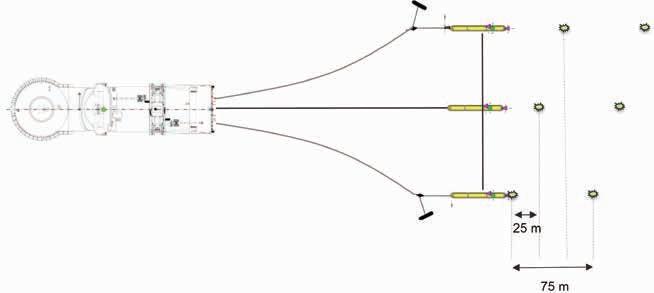

To overcome the limitations associated with the use of non-standard umbilicals (i.e of 1.25’’ diameter), the minimum refilling time allowed by the air supply chain needs to be decreased. This is the purpose of our in-sea PRS (Figure 3), which allows a supply pressure that is higher than the operating pressure of the source. By comparing the 1000 psi and 2000 psi tables in Figure 2, it is possible to assess the expected improvements with increased supply pressure.
Higher inlet pressure has a significant impact on refilling capability. The minimum refilling time achievable with a 500 m –1’’ umbilical would be around 17 seconds using our PRS solution with a 2000 psi inlet pressure, well below our targeted 36 s.
The Sercel in-sea PRS allows the TPS to be fed up to 2000 psi while the shooting pressure remains at 1000 psi.
Finally, the analysis and modelling confirmed the capability of standard compressors to supply a triple TPS source for an SPI as low as 25 m, with either a specific 1.25” umbilical, or a standard 1” umbilical combined with an in-sea PRS. This confirms that the TPS can be configured as a triple source on most seismic source vessels using their standard source ancillary equipment in combination with our in-sea PRS.
To reach compressor consumption, is it better to reduce the pressure or the volume?
To go further in our investigations of survey configurations in very challenging conditions where compressor capacity is limited, we studied the impact on TPS acoustic signature if there has to be a compromise on the firing pressure or the source volume.
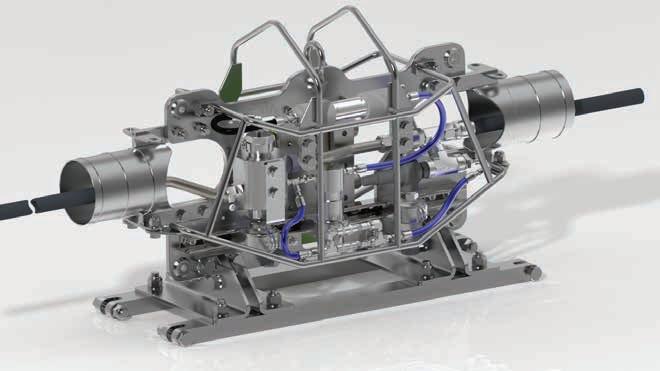

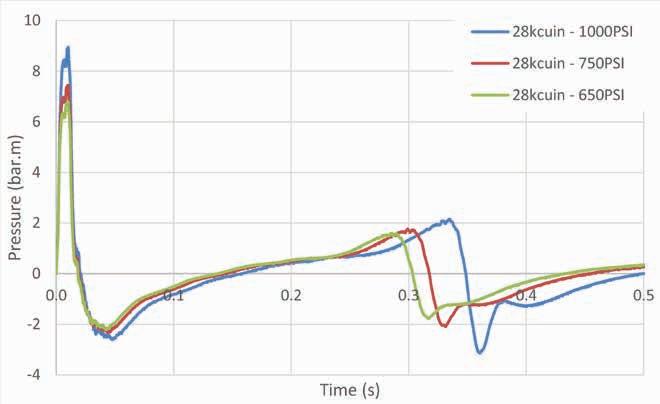

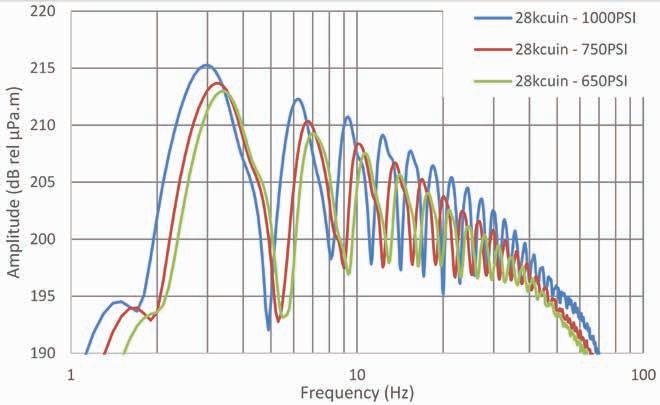
The period of the bubble and its peak pressure are defined by the two following formulae:
The Willis formula of the period (T) implies that the pressure (p) and the volume (V) are both to the exponent 1/3. A 35% reduction in the volume is therefore equivalent to a 35% reduction in the pressure. This effect of equivalence can be observed on variations in the first harmonic (Figure 4b). For the peak pressure, the volume is usually exponent 1/5 and the pressure exponent 2/3. So, the peak pressure is more sensitive to pressure variations than to volume variations (Figure 4a).
At low frequencies, the combined effects of frequency and amplitude shifts can be represented by the amplitude at 2.5 Hz.
Notably, for the same compressor power consumption, the amplitude at 2.5 Hz is higher in the reduced-volume configuration compared to the reduced-pressure configuration. Specifically, at 2.5 Hz, the configuration with a reduced volume (18 kcuin @ 1000 psi) results in a peak amplitude of 206 dB, whereas the configuration with a reduced pressure (28 kcuin @ 650 psi) produces 204 dB. This indicates a 2 dB increase when the volume is reduced while maintaining higher pressure.
Field trial results: refilling a triple TPS source
A triple TPS source configuration was successfully tested at sea with Viridien and TGS at the end of the Laconia Phase III survey.
Each TPS was fitted with a PRS regulator and deployed with a 133 m lateral source separation. Separation was limited by the vanes available onboard. The vessel was equipped with three compressors SAPS 62 delivering (2200 CFM) each.
All three compressors operated at a maximum output of 186.8 m³/min with 1.25’’ air line umbilicals of 402 m, 650 m and 500 m. The test included two parts: Part 1 in flip-flap-flop mode
without dither, and Part 2 in Flip-Flip (synchronised +/-2 s dither) shooting mode.
The main goal of Part 1 was to determine the minimum shooting time needed for a full and sustainable refill of the TPS sources. Equipped with the PRS and 1.25’’ umbilical airline, the capacity of the compressors became the limiting factor. The compressors could deliver an airflow rate of 3.1 m³/s, resulting in 27.9 m³ of air in 9 seconds. Combined with roughly 3.1 m³ of air remaining in the chamber after each shot, this resulted in a complete refill of 31.1 m³ of air (28000 in³ at 1000 psi). Shooting faster than 9 seconds prevented the manifold pressure from being

stabilised, meaning that compressors cannot provide enough air to the source (see Figure 7). Additionally, at 9 seconds, no air was venting from the manifold Fisher valve, indicating that the source was using 100% of the delivered air without back pressure from the air lines. The absence of air vented also confirms the 9-second limit is driven by compressor capacity and no longer by umbilical specifications. It was possible to overcome this umbilical limitation with our PRS which pushes back the umbilical limitation far more after the compressor limitation.
This field test was also an opportunity to confirm the validity of our refilling simulation tool as the 9 seconds achieved are in



during triple-source acquisition showing a shot every 9 seconds (3





line with the 10 seconds computed by our simulation tool (see Figure 8).
The vessel was travelling at 4.5 knots (i.e 2.31 m/s), resulting in an SPI of approximately 20.9 m. This precisely matched Part 2, the flip-flip test, which had an SPI of 27 seconds and 62.7 m.
Finally, this field test demonstrates that a triple TPS source enables an efficient survey with a 28000 cu.in shot every 25 m. The refill time of approximately 11 seconds pushes compressor load to 85%, resulting in a SPI of 25 m at 4.6 knots which is within normal operating ranges. When equipped with larger vanes, a 200 m source separation could significantly increase the distance between sail lines and hence lower survey costs by reducing the number of lines required to image an area.
This article presents a case study that validates the feasibility of efficiently operating the TPS in a triple source configuration using a single-source vessel with the current compressor capacity, while maintaining high productivity levels. This configuration effectively produces a robust broadband seismic source. During the pre-survey analysis and design phase, simulation tools played a critical role in designing the activation sequence for each source to safely and efficiently optimise productivity. The in-water Pressure Regulator System (PRS) now enables deployment of a triple TPS configuration on a source vessel with a 25 m shot point interval. All the above calculations can be adjusted for the purpose of a seismic survey and must be assessed by a full survey design analysis to comprehensively evaluate the performance of low-frequency source technology and its potential for further surveys.
We would like to thank Viridien and Sercel for permission to publish this work. We also thank Viridien’s Earth Data team and the vessel crew for enabling and supporting the first successful deployment of a TPS triple-source configuration.
Allemand, T., Herrmann, P., Laroche, S., Ronen, S., Aznar, J., Large, J., Baeten, G., Kryvohuz, M., Perkins, C., Shang, X., Tang, Z., Theriot, C. and Wang, K. [2023]. Joint deblending and designature of multi voice-data: a marine example. 84th EAGE Annual Conference & Exhibition, Extended Abstracts
Aznar, J., Kuvshinov, B., Baeten, G., Macintyre, H., Large, J. and Ronen, S. [2022]. Successful modelling and sea trial of new low frequency sources using standard onboard air supply. First Break, 40(11), 77-81. Benaniba, M., Aznar, J., Laroche, S., Herrmann, P., Ronen, S., Large, J., Shukri, S. B., Rajasansi, T. K., Singh, S., Teck, L. C., Akasyah, F., Karri, C. A., Neill, E. and Walker, C. [2024]. Industry-first deployment of simultaneous source acquisition using a Dispersed Source Array with Tuned Pulse Source and conventional airgun for a shallow water seismic survey offshore Malaysia. First Break, 42(11), 59-65.
Kaur T., Shukri, S. B., Jamaluddin, A. H., Teck, L. C., Zawawi, M. Z. M., Hoong, T. W., Sulaiman, M. S., Rahman, N. N. B. A. and Large, J. [2024]. Pilot Evaluation of Ultra Low-Frequency Source in Carbonate Reservoir at Central Borneo, Malaysia. Asia Petroleum Geoscience Conference & Exhibition, Extended Abstracts
Meritt, M., Baeten, G., Rambaran, V., Godfrey, K., Bianchini, K., Brothers, T., Chelminski, F., Hao, A., Gao, H., Su, Y. and Wei, Z. [2024]. Revealing the subsalt in Garden Banks with a sparsely-shot TPS OBN and FWI. 4th International Meeting for Applied Geoscience & Energy (IMAGE24), Expanded Abstracts.
























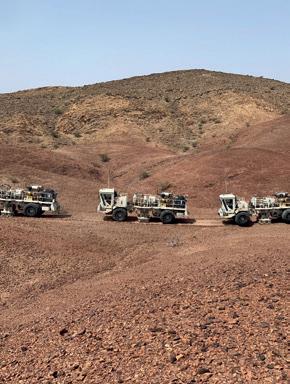








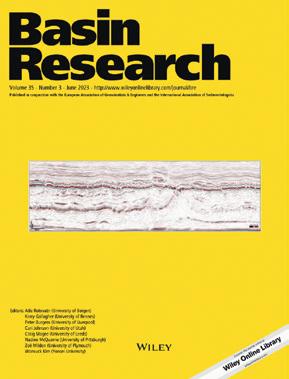






















































































































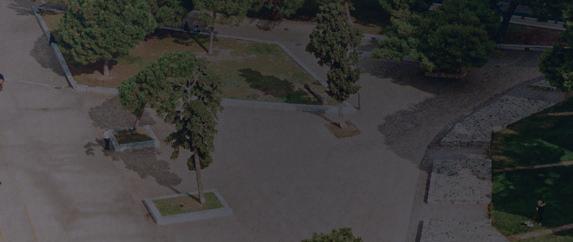

















































Ali Tura1*, Roman Yermakov1, Ole Edvard Aaker 2, Ørjan Pedersen2, Andrea Damasceno3, Marcella Rapini Braga3, Sarah Lim Suet Hoey4, Lokesh Ambati 4, Nurul Nadzirah A Rahman 4 , Sandeep Kumar Chandola 4, Ahmad Riza Ghazali 4, M Firdaus A Halim 4 and Bjorn Olofsson5 demonstrate recent industry applications of PS-wave data to show improvements in elastic Full Waveform Inversion (FWI), quantitative direct hydrocarbon indications, subsalt reservoir characterisation, imaging under complex overburden, such as shallow gas, enhanced timelapse seismic analysis and estimation of pore pressure in the overburden and reservoir.
Abstract
Converted PS-wave data are recorded mostly on horizontal receiver components while acquiring offshore ocean bottom cable (OBC) or node (OBN) data and onshore with three-component (3C) receivers. Even so, over the years, the industry has not been utilising this data to its full potential. With modern acquisition and advanced processing there are multiple applications where PS-waves make a strong value statement and can be utilised more extensively to improve exploration and production success. In this paper we show a collection of recent industry applications of this technology to multiple case studies demonstrating the value and improvements in areas such as elastic Full Waveform Inversion (FWI), quantitative direct hydrocarbon indications, subsalt reservoir characterisation, imaging under complex overburden, such as shallow gas, enhanced time-lapse seismic analysis and estimation of pore pressure in the overburden and reservoir. We also discuss the status of PS data processing and factors impacting PS data quality.
Building accurate S-wave velocity models (Vs) from reflected shear waves is difficult. A major challenge in utilising conventional elastic FWI, or the related method of Reflection Waveform Inversion (RWI), is the intrinsic crosstalk between P and S wave-modes. This crosstalk can hinder convergence, particularly for immature Vs models. Aaker et al. (2024) described a novel
solution which enforces FWI and RWI to strictly distinguish between the P- and S-modes in the misfit functional, thereby eliminating wave-mode crosstalk. In this section, we apply this methodology to field data from the Norwegian Continental shelf, with the objective to update the Vs model by matching modelled PS reflections to those in the observed field data.
The input data were recorded at 25 m x 300 m receiver spacing and a 25 m x 25 m source spacing, in a setting with water depths around 110 m. The input data were pre-processed, including steps such as PS separation, splitting corrections and demultiple by Radial/Down Deconvolution (RDD). Seven receiver lines were selected for a test area. Legacy results of Vp (P-wave velocity), Vs, and Thomsen anisotropy parameters Epsilon and Delta were used as input to the inversion. In this application, Vp was kept relatively detailed (originally built from FWI up to 30Hz), Vs was smoothed more heavily, and the anisotropy parameters were kept unmodified. A reciprocal PS decomposition operator for elastic Vertical Transverse Isotropy (VTI) media was developed for PS mode-decomposition of the modelled data for FWI, while accounting for source-receiver reciprocity.
The first inversion step updated the long-to-intermediate wavelengths of the Vs model by PS RWI, where the inversion cycled between: a) estimating a PS reflectivity model by PS FWI using an L2 misfit functional, and b) subsequently updating Vs by PS RWI with a Graph Space Optimal Transport misfit functional (adapted to the mode-decomposed application). This cycling workflow of PS RWI is graphically depicted in Figure 1.

Corresponding author, E-mail: alitura@mines.edu
DOI: 10.3997/1365-2397.fb2025089
Figure 1 The PS RWI workflow cycles between estimating a PS reflectivity through PS FWI and using this reflectivity to update the long-to-intermediate wavelengths of the Vs model by PS RWI ( ‘rabbit-ear’ kernel).

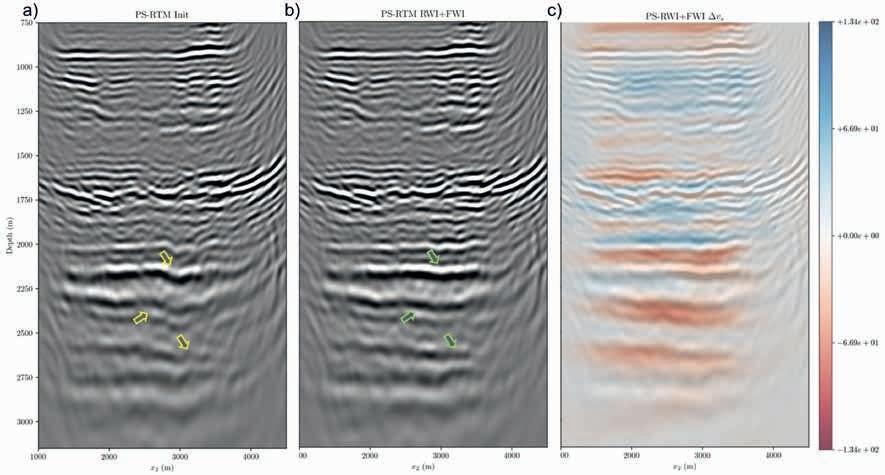
On the back of this, we added details to the Vs model using PS FWI. No PP data nor PP reflectivity were used in either step of this case study. Figure 2a) shows an inline of an elastic PS Reverse Time Migration (RTM) Quality Control (QC) image computed at 20 Hz in the initial model, at a decimated receiver grid of 100 m x 300 m. Several structural undulations due to an inaccurate initial Vs model can be observed throughout the image (e.g., yellow arrows). When imaging with the RWI+FWI Vs model, Figure 2b), the structural undulations have been improved and the focusing response has been increased (e.g., green arrows). Overlaying the changes to the Vs model, Figure 2c), demonstrates good structural consistency of both the low- and high-wavenumber updates to the model. In a similar fashion, Figure 3 shows the improvements brought by PS RWI+FWI through a crossline location, with structural corrections achieved below complicated sand injectites in the overburden.
Applications
Several publications have demonstrated the benefits of using PS data to improve the quality of elastic inversion results, particularly for S-impedance and Vp/Vs ratios (Veire and Landrø, 2006; Damasceno et al., 2021; Tura et al., 2021). Moreover, in the case of Brazilian pre-salt reservoirs, elastic information is essential for distinguishing lithologies with overlapping acoustic properties.
The data in this section is from a field in Brazil with water depths of about 2000 m and OBN acquisition with receivers on a 500 x 500 m grid and the source grid has a sampling of 50 x 50 m. The PP and PS data are processed with Kirchoff migration. The results obtained from processing OBN PS data were
Figure 2 Inline section through the PS RTM QC volumes computed in a) initial model b) Vs model estimated by PS RWI + PS FWI, with c) showing the inverted Vs changes (units m/s) overlaid on the corresponding PS RTM stack (b).
Figure 3 Crossline section through the PS RTM QC volumes computed in a) initial model b) Vs model estimated by PS RWI + PS FWI, with c) showing the inverted Vs changes (in units m/s) overlaid on the corresponding PS RTM stack (b).
seen to be surprisingly good (see details in ‘PS Data Processing and Quality Discussion’ section below). In the pre-salt interval, PS images have a good signal-to-noise (S/N) ratio and are quite compatible with PP data. The next step was to evaluate whether this data would improve elastic inversion results, enabling better reservoir characterisation.
After the velocity model building step, tests of elastic inversions were done to assess the value of adding the PS data in the inversion process. Jason software was used to run PP-only and joint PP-PS elastic inversions. In this project, four PP and three PS partial-stacks were available, with the mean angles (in degrees) chosen as follows: for PP stacks - 8, 16, 24, and 32; for PS stacks - 22.5, 34.5, and 46.5. The angle ranges for PS partial stacks were decided based on maximising the S/N ratio of these volumes.
To evaluate the gain from joint PP-PS inversion, two sets of elastic inversions were performed: 1) using exclusively PP data as input; 2) using the complete set of PP and PS stacks. The methodology applied in the joint inversion is based on the approach detailed in (Damasceno et al., 2021). The most challenging step in joint PP-PS inversion is to ensure the best alignment between the PP and PS data, since these stacks have different frequency and phase content. Therefore, the workflow applied in this test was designed to optimise the alignment of the PP and PS data. The low-frequency model was built using 68 wells (only 30 in the area covered by PS data) and 5 available horizons. The wavelet estimation for the PP stacks was done using data from 30 wells, while for the PS data, only three wells located in areas with higher S/N ratios were used. The weights assigned to each stack in the inversion parameterisation are related to the S/N ratios of each
volume. Thus, we set PS stacks weights 50-60% lower, compared to the PP stacks. The chosen merge frequency for both inversions was 10 Hz.
The comparison of the two inversions is shown in Figure 4. As predicted by theory (Veire, 2006), and demonstrated in the next section, the P-impedance (Ip) property does not benefit significantly from the use of PS data in the inversion. On the other hand, the comparison between the S-impedance (Is) volumes generated by the two inversions shows significant differences. The Is volume generated by the joint inversion exhibits higher resolution. Note that the joint inversion result presents thinner and well-defined layers, which illustrates the gain at high and low frequencies, respectively. Furthermore, the fit of the inversion to the Is well log is much better in the joint inversion (e.g., see green arrows), with the amplitudes better matching the Is values. There is also a gain in lateral continuity with the use of PS data in the inversion.
The Vp/Vs ratio is very important for lithological distinction in pre-salt reservoirs and estimating Vp/Vs ratio from PP inversion is very difficult since the estimation of this attribute is unstable and the property contrasts are small. As can be seen in Figure 5, the gains provided by using PS data in the inversion of this attribute are obvious (compare top and bottom figures). The improvement in resolution and fit with the wells obtained via joint PP-PS inversion are even more noticeable in the Vp/Vs section versus the Is section.
From this pre-salt study we see that the joint PP-PS inversion provides multiple improvements in the subsurface understanding: shows better delineation of the mudstone layer between porous carbonate intervals (highlighted by the green arrows), highlights carbonate growth geometries, such as those in wells Well-2 and Well-6, helps to predict the presence of seismically detectable anhydrite at the base of the salt, which was present in well 6 but not in well 5 (region highlighted by the black dashed ellipse).
AVO/AVA is a key Direct Hydrocarbon Indicator (DHI) but success with this exploration method has been limited to cases where the fluid signature is substantial in the seismic data (unconsolidated and high porous formations). In more subtle fluid signature applications AVO analysis is known to be problematic (Roden et al., 2013). Since time-lapse (4D) seismic data is sensitive directly to fluid saturation and pore pressure changes, it is an excellent way to demonstrate how AVO/DHI can be improved with joint inversion of PP and PS data vs PP data alone.
Edvard Grieg Field Case Study
4D field data from the Edvard Grieg oil field in the Norwegian North Sea is utilised to show the AVO improvements with joint inversion. The data was acquired in 110 m water depth with OBCs in 2016 (with the start of water injection and after a year of


Figure 4 The comparison of S-impedance volumes between PP-only (top) and joint PP-PS (bottom) indicate intervals where the joint inversion results provide a better fit with well logs (green arrows). Additionally, the joint inversion shows improvements in resolution and lateral continuity.
Figure 5 The comparison of Vp/Vs ratio volumes between PP-only (top) and joint PP-PS (bottom) inversions emphasises the benefits of the joint inversion, with green arrows marking areas of improved well fit, better matching the log amplitudes. The black dashed ellipse highlights a basal anhydrite interval at the base of the evaporite sampled in well 6 but not in well 5. The conventional PP-only inversion incorrectly suggests basal anhydrite in both wells, whereas the joint inversion accurately identifies it only in well 6 due to its enhanced stability.


depletion) and repeated in 2022. For both acquisitions we have 200 m cable spacing with 25 m receiver spacing and source spacing of 25 m along the cable direction and 50 m crossline. The results of the AVO inversion are shown in Figure 6 for PP data and for joint inversion of PP and PS data (see Tura et al., 2024, on the method used to get to these results). The horizontal axis is 4D changes in Ip and the vertical axis is 4D changes in Is from AVO inversion. The different coloured data points are taken from regions in the field where pure pressure and saturation changes are expected. In these applications, we expect the fluid-related changes to be close to the horizontal axes (no shear modulus change) and pressure changes to be more along the diagonal (shear modulus change). As can be clearly seen, the improvements in the Is with the joint inversion has moved the data points to the correct or expected locations. For example, the yellow gas (fluid) changes and dark-blue water replacing oil (fluid) changes are 7 degrees from the 4D Ip axes. Also, injection and depletion pure pressure points have moved towards the diagonal at 70 degrees for this field (meaning Is is more sensitive to pressure then Ip.).
This example clearly demonstrates that the AVO parameters have been improved with joint inversion allowing a better
Figure 6 4D P- and S-impedance inversion with PP pre-stack data (left) and joint PP+PS pre-stack data (right). Green dots are from the region around producers with pressure decrease (hardening), dark-blue dots are from region around water-front (hardening), red dots are from the water injector W-2 (softening), light-blue dots are from the water injector W-1 (softening) and orange dots are from the water-alternating-gas injector W-3 (softening). Pure saturation changes would be along the 7 degree Sw axis and pure pressure changes could be around the 70 degree pressure axis. Note improved separation/ distribution of saturation and pressure changes along the pure change axis with joint inversion due to better 4D S-impedance estimation.
Figure 7 Decoupled pressure and saturation changes from joint PP+PS inversion. Pressure increase at injectors (top-left), pressure decrease at producers (top-right) in bars. Water saturation increase (bottomleft) and gas saturation increase (bottom-right) in per cent. Seismic impedances have been calibrated to engineering values of bars for pressure maps and per cent change for saturation maps.
DHI and 4D interpretation. In fact, with these more quantitative results, we can now convert seismic impedances to reservoir engineering fluid changes (in per cent) and pressure changes (in bars) as shown in Figure 7. Here, pressure increase is strongest at injectors W-1 and W-2 estimated at around 30 bars, pressure decrease is strongest at the producers under the platform with a small amount estimated at 6 bars, water saturation increase shows progression of the water front with an estimate of 40% saturation change or sweep efficiency, and gas saturation increase shows an area of gas injection near well W-3 at 0.5%.
Using PS to invert for AVO/DHI is clearly demonstrating more accurate results versus using PP alone.
Following the field data example, here we show on modelled data why PS data can help to improve the AVO/DHI analysis by allowing more reliable and quantitative inversion results. For this we again use time-lapse seismic data to clearly emphasise the improvements in estimation of fluid properties. Using the linearised Zoeppritz equations (Aki and Richards, 1980) it is
possible to model PP and PS AVO/AVA data for a two-layer medium. For the example here, we choose the Ostrander (1984) gas sand overlaying shale classical model. For this model, on the top layer, we have 2438 m/s for Vp, 1625 m/s for Vs, and 2.14 g/cm3 for density, and for the bottom layer, we have 3048 m/s for Vp, 1244 m/s for Vs, and 2.40 g/cm3 for density. Next, we generate synthetic seismic PP and PS AVA data with 1000 randomised signal-to-noise (S/N levels realisations and invert these data with different maximum reflection angle ranges (see also Tura et al., 2022). Given that we know the exact answer for the three AVO inversion parameters; P-impedance (Ip), S-impedance (Is), and density, we can calculate the percentage error in estimation of these parameters for each realisation for PP only, PS only, and PP-PS joint inversion. The errors in these realisations are then averaged, and percentage errors are calculated and shown in Table 1. Here we can clearly see the reduced error and the value of adding PS data in the inversion. In fact, we note that even with small amounts of noise (S/N of 10) the Is from PP data alone can be substantially incorrect leading to inaccurate exploration drilling or field development decisions. From here, we see that the best way to invert for all three parameters is to get Ip from PP
and Is from PS or get both Ip and Is from joint PP-PS inversion. Using only PP waves is a deficient inversion process which can produce incorrect DHI results.
We further clarify this by conducting a singular value decomposition of the AVO equations. The results are for Ip, Is and density from PP data, PS data and joint inversion of PP and PS data as shown in Figure 8. Here we see that Is is significantly improved with joint inversion or just PS inversion. Further, density inversion can be much more accurate with joint inversion.
This study demonstrates that reservoir characterisation in shallow gas-affected fields can be improved with PS data. For this purpose, a tailored OBN acquisition geometry with 300 m receiver line spacing with 25 m receiver interval and 100 m source line spacing with 50 m shot interval was designed to maximise the utility of PS-wave data and overcome the challenges of imaging beneath shallow gas. The water depth in this field ranges from 58 m to 73 m. Pre-stack depth migration (PSDM) images are shown in
Inversion type: Joint PP/PS
Table 1 AVO inversion results for PP only (top), PS only (middle) and joint PP+PS (bottom) for 1000 random realisations of S/N levels (rows). Percentage difference (% Diff column) shows the difference between exact values from the model versus average AVO inversion result for the 1000 random realisations for P-impedance changes (left), S-impedance changes (middle) and density changes (right). For S/N of 10, note improvement in S-impedance (red circles top and middle) and density (blue circles top and middle) going from PP data only to joint PP+PS inversion. Further, similar improved results can be obtained for S-impedance and density by only using PS data (bottom red and blue circles).



Figure 9 where the value of PS imaging within complex structures for accurate seismic interpretation, well optimisation, and static/ dynamic reservoir modelling can be clearly seen below the shallow gas zone (yellow arrows on right side of figure). PP and joint PP-PS inversion is applied to the PSDM data and results are shown in Figure 10. Given the high quality of the PS data, pre-stack PP-PS simultaneous inversion is seen to significantly enhance reservoir characterisation in this shallow gas-affected field compared to conventional PP inversion. Key workflow adaptations, such as event registration optimisation, well-to-seismic calibration, and
Figure 8 Singular value decomposition values for P-impedance (red), S-impedance (blue) and density (green). Dashed line with circle is for PP data only inversion, solid line with triangle is for Joint PP+PS inversion, dashed line with plus is for PS data only inversion. Note significant improvement in S-impedance and slight improvement in density going from PP only to joint PP+PS.
Figure 9 Pre-stack depth migration imaging improvements with PS data: 2021 streamer PP image (left), 2024 OBN PP image (middle), and 2025 OBN PS image (right). Improvement in imaging target zones with PS data are indicated by yellow arrows.
Figure 10 Inversion results from OBN data: S-impedance results from PP inversion (top left), S-impedance results from joint PP-PS inversion (top right), P-impedance and S-impedance sections from PP inversion (bottom left), P-impedance and S-impedance sections from joint PP-PS inversion (bottom right). Note improvement in inversion especially in S-impedance.
low-frequency modelling, enhance subsurface imaging and inversion accuracy. The integration of PS data, which is less impacted by gas-related attenuation, leads to more accurate porosity predictions and improved reservoir modelling. A two-stage event registration process, utilising a laterally and vertically varying Vp/ Vs ratio, ensures precise PP-PS alignment, while Knott-Zoeppritz approximations further refine inversion reliability. By overcoming gas cloud imaging limitations, joint inversion provides clearer reservoir imaging, better hydrocarbon identification, and reduced exploration risks. Additionally, multi-well wavelet extraction and
low-frequency modelling enhance Ip, Is, Vp/Vs, and density models. Ultimately PS imaging and inversion effectively improves reservoir characterisation, field-compared uncertainties in hydrocarbon evaluation and significantly enhances accurate seismic interpretation for well drilling and reservoir modelling.
This study demonstrates that PP-only workflows are significantly impaired in the presence of shallow gas due to velocity pushdown, attenuation, and the loss of critical reflectors, all of which introduce substantial uncertainty in subsurface interpretation. By contrast, properly adapted PS workflows that incorporate non-hyperbolic moveout corrections, advanced statics handling, mode-aware imaging, and joint inversion calibrated with well control and attenuation compensation deliver materially improved results. These enhancements manifest as higher-resolution images, sharper impedance contrasts, and more reliable predictions of reservoir architecture beneath gas-charged overburden. Consequently, for exploration and reservoir characterisation in gas-prone shallow settings, the integration of PP and PS data should be regarded not as an optional extension but as an essential component of risk reduction and decision-making, ensuring more robust subsurface models and improved confidence in reservoir evaluation.
PS wave reflection coefficients are related to Is and density. Is can be obtained through PS-wave AVO inversion directly or approximated by stacking PS-wave data. Is is related to shear modulus and density and therefore mostly sensitive to lithology and pressure but not very sensitive to fluids. Therefore, the PS data provide an advantage over PP data when extracting pore pressure information from the seismic data since the variables are reduced due to non-sensitivity to fluid component. Several authors have recently used this advantage for pore pressure prediction (see Mazumdar et al., 2023). However, this can again be clearly demonstrated on time-lapse seismic data. In the previous section we showed how joint PP and PS inversion can improve pore pressure prediction. Here we focus on stacked data PP and PS time-shifts to illustrate the sensitivity of the PS data to pressure changes (see also Tura et al., 2023). For this demonstration time-lapse time-shifts are calculated from the Edvard Grieg North Sea time-lapse PP and PS stacked seismic data. These results are shown in Figure 11 where a
time-shift decrease (softening in blue) is seen at the injectors W-1, W-2 and W-3 both on the PP and the PS time-shifts as indicated by the green circles in map view and section view along A to A’. Note that the pressure changes at the injectors are much clearer on the PS time-shifts versus the PP time-shifts in the cross sections, indicating higher sensitivity of PS data to pressure. Around the producers, the PS time-shifts show clearly a pressure decrease (time-shift increase in red) in the shape of a horseshoe (see black circle on PS time-shift map view). In this area there is minimal pressure drop in the order of 6 bars. The time-shift increase in red can also be clearly seen along the A to A’ cross section (black circle at the producer). It is important to note that since density is not sensitive to pressure changes, around the producers with no saturation change, the shear impedance is a direct indicator of pressure changes (through the sensitivity of the shear modulus to pressure changes).
The number of offshore multi-component seismic acquisitions has been growing for the last 15 years due to advances in node technology and seismic acquisition. It is now common to acquire good quality PS converted waves with modern high-quality offshore 4C systems (OBC, OBN, Permanent Reservoir Monitoring (PRM)) that provide good ground coupling of the horizontal components. Ideal survey design for converted waves still requires finer receiver sampling but recent examples show successful PS imaging with sparse OBN sampling (Braga et al, 2024). Remaining data quality challenges include near-surface heterogeneities which can cause distortions in the recorded wavefield and unconsolidated shallow sediments leading to strong S-wave attenuation. Hence, recorded PS data quality and frequency content in each area should be checked early to ensure they meet expectations. Arguably one of the biggest hurdles to greater adoption of PS data products is its often-lower absolute frequency content. It is important to note that since the S-wave velocity is lower than P-wave velocity, lower frequency content does not directly translate into lower resolution since wavelength is velocity divided by frequency. However, as demonstrated earlier, even in the case of lower resolution, PS data provides complementary and valuable elastic information about the sub-surface.
Processing of PP data has been evolving over time, mainly in the pre-migration processing and Vp model-building for imaging

Figure 11 4D time-shifts from stacked PP and PS data. Pressure increase at the injectors is more strongly visible on the PS time-shifts around injectors W-1 and W-2 (positive blue colour, compared with circles). Further, pressure depletion at producers are visible only on the PS time-shifts (negative red colour, compared with black circles).
(Ristow et al., 2024). Nevertheless, processing-converted PS wavefields are still considered a niche capability despite substantial historical industry experience, primarily due to difficulties in adequately sampling these waves.
Conventional PS data processing closely follows PP processing but there are several unique steps which require specialised tools and workflows, in particular: Orientation and rotation, S-wave statics, S-wave splitting, demultiple, Vs model-building, and PP-PS event registration. Imaging algorithms also need to be adjusted to consider the asymmetric PS ray path. Noise content in PS gathers can be quite different from P-wave data. For example, while (offshore) PP data is often dominated by multiple energy, PS data can also contain strong energy from complex mode conversions, as well as noise and distortions related to coupling and the near surface. If present, S-wave splitting can further distort the signal. S-wave splitting in most rocks is caused by micro-cracks or crack-like deformations aligned in the direction of maximum compressional stress. As a first order approximation, S-waves travelling through such rocks split into two semi-perpendicular polarisations, the so-called fast (S1) and slow (S2)-waves (see for example Gaiser, 2016). Local stress, and therefore magnitude and orientation of S-wave splitting, can vary with depth due to the sediment’s depositional history and/or a present dynamic stress regime. S-wave splitting experienced along the ray path must be reversed (e.g., Boiero and Bagaini, 2019), either by a pre-migration correction or within the migration algorithm. Otherwise, the frequency content and overall quality of the final image can be severely compromised. As a side product, this process yields a 3D S-wave splitting field containing information about the local stress and state and crack density (Olofsson et al, 2003). A fundamental limitation of conventional PS processing and imaging are the inherent assumptions made in the Radial/Transverse rotation and processing of the Radial component only: The rotation itself is based on the surface source-receiver azimuth (basically assuming a 1D earth) while lateral heterogeneities in the velocity model can cause additional signal loss into the Transverse component. Such limitations will only be overcome when moving to a full physics multi-component elastic FWI workflow.
The velocity model-building step is essential for obtaining migrated data of high quality in terms of amplitude response and
correlation with PP data, so that it can be used as input for joint PP-PS elastic inversions. Furthermore, from Vp and Vs volumes, it is possible to calculate and interpret elastic parameters such as the Poisson´s ratio and Vp/Vs ratio. This is shown in Figure 12 from the offshore field in Brazil discussed earlier.
Usually, the P-wave velocity model is built using only the Hydrophone component or a combination of hydrophone and vertical geophone when separating upgoing and downgoing wavefields. Techniques such as tomography and FWI are used to update the Vp model. The anisotropy model is built using PP data possibly with help of walkaway VSP data. However, it should be noted that PS data provides an opportunity to further improve the anisotropy model by joint PP and PS tomography (Mathewson et al, 2018).
The initial Vs model is based on well-log data (when available) and empirical relationships between Vp and Vs. However, the Vs values in the first hundred metres below the water bottom are usually unknown. Direct Vs measurements obtained through geotechnical boreholes can be helpful in defining the trend of Vs from the seafloor and provide an initial model that is closer to reality. These measurements in offshore Brazil have shown that on average Vs increases from very low values (10-30 m/s) to 250 m/s in the first 60 m below the sea floor. The updates of Vs have been accomplished using a registration method in which we minimise depth differences between corresponding events in PP and PS data. The main challenge in this process is the correlation of PP and PS events, given that they do not always have the same phase or amplitude distribution.
The use of conventional tomography based on residual moveouts is feasible when the quality of the migrated Common Reflection Points (CRPs) allow for moveout picking, that is, generally in data with higher receiver density or for deeper targets. The use of advanced techniques for updating Vs, such as elastic FWI discussed here (see also Bulcão et al., 2023; Cho et al., 2022; Ning et al., 2024) and shallow refraction tomography (Bezerra et al., 2022) has also shown promising results.
For PS data imaging, acoustic Kirchhoff and Reverse Time Migration (RTM) algorithms can be used, adapted for different propagation velocities from the conversion point to the receiver positions. The RTM algorithm has proven to be suitable for handling complex data, as previously anticipated. Salt domes and
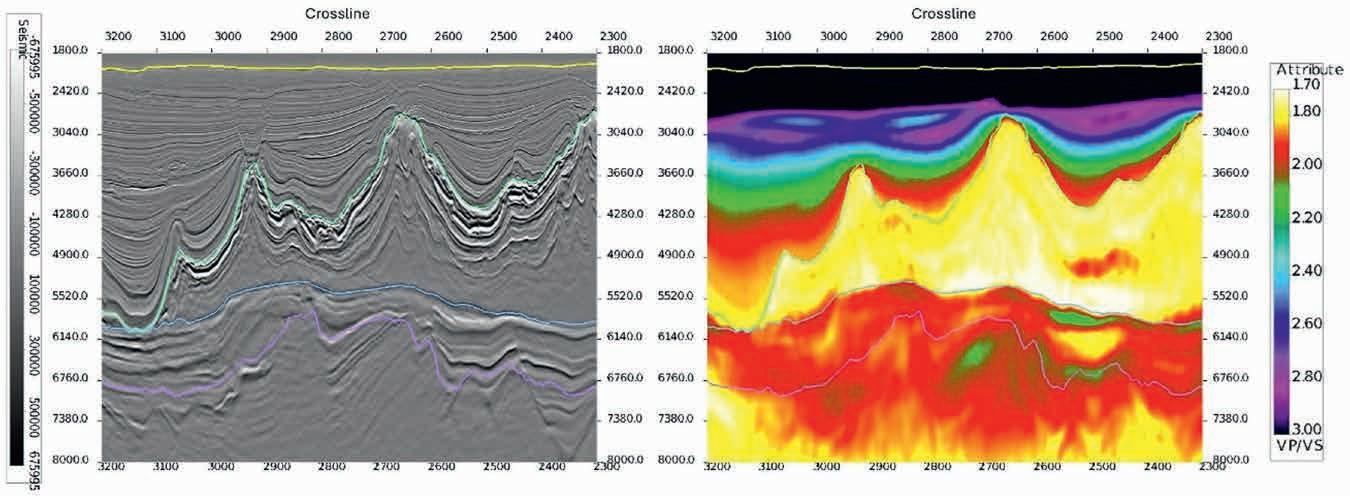
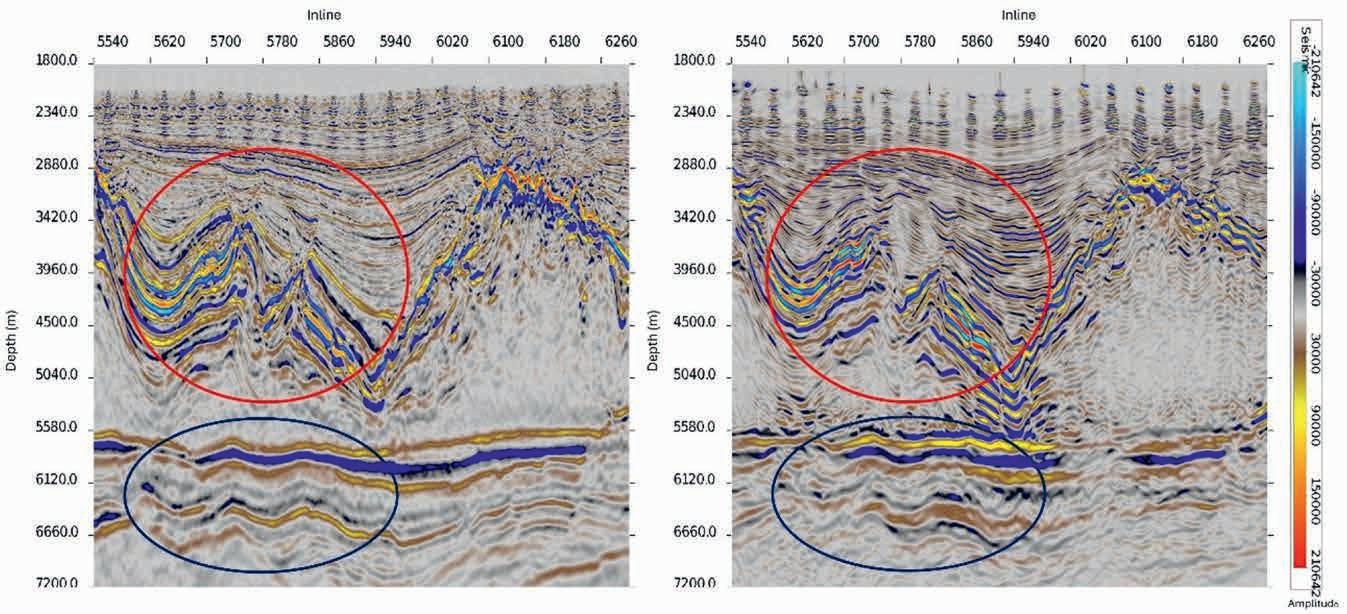
other large impedance contrasts cannot be properly imaged by the Kirchhoff algorithm. On the other hand, the implementation of RTM for PS data requires appropriate handling of low velocities (less than 300 m/s) found in the sedimentary section near the seafloor, since the need for very fine propagation grids becomes a computational issue. In Figure 13 we have a PP upgoing section and the corresponding PS section after migration using a Kirchhoff algorithm from the offshore Brazil field discussed earlier. In the region of the red circle, there is a good correlation between the events in both sections, including the faults. In the blue circle, there is a strong and coherent signal in the PS section, with structures that are consistent with the PP image. However, the salt flank is not properly imaged.
We emphasise that PP and PS images must also be properly aligned for joint interpretation or inversion. This ‘event registration’ process is not straightforward due to differences in PP and PS reflectivity, frequency and noise content as well as illumination. It should be aided by ties to well synthetics, and it is best practice to follow up any registration in the time or depth domain with a residual post-migration alignment after inverting both PP and PS angle stacks to S-impedance.
In this article we have shown multiple examples on the industry value of converted PS data that is readily recorded with ocean bottom cable and node acquisitions or multi-component acquisition on land. Our goal was to show how modern data acquisition and processing can lead to improved business practices and successful exploration and development (E&P) programs with converted waves and that novel developments in PS processing/ waveform inversion are improving the applicability of PS seismic, which will permit better exploitation of the benefits of PS waves. Our conclusions are that there are multiple avenues where PS waves have a sole or added advantage to PP data as shown by multiple case studies in this paper. In the future we expect that successful E&P programs will incorporate PS data
in their day-to-day work. Further, some new applications of PS data, such as ocean bottom and borehole Distributed Acoustic Sensing (DAS), have not been included in this paper and provide future scope for use of PS data (see for example Brager et al., 2025).
We thank the Ivar Aasen licence operator Aker BP and the partners: Equinor, DNO, OKEA and M Vest Energy for permission to publish the Ivar Aasen data example, Edvard Grieg field operator Aker BP, and partners OMV and Harbour Energy for permission to publish the Edvard Grieg data example, Petrobras for giving permission to publish the examples from offshore Brazil and Petronas for giving permission to publish the examples from offshore Malaysia. We also thank sponsors of the Reservoir Characterization Project (RCP) at the Colorado School of Mines (CSM) for their financial support of this work.
Aaker, O.E., Pedersen, Ø. and Raknes, E.B. [2024]. Elastic reflection waveform inversion with a novel PS mode-decomposed misfit functional. 85th EAGE Annual Conference & Exhibition, Extended Abstracts
Aki, K. Richards, P. [1980]. Quantitative seismology: Theory and methods. Freeman.
Bezerra, M., Simmons, J. and Gaiser, J. [2022]. Seafloor elastic parameters estimation using a regression neural network. Second International Meeting for Applied Geoscience & Energy, Expanded Abstracts, 3671-3675.
Boiero, D. and Bagaini, C. [2019]. S-wave splitting intensity analysis and inversion. Geophysical Prospecting, 67(2), 362-378.
Brager, D., Wilk-Lopes, M., Bachrach, R., Sonika, S., Thorgersen, C., Raknes, E.B. and Ivanov, Y. [2025]. Utilizing Surface Distributed Acoustic Sensing (S-DAS) for PP and PS Imaging: A North Sea Case Study. Second EAGE Data Processing Workshop, Extended Abstracts
Bulcão, A., Almeida, A.C., Dias, B.P., Cortez, C.A.C., Soares, D.M., Alves, G.C., Barros, P.M. and Girardi, T.I. [2023]. Elastic FWI: A study on
parametrization and applications of the pseudo-Hessian. Eighteenth International Congress of the Brazilian Geophysical Society, Abstract
Braga, M.R., Lima, G., Chaves, B., Bezerra, M. and Cruz, D. [2024]. Shear-Wave Velocity Model Building and PS-Wave Imaging: Case Study in Santos Basin, Brazil. 85th EAGE Annual Conference & Exhibition, Extended Abstracts
Cho, Y., Solano, C.P., Kimbro, J., Yang, Y., Plessix, R. and Matson, K. [2022]. Influence of shear velocity on elastic full-waveform inversion: Gulf of Mexico case study using multicomponent ocean-bottom node data. Geophysics, 87(5), 391-400.
Damasceno, A., Tura, A. and Simmons, J. [2021]. The added value of joint PP-PS inversion for reservoir characterization: A case study using Jubarte PRM seismic data (Offshore Brazil). Geophysical Prospecting, 70, 121-134.
Gaiser, J. [2016]. 3C seismic and VSP: Converted waves and vector wavefield applications. SEG, Distinguished Instructor Series Mathewson, J., Acosta Perez, M., Serrano Casillas, E., DiazdeLeon Chagolla, J. and Dominguez Garcia, S. [2018]. Advanced PP and PS Model Building — An Offshore Mexico Example. 80th EAGE Annual Conference & Exhibition, Extended Abstracts
Mazumdar, P, Searles, K., Olofsson, B., Gaiser, J. and Krishnasami, T. [2023]. Pressure prediction using converted shear waves from OBN data: A rock physics approach. SEG Technical Program, Expanded Abstracts, 291-295.
Ning, I., Tan, J. and Dash, R. [2024]. Sparse Ocean bottom node seismic interferometry and inversion: A Gulf of Mexico study. Fourth International Meeting for Applied Geoscience & Energy, 1830-1834.






Olofsson, B., Probert, T., Kommedal, J.H. and Barkved, O. [2003]. Azimuthal anisotropy from the Valhall 4C 3D survey. TLE, 22(12).
Ostrander, W.J. [1984]. Plane-wave reflection coefficients for gas sands at non-normal angles of incidence. Geophysics, 49, 1637-1648.
Ristow, J., Lanznaster, D. and Jouno, F. [2024]. Advances in OBN Imaging for Pre-Salt Fields. 85th EAGE Annual Conference & Exhibition, Extended Abstracts
Roden, R., Forrest, M., Holeywell, R., Carr, M. and Alexander, P.A. [2013]. The role of AVO in prospect risk assessment. Interpretation, 2(2).
Tura, A., Held, M., Simmons, J., Kvilhaug, A. and Dhelie, P.E. [2024]. Quantitative pressure and saturation engineering values from 4D PP and PS seismic data. Geophysical Prospecting, 72(5), 1865-1876.
Tura, A., Simmons, J., Copley, M., Daneshvar, S., Damasceno, A. and Stitt, J. [2021]. October. Impact of joint PP/PS inversion on shear-impedance estimation for exploration and production. SEG International Exposition and Annual Meeting, Expanded Abstracts
Tura, A., Simmons, J., Damasceno, A. and Held, M. [2023]. Time-lapse PS-wave time-shifts and quantitative pressure-saturation discrimination applications. Geophysical Prospecting, 71(6), 948-962.
Tura, A., Simmons, J., Daneshvar, S., Copley, M. and Stitt, J. [2022]. Improving reservoir characterization and time-lapse seismic through joint inversion of PP- and PS-wave seismic data. Interpretation, 10(2), T341–T350.
Veire, H.H. and Landrø, M. [2006]. Simultaneous inversion of PP and PS seismic data. Geophysics, 71(3).



















E-Lectures, Distinguished Lecturer Webinars, How-to-Videos


EAGE COURSES
Extensive, Self-Paced, Interactive, EAGE Education Tours

PARTNER COURSES
Online courses provided by EAGE partners


Explore all the courses in our catalogue!





























































































2-5 Nov EAGE/AAPG Workshop on Tectonostratigraphy of the Arabian Plate: Structural Evolution of the Arabian Basins www.eage.org
10-11 Nov EAGE Workshop on Enhancing Subsurface Practices using AI/ML www.eage.org
10-12 Nov Seventh EAGE Rock Physics Workshop www.eage.org
12-14 Nov First EAGE Workshop on Surface Logging www.eage.org
12-14 Nov Third EAGE Workshop on Geothermal Energy in Latin America www.eage.org
12-14 Nov EAGE/Aqua Foundation Third Indian Near Surface Geophysics Conference & Exhibition www.eage.org
18-20 Nov EAGE/FESM Conference on Petrophysics Meets Geoscience: Unlocking Reservoir Potential in a Dynamic Energy Landscape www.eage.org
18-20 Nov International Geomechanics Conference www.igsevent.org
18-20 Nov SBGf Conference Rio’25 www.rio25.sbgf.org.br
24-26 Nov Third EAGE Seabed Seismic Today Workshop www.eage.org
13-14 Jan IPTC Summit on AI for the Energy Industry iptcnet.org
27-29 Jan First EAGE Offshore Workshop: Seismic to Simulation www.eage.org
February 2026
26-27 Feb GeoTHERM www.geotherm-offenburg.de/en
March 2026
6 Mar EAGE/DGG Workshop on Innovative Geoscientific Methods and Method-Combinations for the Exploration of Potential Deep Geologic Repositories for Nuclear Waste www.eage.org
9-12 Mar 6th EAGE Digitalization Conference and Exhibition www.eagedigital.org
24-26 Mar AGAP Qualité Scientific Days www.agapqualite.org
30 Mar1 Apr EGYPES 2026 www.egypes.com
April 2026
7-9 Apr Second EAGE Workshop on Advances in Carbonate Reservoirs: from Prospects to Development www.eage.org
13-15 Apr EAGE Sub-Saharan Africa Energy Forum www.eage.org


2026
• 32 nd European Meeting of Environmental and Engineering Geophysics
• 7 th Conference on Mineral Exploration and Mining
• 3 rd Conference on Hydrogeophysics
• 2 nd Conference on Geohazards Assessment and Risk Mitigati www.eagensg.org


















6-8 OCTOBER 2026 LISBON, PORTUGAL










































100+ Attendees 15+ Countries 45+ Oral and poster presentations























































